
Get directly to your inbox, new Template Releases, Latest News and Special Offers!
Thank you! Your submission has been received!
Oops! Something went wrong while submitting the form

make friends. see the world.

On Apple Podcasts , Stitcher , & Spotify .


6 Reasons to Visit Costa Rica & 6 Hacks to Optimize Your Trip
Costa Rica is on everyone's radar. Before I moved here, it was on mine too. I was attracted by the rainforest, the beaches, the weather, and of course, the sloths. And don't worry, I have a "sloth hack" for you to get up close and personal with one of these furry balls of magic.

But since living here for more than a year, there are so many more things I've discovered that are simply remarkable. And I've figured out ways to get the most out of each of them.
This list could very easily be 25 Reasons to Visit Costa Rica but I know Ain't Nobody Got Time For That. So I've somehow managed to narrow it down to the Top 6.
Here are the top 6 Reasons you must visit Costa Rica & travel hacks to optimize your experience.
1. Reason: Happiest Place On Earth
According to the Happy Planet Index , Costa Rica ranks 1st out of 151 different countries based on measuring three different components: experienced well-being, life expectancy, & ecological footprint.

What's so great about Costa Rica aren't these measurements but what they induce. The culture is happier, less stressed, and (quite obviously) less rushed.
It is contagious. When you're here, you find yourself succumbing to the same lifestyle and may even wonder, "What have I been rushing towards?"
Hack: Visit the Blue Zone
There have been 5 regions in the world identified as a " Blue Zone ." These rare places have been categorized as areas where people tend to live the longest. The Nicoya Penisula in Costa Rica is one of them.

There are several characteristics that indicate why people live longer here but instead of reading about it, come experience it. Maybe even stay a while. Who knows, you may even leave a little younger .
You could spend your entire trip just on the Nicoya Penisula and leave satisfied, but here are the top spots to see while you're there : Montezuma, Nosara, & Tamarindo.
2. The Food

I don't consider myself a foodie by any stretch of the imagination so I was taken by surprise when I found myself obsessing over the fruit. In fact, back in the States I didn't even like pineapple, mango, or papaya. But they're so good here I went from disliking a food to it being one of my all-time favorites.
Seriously, they're that good. And fruitful. I often go on walks and come home with a dozen green or yellow mangos simply because they line the streets where I live in Manuel Antonio.
And let's not forget about coconuts. You can buy fresh coconut water by the liter here for half the price in the States (and completely unprocessed), or purchase one right on the beach.
Of course, there are the traditional Costa Rican dishes you must try. Casado is a Costa Rican dish of rice, black beans, plantains, salad, & tortilla accompanied by your choice of meat or fish.
And don't forget the gallo pinto. It literally translates to "spotted rooster" but don't let the name scare you. The dish is just rice and beans. But also don't assume that it's *just* rice and beans. It will likely be the best rice and beans of your life.
Hack: Eat Coconut Meat
Coconut water is all the craze but what if I told you the meat was better for you than the water ?
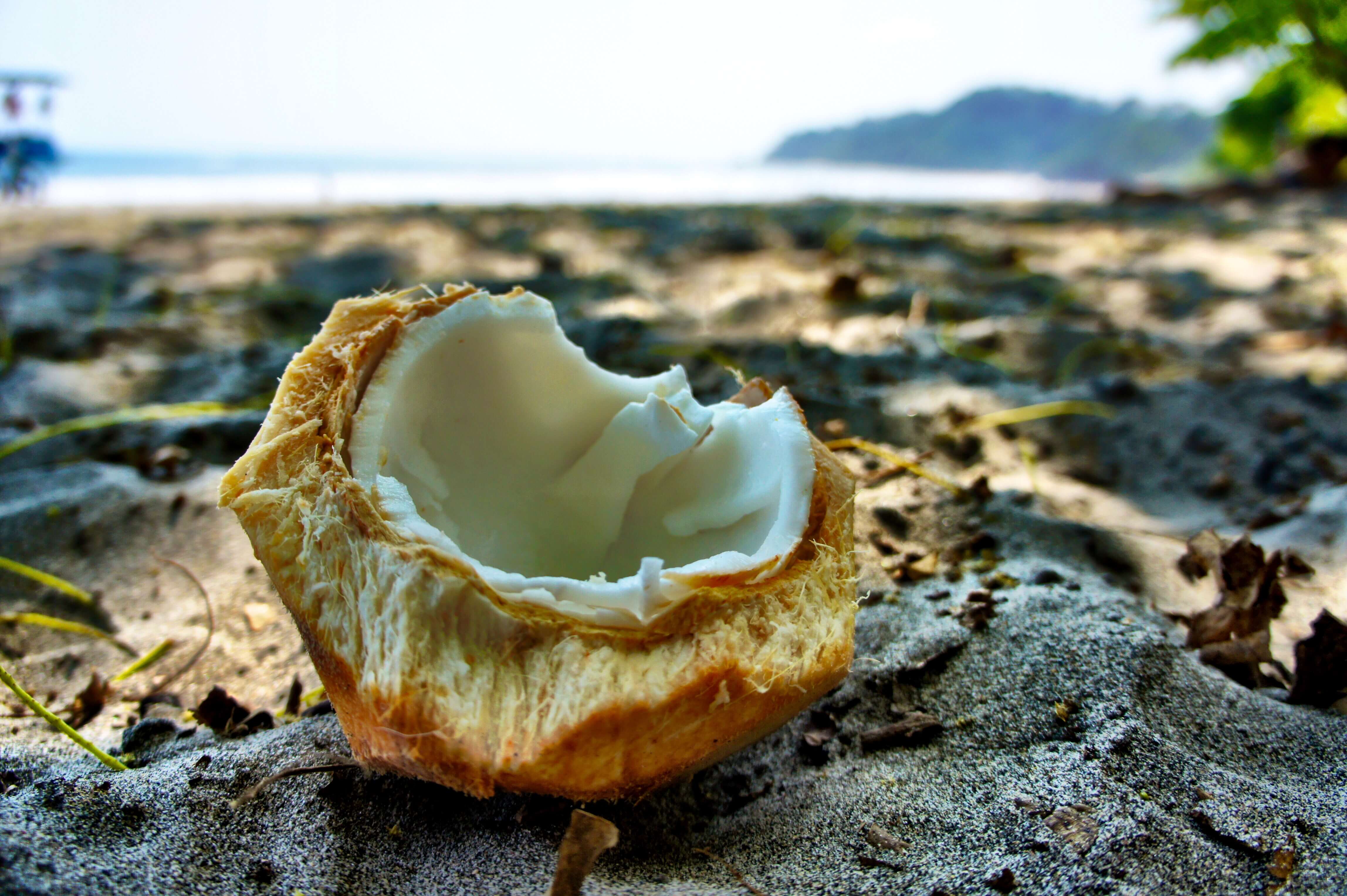
It can be become quite the chore to get it yourself but fortunately for you, there are professionals all around.
Purchase your coconut ('pipa', in Spanish) from a vendor and then sip on the water. When you're done, ask the vendor to cut it in half for you.

Grab a spoon and enjoy the meal.
3. Affordability
Often times, traveling outside of the United States can be super expensive. But it's actually relatively cheap to fly to Costa Rica.
A simple search online (google.com/flights) while I'm writing this shows me round trip tickets from Los Angeles to San Jose, Costa Rica for $360, only $271 from Miami, and as low as $260 from Atlanta.

Not only is getting here affordable but lodging is reasonable as well. Hostels right on the beach are $15-$25 per night, while a standard hotel room will run you between $50-$80... which is not a bad price to pay for paradise.
But it doesn't stop there. Transportation within cities is often less than a dollar, and you can even hop on a local bus to another city for a few bucks. Or take a flight with the world's only carbon-neutral airline, Nature Air . They fly to over a dozen locations in Costa Rica and are very reasonable.
Hack: Live in Paradise
Living here is affordable too. I've paid as little as $250/month for a brand new living space complete with a huge outdoor kitchen and yoga deck. Combine that with getting my groceries delivered by a local farmer for less than what I'd pay in the States and my total cost for food and lodging is about 1/8th of what I was used to shelling out every month. That means I could quadruple my cost of food and lodging here and it would still be half of what I was paying in San Diego.
So, perhaps it's time for an extended vacation?
4. Beach Life

Have you ever seen the jungle and the beach collide? It's incredible. But there is more than seeing the green jungle meet the turquoise ocean...
The ocean water temperature averages between the high 70s & mid 80s which means it's always the perfect temperature to swim in. It's also famous for surfing and even if you've never even been on a board, it's a great place to learn how to surf.
But one of my favorite reasons to visit Costa Rican beaches is how few people there are. Most beach destinations are packed with people and you're lucky to find several square feet of sand to temporarily call your own.
Not here. There are so many miles of beach terrain to explore you will likely find yourself staring at one of the most remarkable things you've ever seen asking yourself, "Where is everyone?"
Even the most popular beaches have far less people than the well known spots in Southern California--and if you take the time to talk a quarter mile away from the crowd, you will find even more more space.
Hack: Visit Best Beach in Costa Rica

Costa Rica boasts some of the best beaches in the world... so how do you choose which one to go to?
Under30Experiences did the research and published The Best Beach in Costa Rica so you didn't have to visit every beach to figure it out (although, that wouldn't be a mistake).
The results showed Manuel Antonio beach in Costa Rica was frequently voted the top beach and it actually recently ranked as 1 of the top 15 beaches in the world .
It's located just 2.5 hours from San Jose and is near other popular tourist destinations like Jaco, Playa Hermosa & Arenal.
Bonus Hack : Under30Experiences has a trip to Manuel Antonio priced at a crazy low rate of $645 for 5 days/4nights.
5. Biodiversity

Even though Costa Rica only takes up .03% of the world's land mass, it hosts an astounding 4% of the total species found on the planet!
According to the National Institute of Biodiversity, there are more than 500,000 species and--in an effort to protect them--more than 25% of the land in Costa Rica is protected. Which, as you probably know, is very rare these days given the amount of deforestation happening on a regular basis.
There are even hundreds of species in Costa Rica that you literally can't find anywhere else on the planet...including the Scarlet Macaw. It is a place where Earth still feels wild and--in a strange way--makes you feel right at 'home' in the nature of the jungle.
Hack: Get Up Close & Personal With A Sloth

I told you there was a sloth hack coming.
People from far and wide travel to Costa Rica in the hopes they will catch a glimpse of these magical animals but they're not always in luck. It is the essence of the sloth to move slowly and remain undetected by their eagle predators in the sky so it can be very difficult to spot them with an untrained eye. Even if you are lucky to see one, they'll likely be off in the distance and high up in a tree.
Fortunately for you, we have a way to get you up close and personal.
Kids Saving The Rainforest is a nonprofit organization (started by kids!) located just outside Manuel Antonio, Costa Rica and they're dedicated to protecting the biodiversity in Costa Rica. They have orphaned 3 sloths and on their Wildlife Tour you get to see them face-to-face.
6. Pura Vida Vibe + Culture

Literally translated into English, Pura Vida means pure life but in Costa Rica, it is a way of living.
At its best, the Pura Vida lifestyle will have you slowing down, relaxing on the beach, and wondering what it was you always felt rushed to do back at home. At its worst, you find yourself unable to get out of your hammock and actually do anything at all.
Costa Rican culture is welcoming, kind, & attractive. It's also one of the only countries in the world with no standing army which, ironically, makes you feel pretty safe.
Hack: Get Cultured
One of the most important things you can do while traveling is learn about the country you are visiting.
What is the history? What are the people like? Where do the locals hang out?
Avoid posting up at an all-inclusive resort and sipping on Mojitos all day. Instead, immerse yourself in what it's like to spend a day in the life as a Costa Rican and gain a true sense of the Pura Vida vibe.
After all, it is the Ticos & Ticas (name for Costa Ricans) that founded this way of living and there is a lot to learn from it.
Now that you know some of the top reasons you should visit and how to make the most of them, you are officially ready to take a trip to Costa Rica.
Do you have another favorite spot or questions about Costa Rica? Drop a line in the comments!
P.S. Besides our trip to Manuel Antonio , we adventure to Arenal where we stay at at eco-resort and hike a volcano. It's epic.
More Popular Posts

10 Days in Thailand: My Group Travel Recap

8 Days in Colombia: A Recap

84 Solo Travel Safety Tips for Every Traveler

Current Trips on Sale
.webp)
Mexico City
.webp)
LOOKING FOR A SWEET TRAVEL DEAL?
Follow the adventure, as seen in....

Quick Links
© 2012-2024 Shadow Concepts LLC. All rights reserved. “Under30Experiences,” “U30X” & all associated proprietary marks are trademarks of Shadow Concepts LLC & its related entities. Other third-party trademarks are the property of their respective owners. Privacy Policy | Terms of Service

Quick Travel Trivia Costa Rica

Costa Rica is a travel bloggers dream destination. Canadian travelers can visit Costa Rica without a visa and it is a hub of natural wonders. Take a flight […]
Copyright © 2019–2024 TAH Media & Consulting . All Rights Reserved.
Privacy Overview
Costa Rica: A Top Travel Destination for Adventure, Rainforests and Relaxation with Javier Echecopar All the Hacks with Chris Hutchins
#157: Costa Rica expert Javier Echecopar shares the amazing experiences the country has to offer. He provides insider tips for the ideal times to visit, where to find the best beaches, mountains and wildlife, and different adventurous activities like visiting the Arenal volcano. He also offers recommendations for food, unique lodging, the best ways to get around the country, and much more. Javier Echecopar is a co-founder of Journey Costa Rica, a travel company dedicated to creating high-end travel experiences in Costa Rica. He has over 15 years of experience in luxury adventure travel, including founding his own photography-focused travel company in Chile and 11 years working in multiple positions for Abercrombie & Kent. Link to Full Show Notes: https://allthehacks.com/javier-echecopar-costa-rica Partner Deals Vuori: 20% off the most comfortable performance apparel I've ever worn Gelt: Skip the waitlist on personalized tax guidance to maximize your wealth For all the deals, discounts and promo codes from our partners, go to: allthehacks.com/deals Resources Mentioned Javier Echecopar: Journey Costa Rica | Instagram | LinkedIn Things to do in San Jose: Coffee Tours Sikwa Restaurante Museo del Oro (Gold Museum) Museo Nacional de Costa Rica (National Museum) Costa Rica Domestic Airline: SANSA Volcano: Arenal Volcano Tidal Pools: Santa Teresa Best Wildlife: Osa Peninsula Sloth Tour: La Perica Tallest Mountain in Costa Rica: Cerro Chirripó Hiking Trail: Camino de Costa Rica Loding: Unique Experiences: Pacuare | Tabacón Coffee Farm and Inn + Coffee Tours: Finca Rosa Blanca Best Eco Lodges: El Remanso | Lapa Rios Fundación Bosque Vivo Full Show Notes (02:02) How to Structure Your Trip to Costa Rica (06:24) Unique Lodging in Costa Rica (09:43) Best Times to Visit Costa Rica (12:24) Misconceptions About Costa Rica (14:53) The Food in Costa Rica (16:21) Traveling to Costa Rica with Kids (19:15) Getting Around Costa Rica: Transport & Guides (23:19) Flights to Costa Rica (24:45) Things to Do in San Jose (27:45) Types of Adventures in Costa Rica (30:14) How to Spend Time Around the Volcano (32:23) Beach Lodging (37:08) Using Taxis in Costa Rica (39:40) Beach Activities (40:57) Wildlife in Costa Rica & Osa Peninsula (45:14) Hiking, Mountains & Waterfalls in Costa Rica (47:08) Journey Costa Rica Connect with All the Hacks All the Hacks: Newsletter | Website | Membership | Email Chris Hutchins: Twitter | Instagram | Website | LinkedIn Editor’s Note: The content on this page is accurate as of the posting date; however, some of our partner offers may have expired. Opinions expressed here are the author's alone, not those of any bank, credit card issuer, hotel, airline, or other entity. This content has not been reviewed, approved or otherwise endorsed by any of the entities included within the post. Learn more about your ad choices. Visit megaphone.fm/adchoices
- Episode Website
- More Episodes
- 2023 - Chris Hutchins - 606750
- Enter Costa Rica
- Travel Guide
- Packing List
The Essential Costa Rica Packing List
We are often asked, "What do I need to pack for Costa Rica?". Since 2007, our Costa Rica packing list has evolved and adapted with new technologies such as microfibers, digital cameras, no international transaction fee credit cards, and more. We jokingly always say, "Most importantly, bring your passport and bathing suit" but here's the rest of the list...
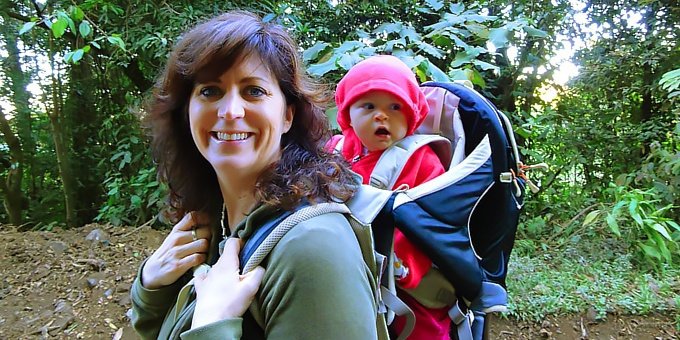
Free Vacation Planning
Click here to see a comprehensive Costa Rica packing checklist.
Note that we are affiliated with Amazon and other companies, so many links on this page will take you to products that we have personally tried and recommend on the these websites as well as some that we are not affilliated with.
The Essential Items That You Must Remember to Bring to Costa Rica
Valid Passport: United States and Canadian citizens must bring their original and valid passports to enter Costa Rica. Your passport cannot expire before or during your trip. A visa will be issued to you on arrival. Some other countries have different arrangements with Costa Rica and you may need to arrange for a visa in advance. Check with the Costa Rican consulate If you are coming from another country. Photocopies will not work to enter Costa Rica, though it is a good idea to take a copy and keep it on your person while leaving your original in your hotel's safe deposit box after arrival.
Credit cards: If you do not already have one, prepare in advance and get a no-foreign transaction fee credit card. Some of the better cards we have found include Capital One Venture cards and the Chase Sapphire Preferred card . Also, keep in mind that Visa and MasterCard are widely accepted in Costa Rica but American Express and Discover are rarely accepted . You will also want to bring your debit card as some smaller businesses only accept cash and you'll also need cash for tipping guides and drivers. A word of advice; check your credit card's or ATM card's international fees before visiting Costa Rica to avoid styeep international fees and also to inform them of travel abroad.
Driver's license: If you intend to rent a car, you'll need your original state-issued driver's license. Photocopies will not work!
Return flight ticket or proof of onward travel: You cannot enter Costa Rica without a return flight ticket or valid and verifiable proof of onward travel. Often, immigration officers will require a flight ticket, so be ready!
A copy of your reservations: Costa Rica is currently in a state of change and Pacific Trade Winds is helping to usher this along! Some hotels, tour operators, rental car agencies, and transportation companies require you to provide them with a copy of your reservation, which is often in the form of a voucher. We highly recommend printing a copy of your schedule and vouchers or reservation details to provide to them. We also recommend printing as cellphone or internet outages are quite common. With a printed version, you will always be able to partake in or stay where you have booked. We are working hard to usher the changes to a digital vouchers, but unfortunately, some providers still lag behind technologically.
Trip insurance: Trip insurance is a safety net for your travels in Costa Rica and is highly recommended. Our clients have done well with EKTA Trip Insurance and we have also received positive feedback from those who have purchased plans from Travel Guard, and InsureMyTrip.
Personal Items You Must Pack for Costa Rica
The essential personal packing list for Costa Rica includes everything listed above, practical footwear for where you will be visiting, fast-drying clothing, swimwear if you plan to visit a beach or swim in a pool, socks and underwear, rain jacket or poncho, sunscreen, insect repellant, a hat to ward off the tropical sun , sunglasses, emergency medical kit and any medications you require, your phone and accessories, a good camera and accessories, toiletries, and a good backpack or daypack.
Clothing to Bring and What to Expect
Costa Rica, in general, is a very casual country. Few restaurants have dress codes and that includes some of the most luxurious resort restaurants in the country but be sure to check with any high-end restaurants before leaving your dress clothes at home. Temperatures, humidity, and rain vary significantly across the country, so be sure to study the expected weather of where you will be traveling before you go. Also note that while temperatures do not vary significantly year-round, rainfall does. Typically, the variation of temperatures varies by elevation. Daytime temperatures for nearly all beaches in Costa Rica average around 85-95 degrees F and nighttime temps are usually around 70 - 80 degrees, while high-elevation destinations such as Monteverde, only reach the mid-70s during the day. Also, note that women can show their shoulders in nearly every setting while men should wear pants in the cities (not tourist destinations).
Fast-Drying Or Wicking Clothing
Regardless of where in Costa Rica you will be visiting, fast-drying or wicking clothing is essential for most travelers to Costa Rica. The heat, humidity, and precipitation can take their toll and you don't want to add in another level of discomfort by dressing in non-wicking clothing that stick to you and are simply uncomfortable. Amazon Essentials for men and women offers quality options, though we also wear and sometimes prefer North Face , Columbia , REI, Eddie Bauer , etc. Note that some of these links are to directory pages which may give results that are not wicking. Any wicking or fast dry clothing will detail that in the listing.
Convertible Pants
Convertible pants may not have the appeal or style you are seeking but may end up being the most practical items in your suitcase! They allow you to unzip the lower legs turning them into shorts or you can add them back on for hikes or cooler weather. We love our North Face convertible pants for men and women . Columbia also offers a more affordable but still high quality version for men and women .
Dressing for the Beaches
Your wardrobe should consist of wicking or fast-drying shorts and tee shirts, long-sleeve sunblocking and wicking shirts for men and women , shorts (and long pants, if you plan to hike in a national park or other. Convertible pants, are great!), bathing suit, flip flop or sandals (closed toed shoes for hiking), and a sarong can have many purposes at the beach.
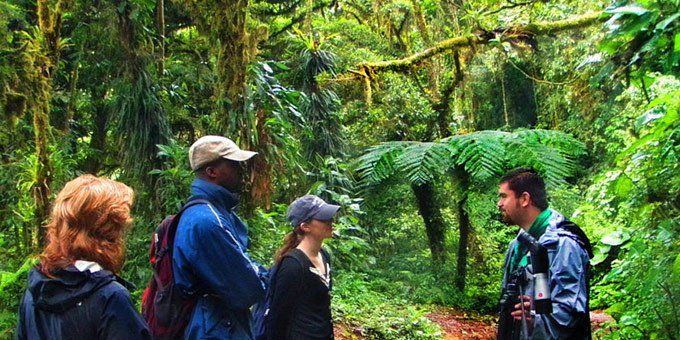
What to Bring for the Mountains
If you are visiting a highland destination such as Monteverde or San Gerardo de Dota, you'll want to also bring warmer clothing such as long-sleeved wicking shirts, pants (convertibles are great), closed-toed trail shoes, or possibly even boots. You may also wish to bring a sweatshirt or light jacket, though a long-sleeved shirt and a rain jacket will suffice. We dive further into the details later in the article when we discuss recommended packing lists for specific destinations.
What We Recommend: Our closets are full of wicking clothing and convertible pants . While the convertible pants are not exactly the most stylish, they are very practical and can get you through a day of exploring without changing. Some of our favorite brands include Columbia, North Face, Eddie Bauer, REI, and other outdoor wear brands.
Footwear and Shoes
You'll want to bring flip-flops or sandals for the beach but you may also wish to bring them if you plan on visiting hot springs or swimming in the resort pool, below a waterfall, etc. You'll also likely want to bring hiking or trail shoes for any walks in the jungle, national parks, etc. When considering which shoes to buy, look for fast-drying synthetic and waterproof materials. I typically always have a pair of each in my car, ready for any occasion. Remember that you will need closed-toed shoes for any night hike and they are strongly recommended for hiking.
What We Recommend: Merrell , Keen , and Soloman all offer high-quality trail running shoes. Keen also offers high-quality hiking sandals that are great for light hikes, rafting or tubing, ziplining, canyoning, etc. Keep in mind that most activities like this require closed-toed shoes . Your favorite flip-flops will suffice for the beaches but if you'd like a recommendation, I always look for flip flops that contour the shape of my foot, with arch support, and offer cushioning for my heels. Skechers , Clarks , Oofos , and even some of the higher-end Reefs match this description. Note that these links go to search pages, so there may be products that do not offer arch support. All listinghs will mention if there is arch support.
Sunscreen or Sunblock
While you can find sunscreen and sunblock in Costa Rica, it is expensive and you'll often have difficulty finding specific brands. Costa Rica is near the equator, so direct sunlight will burn you faster than at home - at least for most. Bring sunscreen in at least SPF 30 or higher, if you burn easily. Don't forget to reapply often! You'll also want to consider bringing aloe for aftercare as you will likely burn at least a little, especially at the beaches.
What We Recommend: If you plan to bathe in natural areas such as below waterfalls, river pools, natural hot springs, freshwater lakes, or the ocean, we strongly recommend buying reef-safe sunscreens such as Reef Repair, Sun Bum, or Thrive. If we all do our part, it adds up! Also, don't forget your lips! Bring along some lip balm with SPF .
Insect Repellant
Mosquitoes are present year-round and you will want some form of repellant for all beaches and low and rainforests. Aside from simply being a nuisance, Dengue is present in Costa Rica. Similar to sunscreen, while repellant is available in Costa Rica, it is expensive and often difficult to find, especially for any specific brand.
What We Recommend: I personally use 100% DEET repellants and it is highly effective. You can also select lower-level DEET products such as Repel or Deep Woods OFF. Alternative repellants include Avon Skin So Soft , which works great for pesky beach gnats or products with picardin, such as Sawyer Picardin Insect Repellant . There is also some clothing with built-in insect repellent .
Rain Jackets & Protection From the Rain
Most of Costa Rica is in the tropical rainforest, so matter when or where you travel to in Costa Rica, we recommend being prepared for the rain with either a rain jacket, poncho, or a small collapsable umbrella . Be sure your rain jacket or poncho is actually waterproof and it's still a good idea to treat your jacket with waterproofing spray ahead of your trip. A quality rain jacket can also double as a regular outerwear jacket in cooler areas such as Monteverde. A compact umbrella is a good alternative or addition, especially for photography in the rainforest.
What We Recommend: I spend a lot of time outdoors and love my Gore-Tex rain jackets ( women's here ), though they are quite costly for anyone who does not spend a lot of time in the elements. Gore Tex is not only highly water and wind resistent but also breethable, which is nearly a necessity in hot tropical climates. I also own a lighter North Face rain jacket that folds down nicely in a backpack. Whatever you choose, be sure to get a jacket with a zipper and that offers ventilation as it can get quite hot and humid when wearing a rainjacket in a tropical climate!
Medication and Toiletries
You'll want to bring all the toiletries you use at home but you can save space and weight by packing some things that are easily available here in Costa Rica. Some of the easier items to find include toothbrushes and toothpaste, mouthwash, floss, deodorant, shampoo and conditioner, and soap. Do keep in mind that specific brands are often difficult to find, so if you are particular about the brand, consider bringing it with you. Items we recommend packing, that are difficult to find include tampons or pads for women, any kind of hair gel or detangler, bandaids and antibiotic ointment, face wipes, and tissues.
If you wear contact lenses, be sure to bring extras (you'd be surprised at how many requests we have from clients who lose them in the ocean or during travel), contact lens solution, and cases. Disposable lenses are not common in Costa Rica and you will have difficulty finding them or the solution.
Consider bringing a form of anti-nausea medication for the long and windy drives or if you plan to go fishing or out at sea. If you forget to bring it or learn the hard way that you should have, you can usually find it at most farmacias.
Be sure to bring sufficient medications for your entire trip but also a few extra day's worth as delays can occur. You'll also want to write down a comprehensive list of all medications, and if possible, the active ingredients as there are often different name brands in Costa Rica.
Where to Find Toiletries and Medications in a Pinch
Pharmacies (or farmacias ) can be found in nearly all medium to large size villages and cities, though are not common in smaller villages. You can buy most toiletries and over-the-counter medications there. While we strongly recommend visiting a traditional doctor if you are sick, farmacias also often double as a makeshift clinic, and often, the pharmacist can prescribe some basic medications and antibiotics.
For basic aspirin, cold or flu medication, or diarrhea, you can often find options in local supermarkets, though we do not recommend passing by a farmacia, if one is available.
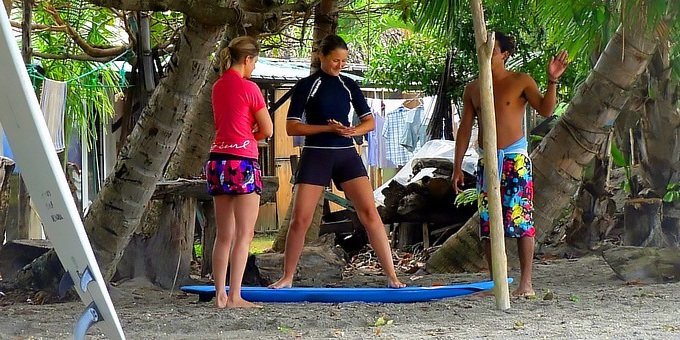
Additional Considerations and Things You Should Bring to Costa Rica
Day bags or backpacks.
While a quality day bag or backpack is not as essential as your clothing, they are not too far behind if you plan on doing anything outside of a resort. Do not make the mistake of underestimating and bringing a low-quality drawstring bag, as you will likely regret it! A quality backpack will allow you to take a day trip without returning to the hotel and bring extras such as water, snacks, a change of clothes, a camera, etc..
What We Recommend: You can get away with a 20-25 liter backpack for short day trips and light hikes. For longer hikes or simply longer days away from the hotel consider a 30 - 40 liter backpack. I personally love my Osprey 30L backpack for day trips carrying my own gear, while I prefer my Osprey 40L when I carry my family's load. The thing I love about Osprey is they are high quality and lightweight, ideal for hiking. If you are traveling during the rainy season, you will want to either bring a rain cover for your bag or bring a waterproof backpack. I personally love my Columbia Convey 30L waterproof backpack .
Photographers will want to bring a specialty backpack that fits your camera and all of your gear. I love my TARION Pro Camera Backpack as it allows me to compartmentalize everything snugly and I can also strap my portable tripod, which I also love and highly recommend, onto the side.
An anti-theft bag is also a practical investment if you plan to visit any of the cities. Sherpani offers several bags to choose from.
We also love the new AiRunTech Waterproof Pouches for storing phones, wallets, keys, and the small valuables you can't leave the hotel without, but are difficult to hold onto when you are swimming or partaking in other simiar activities.
Hat and Sunglasses
The tropical sun is stronger than most visitors realize and due to that, we highly recommend bringing a good pair of sunglasses and some cheapies for the beach . We recommend the cheapies for the beach as lenses tend to be created in the sand or even in the saltwater. While it's not a necessity, I personally prefer polarized, anti-glare glasses .
A broad-brimmed hat or visor is also a sound investment to protect your face and neck from the tropical sun. They are also nice to have in the rain.
Technology & Cameras
Don't make the same mistake I made many years ago on my first trip to Costa Rica - not bringing a good camera. I thought that with all of the adventures, a good camera would just be ruined, and I ended up with a bunch of lousy pictures after many amazing experiences... I should have brought the camera and formulated a plan to protect it and use it. I previously mentioned that you will want a good camera bag, regardless of what kind you have. Consider the camera itself, the accessories, protection, and how you will use it.
A GoPro camera is practically a necessity if you'd like to record action videos. Also, consider mounting brackets for whatever use you have in store. AKASO offers an affordable alternative to the costly GoPros .
Photographers with DSLR cameras will want at least a 300 mm lens for birds and wildlife. A 600 mm or even higher is not unheard of for catching beautiful, detailed pics. This is an affordable and popular package . Note that warranties are unavailable for some package deals, so be sure to do your homework before purchasing.
We love our Nikon Coolpix P1000 as a point-and-shoot , with a 3000mm super-telephoto lens. It's quite versatile and easy to pack along. We take thousands of photos for our content every year, ranging from hotel pics to monkeys leaping through the canopy to gorgeous resplendent quetzals, and everything in between. We've found the P1000 to be our go-to camera for most scenarios. This is a popular package deal fior the same camera .
Whatever you do, be sure to bring plenty of extra batteries, SD cards, and any accessories you may need. Many people underestimate the need for a tripod when shooting wildlife pics, especially for birds. I absolutely love my TYCKA 56” Camera Tripod , which can easily be packed for day trips and is quick and easy to fold down or set up.
Electrical Adaptor ( if coming from a country other than the US ): Costa Rica uses the same 110 volts as the United States but if you are coming from another country that uses a different voltage,. you will want to bring a universal power adaptor.
Battery Bank & Charging Cables : Power outages are common in Costa Rica, as are long drives. A battery bank will get you through some of those moments when you want or need power, especially to charge up a cell phone or laptop. I also always have extra charging cords as they can be difficult to find here and are often forgotten at hotels.
Headlamps and Flashlights : As previously mentioned, power outages are frequent in Costa Rica, so even if you are not going on a night hike, you should consider bringing a headlamp or flashlight. If you plan to go on a night hike, bring a headlamp with a red beam. The red beam is a requirement for all turtle nesting tours (at least if you plan to use a light) and they are easier on the eyes of animals when you are viewing them.
Waterproof Phone Case : Waterproof phone cases are a great alternative to costly GoPro cameras, though we recommend getting one with a strap and impact absorption as (I can assure you) wet phones are easily dropped. Note that these cases are often only good up to around 10 feet and are not recommended for scuba diving.
More Ideas for Things to Bring to Costa Rica
Some of the following may be necessary for you or not applicable at all, but we wanted to provide a comprehensive Costa Rica packing list that everyone can use.
A small first aid kit that includes band-aids, antibiotics, aspirin or pain reliever, and medication to treat diarrhea.
Ziplock bags ! This is one of my favorite Costa Rica travel hacks as it allows me to separate what I pack and the freezer-size bags are ideal to keep in my backpack in case you get stuck in the rain.
Collapsable hiking poles if you intend to hike. I love my poles that double as a monopod for a camera .
Makeup, a travel-sized hairdryer , and hair ties. Keep in mind that most Costa Rican hotels do not offer hairdryers.
Laundry bag and dryer sheets: You'll want to keep your dirty clothes well separated and with the tropical, humid climate, use dryer sheets to minimize the smell...
Sleeping medication, ear plugs, or visors: Little things like this can easily be forgotten and quite difficult to find in Costa Rica. If you normally use them, don't forget to bring them.
Costa Rican Spanish phrasebook or app : This will help you communicate and while most tourism professionals speak English, a phrasebook can get you through a pinch when the unexpected, such as a flat tire occurs.
Insulated water bottle : Tap water is safe to drink in most areas of Costa Rica. By using a reusable water bottle, you'll not only save money but will also reduce the impact of discarded plastic water bottles. I love my Hydro Flask for the aforementioned reasons and also because I load it with ice and can have cool, refreshing drinks, all day long. Trust me, that is a luxury on a 90-degree day!
Phone accessories : Don't forget to bring your charging cords for both walls and in the car. Additionally, if you plan to rent a car, bring along your car cell phone holder. These things are all difficult to find in Costa Rica.
Wildlife guide: The Costa Rica Wildlife Guide by Rainforest Publications is great! It covers all of the popular animals and most that you will find on your own. We always bring along an erasable marker for checking animals off each trek.
Map of Costa Rica: Toucan Maps publishes the best map of Costa Rica! It's not only great to have for navigating but also an indispensable planning tool.
Microfiber towel : A microfiber towel is not only great for wiping yourself off but also a great cooling tool to wrap around your neck in hot weather.
Laundry bag : You will definitely want to keep your dirty clothes separate!
Binoculars or monocular : You'll want to see the faces of the sloths and monkeys on the trees. I found a monocular to be easier to use on an African safari and found it to be just as good for the wildlife of Costa Rica. The added benefit to a monocular over binoculars is that it is much more compact in your day bag.
Recommended Luggage
Large bags & checked in luggage.
We travel throughout not only Costa Rica but also to many countries across the globe. Over the years, we've fine-tuned our luggage to the SwissGear brand . They are rugged and dependable. We have both hardside and softside bags. If you are new to the travel game, be sure to get (checked bags) bags with 4 rollers as they are much easier to maneuver. Amazon Basics offers a good, affordable alternative.
Carry-On Luggage
Similar to our checked bags, we love the SwissGear carry-on bags as well. Be sure to get a larger carry-on. We only take carry-ons on shorter trips and always appreciate the space allowing us to pack them tightly. For most airlines, the limit is a combined length, width, and thickness measurement of 45 inches. This often comes in the form of a bag that is somewhere around 22 inches long, 14 inches wide, and 9 inches high or a 1 or 2-inch difference off of those measurements. Check with your airline for their measurement thresholds. Amazon Basics offers a good, affordable alternative.
Luggage Sets
As you may already suspect, we recommend SwissGear luggage sets . Amazon Basics has upped its game in recent years and is worth a look as well.
Things You Should NOT Bring to Costa Rica
Fashion or designer clothing unless you have planned a special event or arranged for a formal dinner.
High heels unless you have a special event planned
Flashy jewelry - and also, do not ever leave jewelry out in a hotel or Airbnb. Always be sure to use your room safe if you are not wearing your jewelry.
Flashy or designer purses - you'll wish you went with something more practical.
Heavy hiking boots - they get bogged down in the jungle and often become more of a nuisance or hindrance. Check with your guide first and most will recommend trail runners or hiking sneakers.
Rain boots - they are easy to find, cheap down here, and you can donate them to a local when you're done. Save the space for what you will really need.
Large laptops unless you must. Most room safes will not accommodate a laptop with a monitor over 15 inches. Some cannot accommodate anything larger than an iPad. Be sure to check with your accommodation before bringing your laptop. Many unprepared travelers have unfortunately lost their laptops due to not being able to store them properly.
How to Pack For Costa Rica's Rainy Season
The rainy season on the Pacific slope of Costa Rica typically runs from May through November, though do keep in mind that September and October are the months with heavy rain. The Caribbean slope of Costa Rica has opposite weather patterns and September and October are actually the driest time to visit this region.
Packing for the rainy season is actually quite similar to the dry season, though be sure to bring a good rain jacket or a quality poncho, long pants (wicking convertibles are great!), a sweater or sweatshirt and a jacket (a quality rainjacket and a sweatshirt is a great combination), long sleeve wicking shirts, wicking outdoors or hiking gear, good trail or hiking shoes (lightweight waterproof is better and consider bringing an extra pair if you plan to do a lot of hiking), extra socks as they will get wet, a waterproof backpack or a waterproof cover for it.
How to Pack for Costa Rica by Popular Destinations
Packing for la fortuna and arenal volcano.
This region can be fairly hot (often daytime temperatures reach the mid to upper 80s in the dry season and upper 70s to lower 80s in the rainy season) and humid, with readings in the upper 90s. The Nuevo Arenal and Lake Arenal region, while close by, is usually cooler by 5 - 10 degrees, and windier. Many do not realize this, but this region is on the Caribbean slope of Costa Rica but right next to the middle. It can be affected by weather patterns from both the Caribbean and Pacific slopes but is more reliably affected by Caribbean weather patterns. Still, for both regions, you can nearly always get by with shorts and tee shirts but be sure to have brands that wick. Hiking sandals or regular sneakers are ideal footwear for going around town but you'll want different shoes for various activities. I love my convertible pants for this area and regularly remove or add back the legs.
Ziplining: Closed-toed shoes are recommended. Most will permit sandals with straps but flip-flops are not permitted. Wear wicking, adventure clothing.
Rafting or canyoning: Closed-toed hiking sandals or water shoes are best (and often required), such as Keens or Tevas. Always wear wicking outdoor gear for these adventures as you will get wet!
Hiking: Trail running or hiking shoes are ideal for hiking. Waterproof is better year-round but an essential in the rainy season. Whatever you do, be sure to have closed-toed shoes for any hikes but know that they are required for night hikes.
*Sarapiqui has similar weather patterns as La Fortuna, though it is usually a few degrees warmer.
What to Bring to Monteverde and Other Cloud Forest Destinations
Costa Rica's cloud forest destinations sit at higher, cooler, and damper areas. They are in the clouds after all! These areas are much cooler than the sea-level beaches. daytime teams are usually in the 70s, though it is not uncommon for temps to not exceed 65 degrees, especially during the rainy season. Often, nighttime temps are in the 50s and 60s. Also, keep in mind that these areas can often be windy, so you'll want to bring long-sleeve wicking shirts, sweatshirts or sweaters, a good rain jacket or poncho (not the cheap brands), and pants. Similar to the Arenal region, I love my convertible pants in this area.
Popular Activities: For ziplining, you'll want closed-toed shoes. For hiking in the reserves or at the hanging bridges, you'll want waterproof and closed-toed trail or hiking shoes. Some reserves offer rental rain boots. Be sure to check with the reserve you will be visiting as you do not want to make a mistake with footwear.
The Central Pacific Coast (Manuel Antonio & Jaco)
This area is hot and humid with daytime temps usually in the upper 80s to lower 90s and humidity in the upper 90 percentile. You'll want to bring all of your beachwear, sunglasses, sunscreen, hat, and insect repellent. Adjust your packing to the activities you will partake in as well as your dining (nearly all restaurants in these areas are informal but be sure to check before coming).
The South Pacific and Osa Peninsula (Drake Bay, Puerto Jimenez, Corcovado, Dominical, Uvita, Ojochal)
This area can be extremely hot and humid (usually in the upper 90 percentile) so be prepared with quality wicking clothing. It rains often, even in the dry season, and rains during the rainy season can be heavy, though often limited to the afternoon. You'll want to bring waterproof bags, especially for your camera gear, phones, etc. Some of the must-have items to pack include quality trail or hiking shoes, wicking clothing, extra socks, a waterproof backpack, insect repellent, a microfiber towel, sunscreen, a battery pack, swimwear, and a good sense of adventure! Many lodges on the Osa Peninsula do not have a reliable source of power and run periodically on generators. These lodges discourage using anything that requires power, so bringing that battery pack will allow you to keep your cell phone powered up.
*Keep in mind that mountainous areas near the South Pacific coast, such as Platanillo, will be cooler than the coast, even if they are just a few kilometers from the coast as the crow flies.
Bijagua and Rio Celeste
This area is extremely rainy, even in the dry season. Be prepared with good waterproof hiking shoes, wicking clothing, and if possible, a waterproof backpack, especially if you have a camera. This area is also usually fairly hot, with daytime temps often reaching the mid-80s, though it can be cooler at times, especially in the rainy season. A good rainjacket can double as a coat. The Tenorio National Park ranger station offers rental rain boots.
Guanacaste and the Nicoya Peninsula (Rincon de la Vieja, Papagayo, Conchal, Tamarindo, Nosara, Samara, Santa Teresa, etc.
This region is in the tropical dry forest and is very hot but not as humid as the rainforest regions of the Central and South Pacific. The further north you go, until you reach Papagayo, the drier it tends to be. While the rainy season is considered to run from May through November, the heavier rains are usually limited to September and October. Often rains in the other months of the rainy season are limited to overnight or late afternoon. Of course, there are exceptions and it can rain at any time, inclusive of the dry season. Be sure to pack your beachwear, sunscreen, insect repellent, sunglasses, and a hat. Protecting yourself from the tropical sun is paramount!
Packing For the Caribbean Coast (Tortuguero, Cahuita, Puerto Viejo)
The Caribbean coast has opposite weather patterns of the Pacific. September and October are the driest months, though it can rain at any time. No matter when you visit this region, you'll want rain gear, wicking clothing, swimwear (you can't swim on the beaches of Tortuguero but most lodges have pools), insect repellent, and sunscreen. Flip flops or sandals are great for walking around but you'll also want closed-toed shoes, especially if you plan to hike. You will also want a battery pack to charge your cell phone as power outages are common.
Abbreviated Packing Checklist for Costa Rica
Clothing for costa rica.
3-5 short sleeve t-shirts. Quick dry shirts are recommended
1-2 long sleeve shirts for protection from the sun or hiking through higher elevation forests
1-2 blouses or dress shirts
2-3 pairs of quick dry shorts for general use
1-2 pairs of dress shorts or tropical weight skirts
swimsuit and possibly a sarong
1 pair of casual dress pants
1 pair of long pants for hiking. TIP: Convertible pants are convenient and can reduce your packing as you can unzip the pant legs and use them in place of the general use shorts.
6-8 pairs of underwear
6-8 pairs of socks
rain jacket – It should be lightweight and breathable
brimmed hat for protection from the sun
nylon mesh bag for dirty/wet clothes
*Packing Tip : Rolled clothing condenses better than folded clothing.
Recommended Shoes to Pack for Costa Rica
hiking or walking shoes dependent on the level of activity in your vacation
sandals or flip flops
dress sandals or light dress shoes
You may also want to consider amphibian hiking shoes or reef/river sandals depending if you plan on doing land/water activities such as rafting or canyoning.
toothbrush with cover
shaving cream
antiperspirant
conditioner
Documents to Pack for Costa Rica
passport – and possibly visa, depending on your nationality. Click here for the Costa Rica Consulate
copy of your passport
drivers license
money – everybody accepts the United States dollar or you can exchange for Costa Rican colones. $20 bills are best as larger denomination bills are rarely accepted
credit or debit card
insurance card along with contact information
a card with emergency contact information for friends and/or family
departure ticket – without it, you will not be allowed to enter the country
any important health documentation
Maps and Books
map of Costa Rica – we recommend Toucan Maps
nature guide – we recommend The Wildlife of Costa Rica: A Field Guide by Fiona A. Reid
Spanish/English phrase book – we recommend Costa Rican Spanish: Lonely Planet Phrasebook by Thomas Kohnstamm
Miscellaneous Items
camera with carrying case, two batteries, charger, two memory cards
dry bag and/or a few Ziploc freezer size bags
water bottle
binoculars or monocular
flashlight and/or headlamp
container for your prescription or sunglasses
phone card or cell phone with a Costa Rica brand SIM card if you own an unlocked phone. If your phone is unlocked, get an eSIM
phone charger for use in your hotel AND rental car
light backpack for day trips
Internet logon information
Health Care and Basic First Aid
prescription medicine - You should bring the medicine with you as you may experience difficulty finding it here.
prescription glasses
contact lenses and cleaning solution
Imodium® for diarrhea
motion sickness medicine such as Dramamine®
sun screen – waterproof and at least SPF 20
insect repellant - Skin-so-Soft® works well for no-see-ums, 95% DEET repellant for mosquitoes.
pain relievers and or fever reducers such as Aspirin, Ibuprofen, or Acetaminophen
vitamins if you normally take them
face mask (personal decision)
hand sanitizer (personal decision)
So there you have it… Everybody has their own styles and plans, so use this as it is intended; a general packing list for Costa Rica. Take the ideas that apply to you and leave the rest. If you have any suggestions for our list, please send them for consideration.
Unsure of what to do? Let us make you a free custom trip plan!
Click here to see more results

FOR YOU, FOR FREE: 17 years' worth of firsthand Costa Rica trip planning and travel advice compiled into hundreds of articles, plus exclusive discounts. Created by a Costa Rican and a four-time published Costa Rica guidebook author. Welcome, amigos, and as we say in Costa Rica, pura vida!
Our 2023 Moon Costa Rica guidebook (third edition)
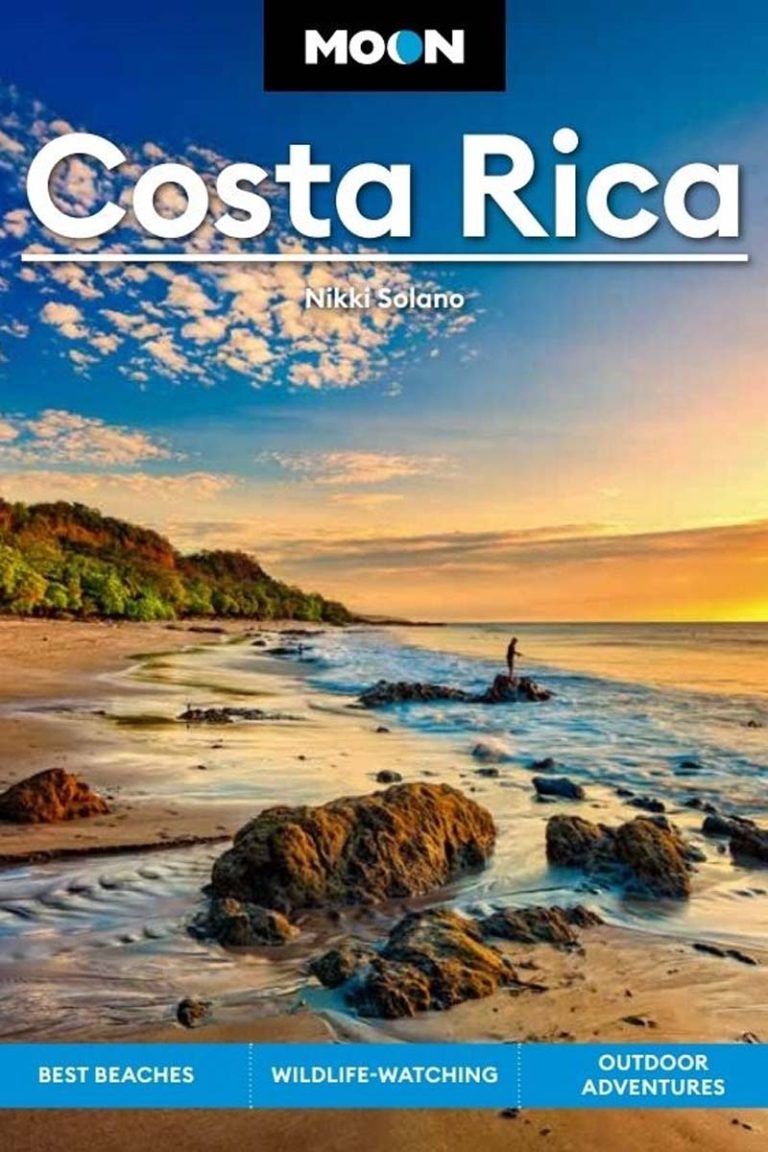
Our 2022 Moon Best of Costa Rica guidebook (first edition)
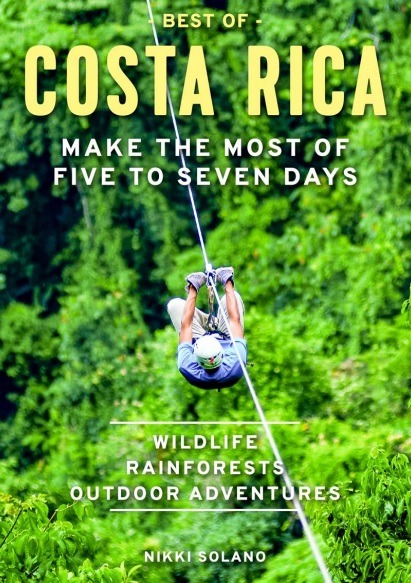
Our 2021 Moon Costa Rica guidebook (second edition)

Our 2019 Moon Costa Rica guidebook (first edition)
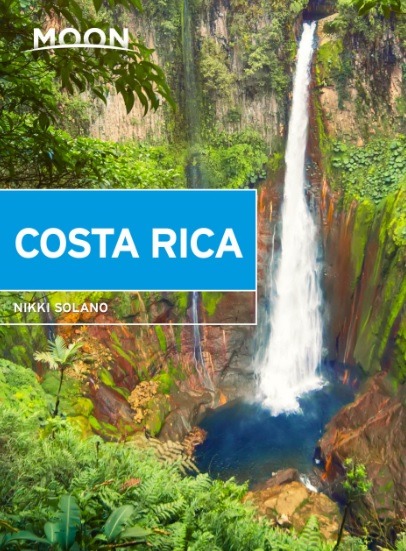
- Moon Travel Guides
- FREE DIY COSTA RICA ACCESS! Details here.
Our company is inclusive. Read our Anti-Hate, Anti-Racism, Anti-Xenophobia, Anti-Inequality, Anti-Discrimination Statement here.
NEW! Our awesome Costa Rica Destination Tool filters 66 destinations by nearly 150 criteria to help you quickly and easily decide where to go in Costa Rica according to your unique preferences, wants, and needs. Learn more and access the tool on our sister site, DIY Costa Rica, here.
What To Pack For Costa Rica (And What Not To Pack)
Home » Packing and Travel Prep » What To Pack For Costa Rica (And What Not To Pack)
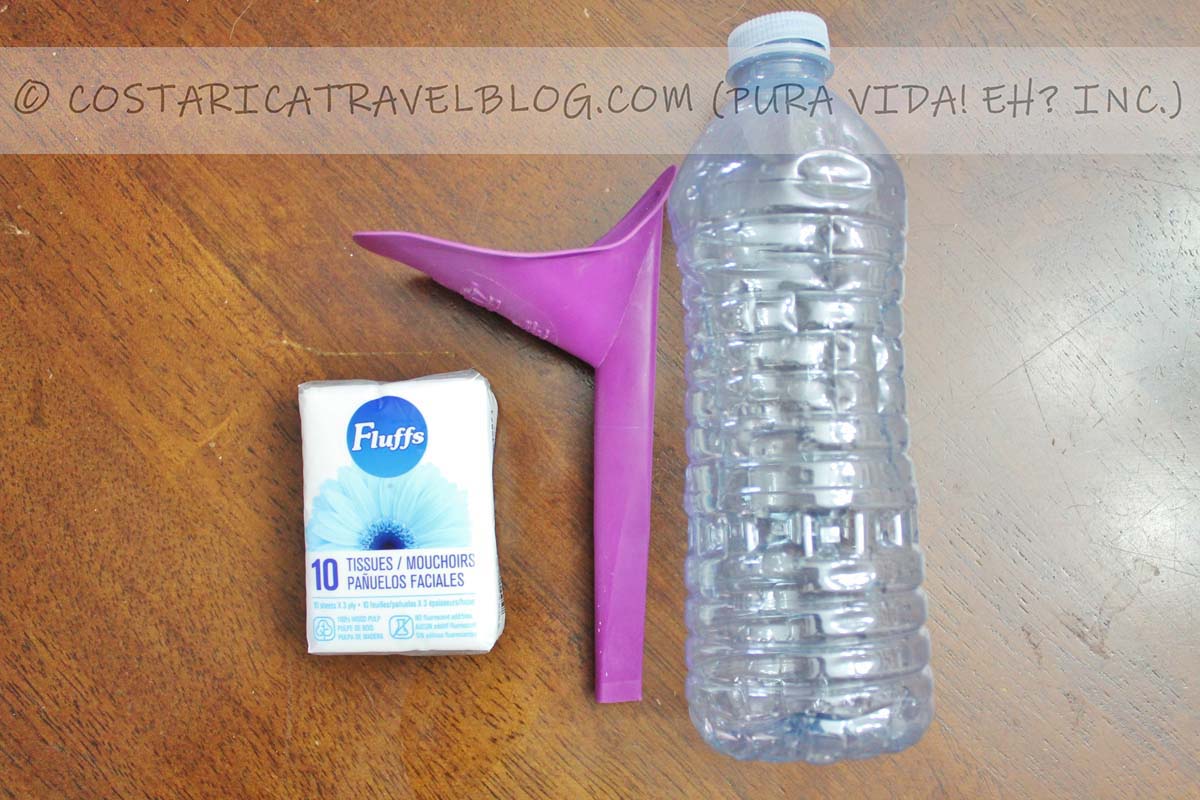
Last updated on September 17th, 2023 at 01:16 pm GMT-6 (Costa Rica time)

Written by Nikki Solano
Get the Costa Rica info you need by browsing our article's TABLE OF CONTENTS:
Packing for Costa Rica
Clothing / apparel, accessories and toiletries, electronics, safety/security devices, and other handy devices, identification and paperwork, miscellaneous, what not to bring to costa rica, don’t forget this….
If your Costa Rica vacation is just around the corner, you’ve likely shifted your focus from what you’re going to do in Costa Rica to what you’re going to need for the experiences . Alas, the journey of packing for Costa Rica begins. Bring on the contemplation about what to pack for Costa Rica, the over-analyzing of choices, and the packing and re-packing efforts. Or, if you’re the intelligent, defiant, short-on-time type, simply familiarize yourself with our carefully curated list below of recommended items to take to Costa Rica, and save yourself a boatload of work, time, and stress. 😉
Note: To prioritize your privacy, we choose not to display ads, sponsored content, or affiliate marketing anywhere on our blog. Although other blogs may provide packing lists that contain affiliate links, fortunately, you won’t find those below. Instead, our packing list reflects our genuine recommendations for what to pack for Costa Rica, void of the outside influence of financial gain that ad and affiliate program kickbacks provide. 👍🏽
What to pack for Costa Rica: Essential items
Our list of must-have items if you’re wondering what to pack for Costa Rica.
This may go without saying in today’s travel age, but before you decide on a piece of luggage to take to Costa Rica, review your airline’s baggage size policies. Ensure your piece doesn’t exceed the maximum size that qualifies as non-cargo, non-oversize baggage, to avoid paying exorbitant baggage fees.
- One large piece of luggage that can carry all of your Costa Rica trip items. Unless you intend to spend more than two weeks in Costa Rica, you should be able to get by with using only one piece of luggage, plus a carry-on item such as a purse. If possible, choose a large backpack instead of a suitcase . The greatest investments in travel gear that we ever made were our 75-liter backpacking packs (pictured above) that have steel frames, supportive hip belts, and adjustable straps . We can each carry, comfortably, about 50 pounds of weight with these packs, which are much easier to travel with than bulky, boxy suitcases . Especially when you need to travel over gravel or stone walkways, or up or down sets of stairs (to reach hotel rooms, for example), a large backpack is much easier to tow around Costa Rica than a suitcase.
- A day pack or a small backpack. Use a day pack or a small backpack to carry small items around Costa Rica , like your wallet, phone, hotel or car keys, money, flip flops, snacks, and reusable water bottle, plus a small towel and set of dry clothes if you’re headed to a beach or a water activity. Small backpacks can also be used to hide valuable items that you wish to you carry with you during the day, such as cameras and/or souvenir purchases.
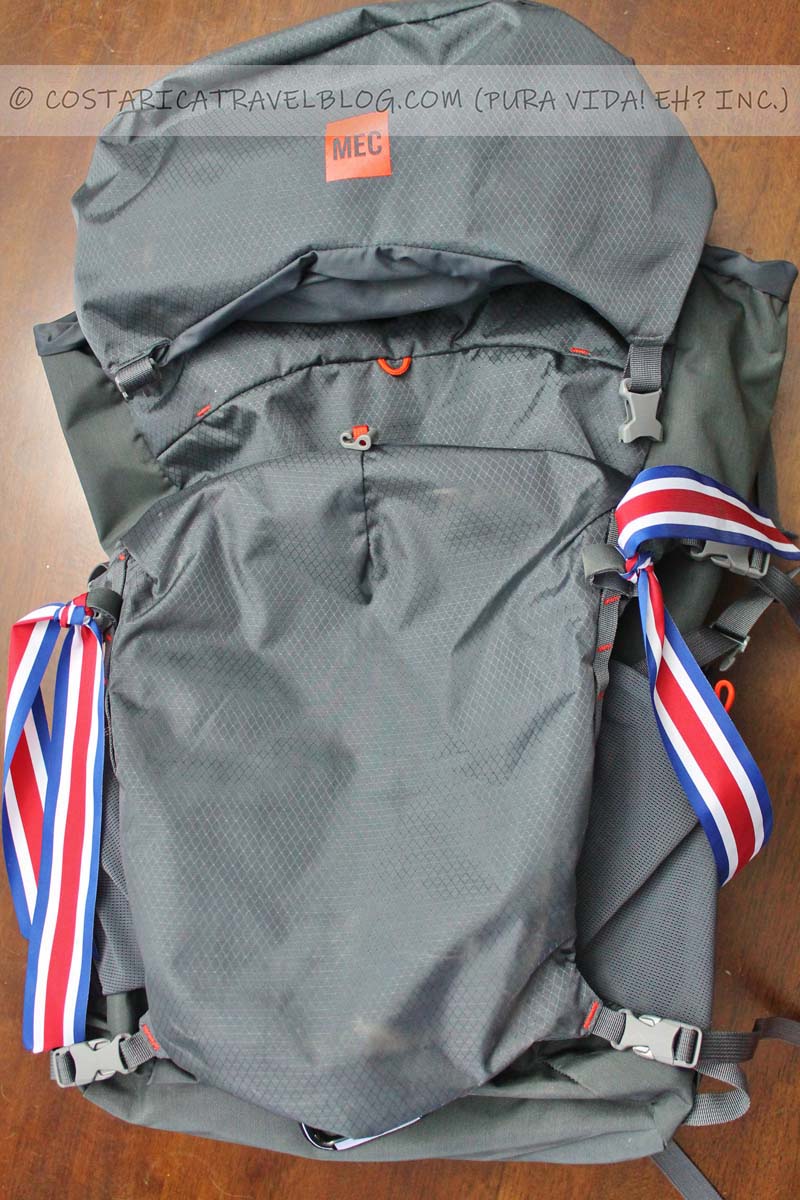
For all of the clothing items listed below, quick-dry or dry-fit (i.e., fast-drying) apparel is ideal. In addition, clothes that condense well by folding or rolling help save luggage space. They’re also great for stowing in small backpacks or day packs that you may choose to carry on guided or self-guided tours.
- Costa Rica is hot. Unless you’re destined for cool high-altitude destinations only, the chances are good that you’ll feel the heat during your trip, and you’ll sweat through your clothes at a faster rate than you do at home. So, for however many days you plan to be in Costa Rica, think about the quantity of apparel you’d go through at home over the same period, and pack no less than that for Costa Rica.
- Factor one outfit for every activity you intend to experience in Costa Rica, regardless of whether those activities are experienced on the same day . The general “one outfit a day” rule doesn’t apply to Costa Rica. If you plan to go rafting on one day, horseback riding the next morning, and zip-lining that afternoon, for example, pack at least three outfits for the two days. You’ll likely dirty or sweat through the outfit you wear while horseback riding in the morning, and you’ll appreciate having a fresh outfit to wear a few hours later while zip-lining. No one enjoys wearing stinky, soiled clothing for longer than necessary.
- Factor additional outfits for evening activities on however many evenings you intend to spend outside of your hotel room. If you wish to spend a night (or every night) out on the town, dining at a restaurant or checking out a bar, you won’t want to wear the clothes you sweat through during the day for that experience, so you’ll need a fresh set of clothes to wear in the evening. Of course, on low-key evenings spent lounging around your hotel room, pajamas will suffice.
- Obviously, if you intend to access laundromats (or use your hotel’s laundry service, assuming they offer it) during your trip, you don’t need to pack as many clothes for Costa Rica as suggested above. But here’s the thing: people always say they’re going to use laundromats when they get to Costa Rica, but they rarely do once they arrive because they don’t have time for them. Most travelers want clean clothes the instant they want or need them, and they prefer not to wait for a laundry service to provide them, so at the risk of packing a fuller suitcase, bring extra clothes with you to Costa Rica so they’re always on hand, and skip the task of acquiring and waiting for laundry service altogether.
- Pack at least one pair of lightweight pants, even if you don’t think you’ll ever wear them. Some tours and activities in Costa Rica require, if not strongly recommend, that participants wear pants, not shorts. Policies vary by tour operator, but I’ve seen the suggestions get enforced by hanging bridge parks, zip-line tour operators, canyoning tour operators, horseback riding tour operators, and night tour operators. You didn’t travel all the way to Costa Rica to not be able to experience it, so pack a pair of pants in the event that your chosen activities require you to use them.
- Pack at least one long-sleeve shirt, sweater, or sweatshirt, plus a pair of warm pants and socks, for any chilly days/evenings, regardless of where in Costa Rica you travel . Although Costa Rica is hot, it can get cool and windy at times, so it’s best to have some warm clothing on hand in case you feel cold .
- San Jose and other destinations/attractions around the Central Valley, including on the Central Highlands
- the Poas Volcano, the Irazu Volcano, and other destinations/attractions around the volcanoes
- Monteverde and its surrounding area
- San Gerardo de Dota and other destinations/attractions around Cerro de la Muerte
- San Gerardo de Rivas, Cerro Chirripo, and other destinations/attractions around Cerro Chirripo
- Pack two bathing suits, plus any beach-related attire that you wish to use, such as a cover-up, if you plan to swim, sunbathe, and/or participate in water activities. The primary purpose of bringing two bathing suits to Costa Rica is to have a back-up suit on hand in case you lose or tear your favorite suit. Yes, bathing suits are available for purchase in Costa Rica, but that’s not to say that a suit that you like, that’s in your size, and that has a price you’re willing to pay will be available at the moment you need it. In addition, having two bathing suits in Costa Rica awards you the luxury of cycling suits throughout your trip, so when one is uncomfortably wet, ideally the other will be pleasingly dry.
- Pack a water-resistant jacket or poncho, even if your trip to Costa Rica coincides with the dry/high/summer season. You can bring an umbrella to Costa Rica, if you wish to have one to use at your hotel, when getting into/out of vehicles, or while walking around town centers during rainy periods, but don’t just rely on an umbrella to protect you from the rain in Costa Rica. A waterproof jacket or poncho is needed , especially when rain hits in the middle of a guided or self-guided tour. Umbrellas can’t be used while participating in most adventure activities, such as zip-lining and canyoning tours, and they shouldn’t be used when touring natural areas, such as national parks or reserves, because they can damage the local flora. So, using a waterproof jacket or poncho in these (and other) cases is your best bet. Keep in mind that although it rains less during Costa Rica’s dry/high/summer season, rain can present itself at any time in Costa Rica, so you should have a waterproof jacket or poncho on hand regardless of the time of year you visit.
- Pack comfortable underwear, bras, socks, and pajamas . Ladies, depending on the activities you intend to experience in Costa Rica, you may want to invest in a good sports bra . Oh, and our advice above about packing more clothes for Costa Rica than you’d normally wear at home because you’ll dirty and sweat through them at a faster rate here, it also applies to underwear. For every outfit you pack for Costa Rica, pack a pair of clean underwear, and then throw in a few extra pairs for good measure.
- Pack a hat and a pair of sunglasses. A hat helps protect the top of your head and your face, including your eyes, from the sun. Sunglasses can also protect your eyes from the sun, but even if you don’t intend to spend a lot of time in sunny areas, if you intend to rent a car and drive yourself around Costa Rica, you’ll appreciate that sunglasses reduce glare, increasing visibility and your ability to be a safe driver.
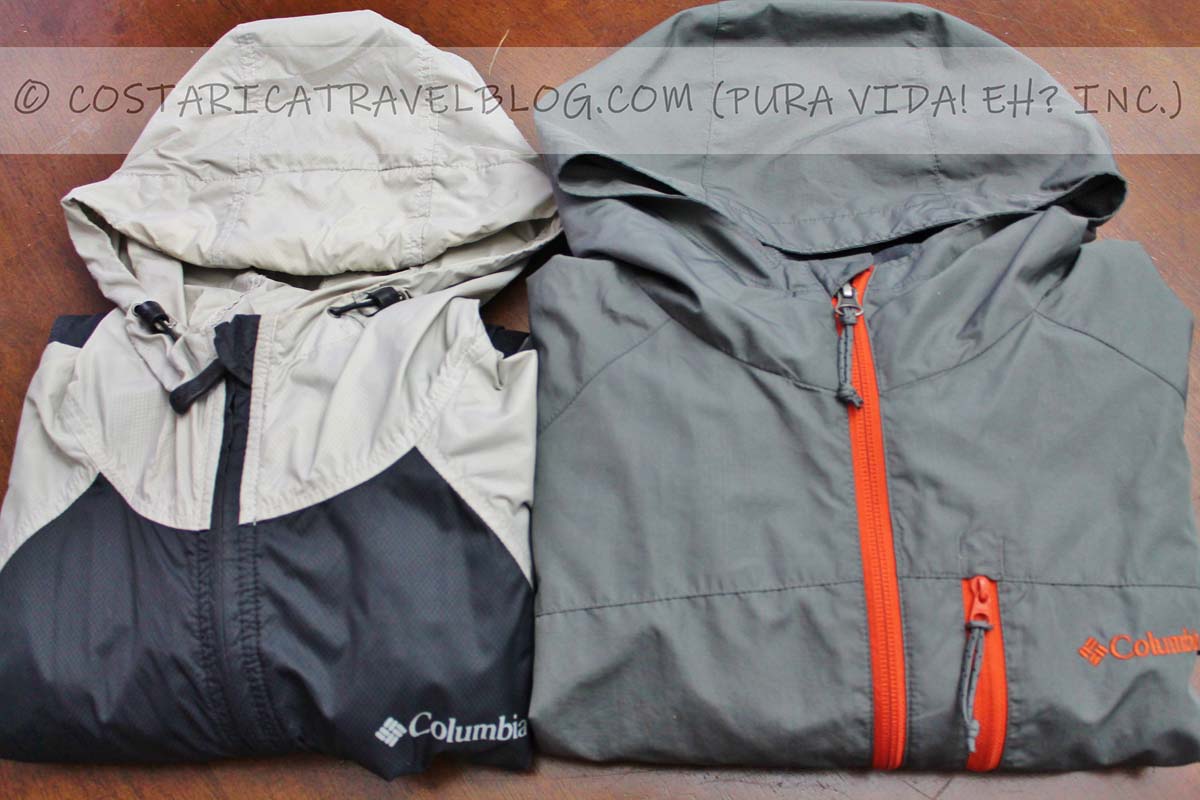
The type and number of pairs of footwear that you should bring to Costa Rica depends entirely on what you plan to do while here. ( The more active you are, the more pairs of shoes you’ll need, and the more important it is to use a particular type of shoe .) Understanding that footwear can be bulky and heavy, and that limiting the amount you bring with you is wise, take the following recommendations into consideration:
- Ensure the shoes don’t have any slits or holes in them (like Keen-brand footwear often has), other than the opening where your foot goes, of course. Some tours and activities in Costa Rica require, if not strongly recommend, that participants use fully closed shoes. Policies vary by tour operator, but we’ve seen the suggestions get enforced by hanging bridge parks, zip-line tour operators, adventure parks, and night tour operators. Some policies also indicate that sandals, even the securable strap-on type, cannot be used during adventure tours , so it’s best to stick to fully closed hiking or running shoes.
- Give yourself time, before you travel to Costa Rica, to break in the shoes. Doing so ensures that you’ll be comfortable when you wear the shoes in Costa Rica and that you won’t have to deal with annoying and painful heel and toe blisters.
- Check to make sure the treads on the shoes aren’t worn. At any time of year, but especially during the wet/green/low/rain season, nature trails and other paths can be strewn with rocks, tree branches, slippery leaves, and mud. Good treads lower the risk of slips and falls , which can quickly put an end to a lovely vacation.
- Pack a second pair of high-quality, fully closed hiking or running shoes (that are already broken in and have decent treads on the soles) if you plan to be active every day of your trip. If you intend to participate in guided or self-guided tours every day, bring a second pair of hiking or running shoes to Costa Rica so you can cycle shoes throughout your trip. This way, if a particular pair of shoes gets wet during an activity, or gets dirty and needs to be washed, it can be drying at your hotel while you use your back-up pair of shoes. The second set of reliable hiking or running shoes can also serve as a back-up pair in the event that you lose or break your primary pair of shoes.
- If you want to keep your hiking shoes/running shoes dry at all times, you can carry a set of water shoes with you and change into them whenever water presents itself.
- If you enjoy wearing shoes while swimming (in the ocean, in rivers, at waterfalls, in hot springs, or at hotel pools, for example) and you don’t want to use your hiking shoes/running shoes for that. Especially if you’re traveling with children and you want to best protect their feet while swimming, go ahead and pack a pair of water shoes for them. Their small shoes shouldn’t take up much room in your luggage anyway!
- Pack a pair of comfortable walking shoes that aren’t hiking shoes, running shoes, or flip flops. Hiking shoes and running shoes, while important to use at certain times during your trip, aren’t the most comfortable footwear recommendation for light travel. And flip flops, while generally comfortable, can quickly grow uncomfortable after several hours of use. A pair of lightweight running shoes, slip-on shoes (i.e., ballet flats), boat shoes, or strap-on sandals is recommended for participation in non-adventure activities in Costa Rica , like the exploration of town centers, museums, and souvenir shops.
- Pack a pair of flip flops if you’re destined for a beach. Flip flops are good for using at beaches (they’ll save your feet from the heat of the hot sand) and they’re suitable for slow, brief strolls around beach towns .
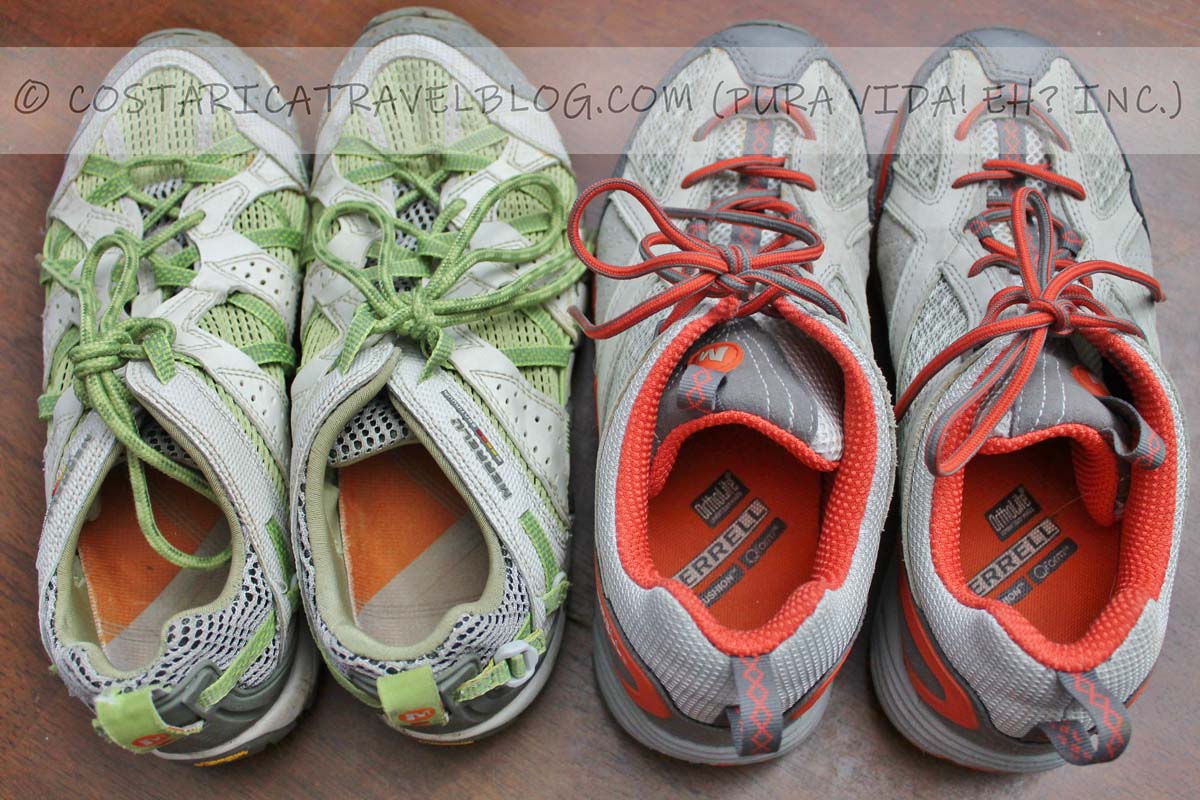
- Pack waterproof sunscreen, ideally a reef-friendly variety if you intend to wear it while swimming or participating in water activities. Regular (non-reef-friendly) sunscreen can be purchased at grocery stores in Costa Rica, but you’ll pay more for it there than at home, so it’s best to pack some for your trip. Reef-friendly sunscreen, which is hard to come by in Costa Rica and should definitely be purchased before you travel, is sunscreen that uses the mineral UV-blocking zinc oxide and/or titanium dioxide as its active ingredients. (It should also identify as being “micro-sized” or “non-nano”.) Here’s a list of harmful chemicals to look out for and avoid when selecting a reef-friendly sunscreen, courtesy of Save The Reef : oxybenzone, octinoxate, octocrylene, homosalate, 4-methylbenzylidene camphor, PABA, parabens, triclosan, microplastics (exfoliating beads), and any nanoparticles or “nano-sized” zinc or titanium.
- Pack insect repellent . Like sunscreen, insect repellent can be purchased at grocery stores in Costa Rica, but at inflated costs. Eco-friendly insect repellents exist but are rare finds in Costa Rica, so bring a bottle from home if you wish to use it. Some people swear by certain essential oils and their ability to repel bugs naturally. If this natural option appeals to you, purchase an essential-oil-based repellent at home and pack it for your trip.
- Pack daily hygiene products, including deodorant, a toothbrush, and toothpaste . Most accommodations in Costa Rica, standard quality and above, provide overnight guests with soap, shampoo, and conditioner, so it isn’t necessary to pack these items. But if there are particular products that you prefer to use, or you tend to use more product than the amount that hotels typically provide, bring your own toiletries to Costa Rica. Be sure to pack toiletry bottles in bags or other waterproof carriers so if they happen to leak or crack during travel they won’t make a mess of your luggage and its contents.
- Pack these other toiletries, if applicable, including make-up, a hair brush, hair ties/bobby pins, shaving supplies, contraceptives, and feminine hygiene products. In case of an emergency, feminine hygiene products can be purchased in Costa Rica at grocery stores and pharmacies. Contraceptives can be purchased in Costa Rica at pharmacies.
- Pack antibacterial gel, a would treatment cream or ointment like Polysporin , a selection of bandages in varying sizes, and a bottle of aloe vera . Skip the full-blown first-aid kit; most hotels and tour operators have basic medical supplies on hand to deal with minor issues. (In the event that they don’t or you’re on your own when injury strikes, most towns have at least one pharmacy and medical clinic where medical supplies can be obtained.) The medical supplies you’ll most often need, which you’ll appreciate having access to the moment you need them, are antibacterial gel (to clean wounds and serve as way to wash your hands, if soap and water aren’t available), a wound treatment cream or ointment and bandages (to care for wounds and protect against infection; bandages can also be used as tape or patches, in the event that you tear your shoes, clothes, or pack), and aloe vera (to remedy sunburn).
- Pack prescription medication or devices, if applicable. If you need to bring prescription medication or devices to Costa Rica, travel with a doctor’s note and an up-to-date prescription list. These supplementary items should make it easier for you to pass through airport security and immigration/customs. If possible, leave pills in their original bottles or packs . (You can sort them into pill organizers/boxes after you officially enter Costa Rica.)
- Pack eyeglasses, contact lenses, and contact lens solution, if applicable. If you use eyeglasses regularly and you intend on being active in Costa Rica, bring an eyeglasses strap so your glasses will be secure while you participate in adventure tours, such as white-water rafting tours or zip-line tours.
- Pack a small roll of toilet paper or a small package of tissues. Unfortunately, not all public bathrooms in Costa Rica provide free toilet paper ; some places charge for its use, and others don’t bother to check whether any paper is available. This is especially true at bus stations and at destinations in remote areas of the country. Traveling with your own supply of toilet paper or tissues is a smart, proactive, cost-saving idea.
- Pack a set of water-resistant reusable bags. They can be used to store a variety of items, including toiletries, important documents, and snacks.
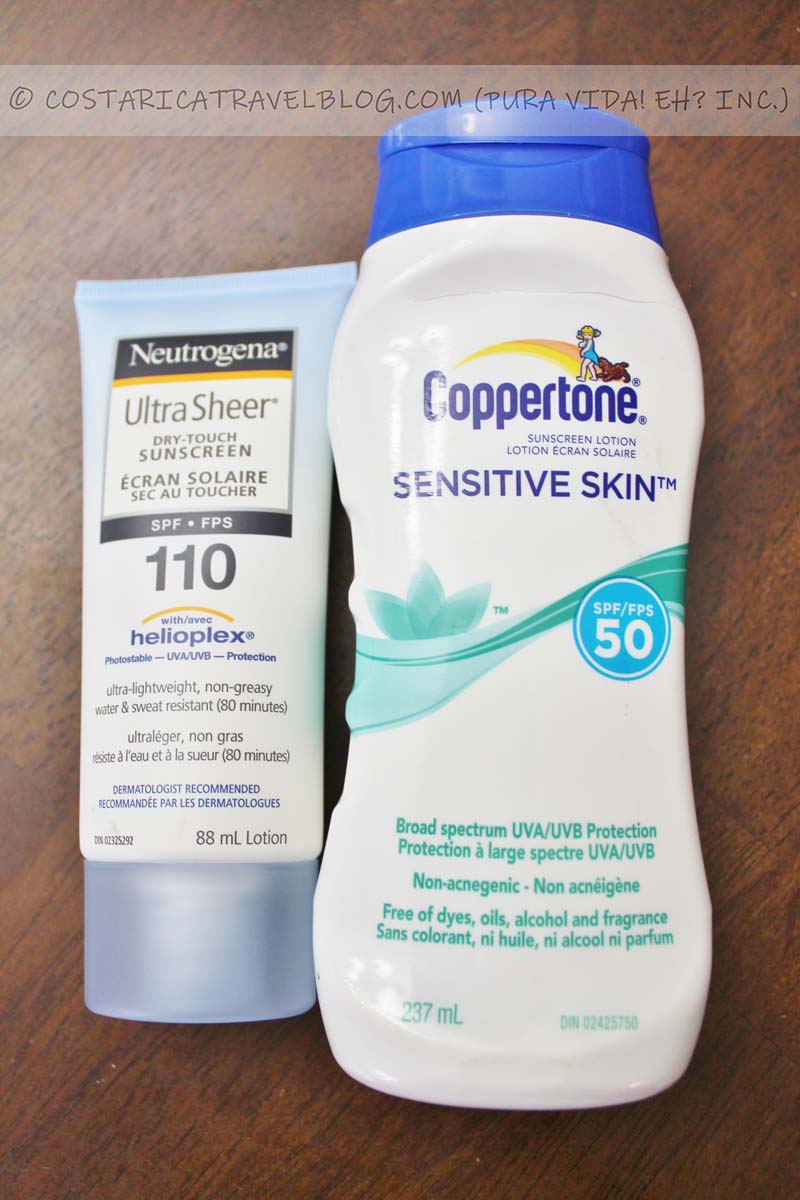
- Pack a set of lightweight headphones. Even if you never use headphones in Costa Rica, you’ll want a set for your flights to and from Costa Rica if you intend on using your airline’s in-flight entertainment system. Keep them on you (in your pocket, for example) while you fly ; they won’t do you any good on the plane if they’re in your checked luggage or buried in your carry-on.
- Pack a metal pin, like the one pictured in the photo gallery below, or an earring that provides a similar pin . You can use the thin part of the metal pin to pop open your cell phone’s SIM card port if you intend to buy a Costa Rican SIM card soon after you land in Costa Rica. There’s nothing more frustrating than wanting to be able to use your phone in Costa Rica but not having a way to open the port.
- Pack a camera, its charging cable/device, and two camera batteries . Having an extra camera battery means that you’ll always be able to use your camera, even when one battery is dead. Simply use the back-up battery while the original is charging.
- Pack an external hard drive or extra memory cards if you don’t plan to transfer your vacation photos to cloud storage or a different back-up source, such as a laptop, while you travel. To not chance losing your precious vacation photos, be sure to transfer your trip photos and videos (or copies of your trip photos and videos) onto an external hard drive, extra memory cards, a laptop, or an online cloud storage account, such as DropBox, iCloud or SkyDrive, daily throughout your trip.
- Pack a laptop, tablet, or smartphone that’s equipped with Wi-Fi, plus the device’s charging cable . Most accommodations provide overnight guests with free Wi-Fi, which you can use on your own Wi-Fi-equipped device. Tapping into free Wi-Fi is a great way to stay connected to loved ones at home, to access travel or tourism information online, or to make last-minute reservations or reservation changes/cancelations. Don’t miss the electronic device tips we provide in our related blog post: Technology, Devices, And The Internet In Costa Rica .
- Pack a high-beam flashlight or headlamp. Several of Costa Rica’s poisonous species are most active after dark. To best protect yourself from an unfortunate encounter with one, bring a high-beam (i.e., high-quality) flashlight or headlamp and take it wherever you travel after the sun goes down , whether that’s a forest trail traversed on a guided night tour or the path you take back to your hotel room after dinner. Keep in mind that it gets dark around 6:00pm in Costa Rica , so you’ll want to have a flashlight or headlamp on you after that time.
- Pack a few small nightlights with the breakable plastic covers removed (as shown in the photo gallery below.) We use little nightlights in every hotel room we stay in. They’re good to have for safety reasons but also they come in handy on nights when the power goes out , which aren’t all that uncommon of an occurrence in Costa Rica. Alternatively, you can travel with a battery-operated lantern (you could also rely on your flashlight for light in the event of a power outage), but we prefer to travel with a handful of nightlights, which are smaller and lighter to carry .
- Pack a portable security alarm . This is an unconventional packing item but one we always use : a doorstop alarm. This ingenious contraption, designed like a wedge doorstop that’s meant to be placed on the floor inside a hotel room, is essentially a portable alarm system. Its metal top is an alarm trigger; when pressed by an opening door, a loud alarm sounds. Regardless of where we travel, we bring two of these devices with us, one to tuck under the door of our hotel room at night and the other to keep on a bedside table so it’s within arm’s reach. Although Costa Rica is generally safe (our recommendation to bring an alarm isn’t to suggest otherwise), it’s merely common sense to travel cautiously. Although many hotels provide doors with deadbolt locks and chain or swing locks, others do not. Having an alarm can be particularly reassuring when you encounter the latter. (Note: Remember to pack batteries for the alarm, and ensure the batteries aren’t in the alarm when you fly to and from Costa Rica , to avoid the alarm going off mid-flight.)
- Pack a reusable bottle and a set of reusable utensils. Costa Rica has ambitious sustainability goals, and one step toward achieving those goals is its ban on the use of single-use items at protected land areas, including several national parks, biological reserves, and wildlife refuges, as well as restaurants . Packing a reusable bottle and reusable utensils ensures you’ll always have access to hydration (potable water is widely available in Costa Rica) and a way to eat snacks and/or leftovers.
- Pack our Costa Rica guidebook, Moon Costa Rica , published by Moon Travel Guides. Hey, you can’t blame us for trying. 😉 Seriously, though, if you want to invest in the quality of your trip, consider purchasing a copy of the book. It’s the absolute best travel companion we’ve ever created. ❤️
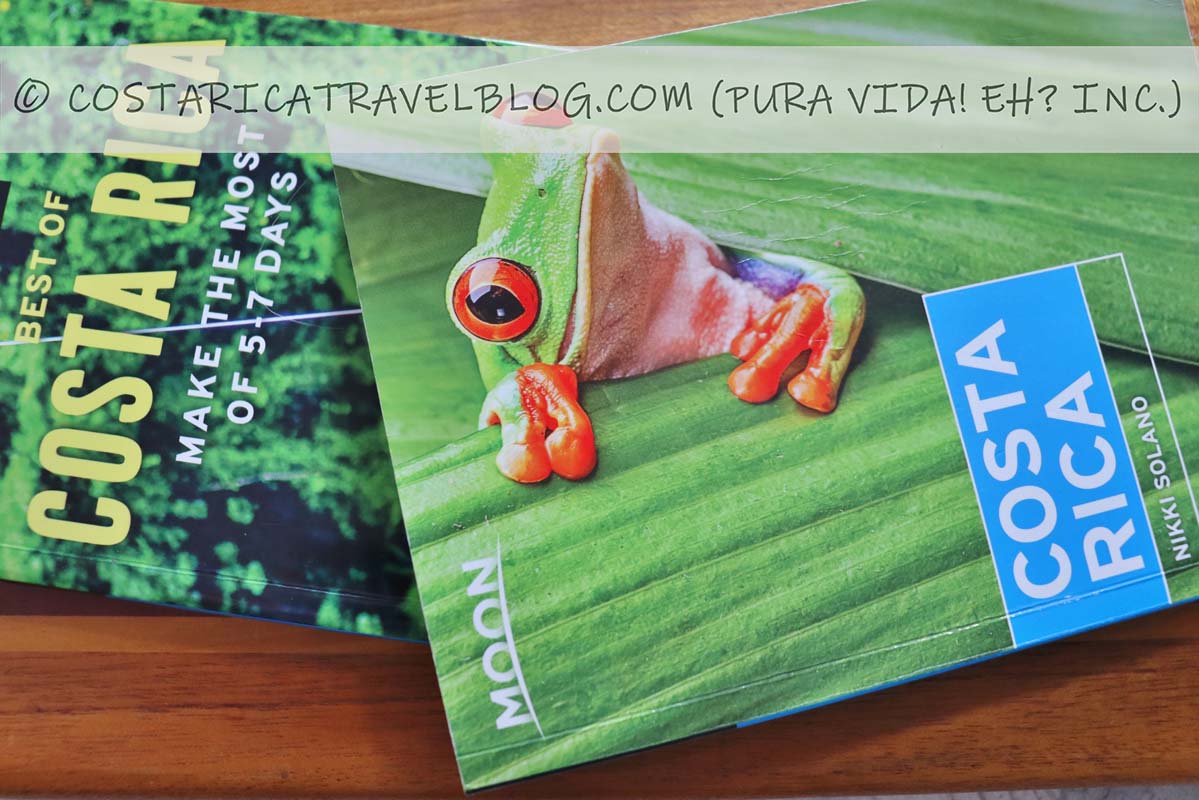
- Pack your original passport, plus a few color copies of the pages in your passport that show your photo, your signature, and any entrance/exit stamps. In addition to bringing your original passport to Costa Rica, bring hard copies of your passport; you’ll appreciate having them in the event that your original passport gets lost, stolen, or damaged. In addition, some tour operators, including those that run tours to attractions near the borders that Costa Rica shares with Nicaragua and Panama, will ask you to bring your passport with you during the tour. If you’d prefer not to take your original passport on the tour, a copy of it will usually suffice. (If in doubt, ask the tour operator whether they will accept a copy of your passport.) Don’t miss the “Identification and Possession Safety” tips that we provide in our related blog post: Is Costa Rica Safe? Yes, If You Do This.
- Pack your driver’s license, if you plan to rent a car in Costa Rica, and ensure it will remain valid for the duration of your trip. You’ll need to present your driver’s license when you rent a car in Costa Rica and if you happen to get stopped by Costa Rica’s traffic police while driving in Costa Rica. Side note: If you intend to decline part insurance through the car rental agency in favor of using car rental insurance that’s provided by your credit card company, you may need to also pack paperwork from the credit card company that confirms the type and amount of car rental insurance that they provide . For more information about this, see our related blog post Costa Rica Car Rental Insurance .
- Pack your student identification document, if you’re currently a student, and ensure it will remain valid for the duration of your trip. Some tour operators offer lower tour rates to students , but in order to access those lower rates, you need to be able to show valid student ID, so be sure to bring that document from home. You can browse student discounts for Costa Rica day tours on our sister site, Pura Vida! eh? Inc., here.
- Pack the credit card(s) you wish to use to pay for items in Costa Rica . Most establishments in Costa Rica accept VISA, Mastercard, and AMEX , so it’s best to rely on those card types over others during your trip. Some credit card companies place international spending bans on their clients’ accounts, so it’s a good idea to call yours before you leave home to ask them to lift any bans for the duration of your trip. It’s also wise to ask whether they will charge fees for purchases made in foreign countries or purchases made in currencies other than your home currency, such as Costa Rican colones , so you know in advance what spending fees might be headed your way. Don’t miss the other “Money and Spending Safety” tips we provide in our related blog post Is Costa Rica Safe? Yes, If You Do This.
- Pack cash . For information about bringing and spending cash in Costa Rica, don’t miss our related blog post Spending Money In Costa Rica: What To Know About USD, Colones, Credit Cards, And More , as well as the “Money and Spending Safety” tips we provide in our related blog post Is Costa Rica Safe? Yes, If You Do This.
- Pack a piece of paper containing the emergency contact information for an individual who is not traveling to Costa Rica with you . In the event of an emergency, this information will expedite the process of notifying your loved ones. Keep the paper with your passport.
- Pack copies of all applicable trip confirmations, such as hotel confirmations, tour confirmations, and/or rental car confirmations, as well as a confirmation of your trip insurance policy number, assuming you have travel insurance coverage. Don’t miss the “Identification and Possession Safety” tips we provide in our related blog post Is Costa Rica Safe? Yes, If You Do This.
- Pack driving directions to each place you’re headed in Costa Rica. Although most travelers rely on Wi-Fi to provide GPS services and/or online maps, if you travel someplace where a reliable Wi-Fi signal isn’t present, hard copies of driving directions can be real lifesavers. Don’t miss our downloadable/printable Driving Directions for Costa Rica .
What to pack for Costa Rica: Extra, non-essential items
Here’s our list of non-essential items worth considering when you’re deciding what to pack for Costa Rica.
- Consider packing a thin money belt . You can use it to carry money and other important items discretely on your body throughout your trip.
- Consider packing an identification/paperwork carrier . One will help you keep important information organized, especially during the chaotic process of passing through airports. If possible, get a carrier with a zipper, like the one pictured below, so there’s little chance that something of value, such as your passport or boarding pass, will fall out.
- Consider packing over-the-counter medications, such acetaminophen ( Tylenol ), ibuprofin ( Advil ), dimenhydrinate ( Gravol ), loperamide ( Imodium ), or diphenhydramine ( Benadryl ), and vitamins. Most of this medication, albeit with Spanish brand names, can be purchased from grocery stores or pharmacies in Costa Rica. (Note that if you or your travel companions are prone to motion sickness, by car or boat, you’ll want to have an anti-nausea medication, such as Gravol , on hand whenever you set out to explore Costa Rica’s rugged topography.) Bring vitamins from home, if you take them, to avoid wasting time trying to hunt down specific types or dosages in Costa Rica.
- Consider packing a list of any allergies you have to medications, foods, or things in the environment. In the event that you experience a serious allergic reaction in Costa Rica, having this list could save your life. Use Google Translate to translate your list into Spanish , so you can inform non-English-speaking locals, such as restaurant staff and tour guides, of your limitations.
- Consider packing a clock, watch, or electronic device that has an alarm . It will come in handy if early morning tours or transportation services are plugged into your itinerary. Not all hotels offer wake-up calls.
- Consider packing a towel . Most hotels won’t allow guests to take in-room towels to beaches, and not all tour operators supply towels with their tours. (You’ll want to have a towel if any tours you participate in require getting wet.) To save room in your luggage, consider bringing a microfiber towel to Costa Rica. Weirdly, car-wash towels, which can usually be purchased at hardware stores, work great! They’re absorbent, quick-drying, and small enough to slip into a day pack.
- Consider packing an icy cool towel . This kind of towel is designed to keep you cool when it’s hot. (It’s typically worn around your neck.) It also wicks moisture away from your body, which is helpful during sweaty hikes in humid areas.
- Consider packing a medium-sized water-resistant reusable bag. Using one (or more) of these bags is a great way to keep wet and/or dirty clothes, bathing suits, and towels away from clean and dry items in your luggage. They can also keep your possessions, including your camera, dry when you’re out exploring Costa Rica and it starts to rain.
- Consider packing a small waterproof case or bag. There may be some occasions when you need to keep small items, such as car or hotel room keys, credit cards, cash, or your cell phone, on your person because you don’t want to leave them out of arm’s reach. For example, if you’re swimming at a beach, a waterfall, or hot springs and you’re concerned that someone might swipe your stuff while you’ve left it unattended. Consider packing a shatterproof, waterproof case (we use a small one from Pelican ), ideally a case with a strap that you can secure to your wrist, so you can take important items in the water with you. A small waterproof bag will also do.
- Consider packing a female urination device, together with an empty bottle and a small pack of tissues. I bet I caught your attention with this one! Ladies, sometimes nature calls at the most inopportune times, often in the middle of an arduous hike. To prepare for that, consider purchasing a female urination device (I have the Whiz ) that allows you to capture urine so it can be disposed of properly when possible. Seriously, the thing’s a lifesaver.
- Consider packing binoculars. Binoculars are an obvious item to pack if you’re an avid birder. But even if you aren’t into bird-watching, they’re handy to have while you travel. Use them to examine other kinds of wildlife and far-flung sites of interest, or as a zoom lens for your camera. (See our recommendation for the Best Item (Other Than A Camera) To Pack on our sister site, DIY Costa Rica, for more information about that.)
- Consider packing field guides if you have a specific interest in identifying flora or fauna encountered during your trip. Field guides can be big, bulky, and heavy, so be selective in choosing which ones to pack , if you absolutely must bring them to Costa Rica. Foldable, pamphlet-style field guides are a good compromise: they’re packed with information but are lightweight and easy to carry around in backpacks.
- Consider packing a bike chain or bike lock . If you intend to rent a bike in Costa Rica, it’s a good idea to bring a bike chain or bike lock from home so you can secure your rented bike when you’re not using it (i.e., while you shop, swim, hike, or dine). If you’re renting a mountain bike from a professional bike shop, you should be able to get a chain or lock through the shop, but if you’re only renting a beach cruiser bike for casual exploration, you’d best supply your own lock or chain.
- Consider packing extra batteries or phone/camera charging cables. Costa Rican stores sell batteries and cables, so it isn’t a requirement to bring them from home to accompany your devices, but if you want the convenience of having extras on hand, go ahead and throw some in.
- Consider packing a pocket-size Spanish book . Books can eat up luggage space and add luggage weight pretty quickly, so packing several isn’t smart. But if it’s an interest of yours to practice speaking Spanish with Costa Ricans during your vacation, consider packing one language guide, ideally a small one that will fit in your pocket or day pack. Alternatively, you can rely on Google Translate or other language translation websites or apps to facilitate your linguistic education.
- Consider packing your preferred snacks. It goes without saying that snacks can be purchased in Costa Rica, everything from nuts and seeds, granola bars, cookies, crackers, chocolate, and candy to fresh fruit, baked goods, and other delicious treats. But everyone has their own comfort foods, and if there’s something that you find particularly pleasing or calming to consume, bring it from home. When you take lengthy transportation services between destinations, check into hotels long after restaurants have closed, need a boost during a challenging hike, or encounter the late-night munchies, you’ll appreciate having a familiar taste of home.
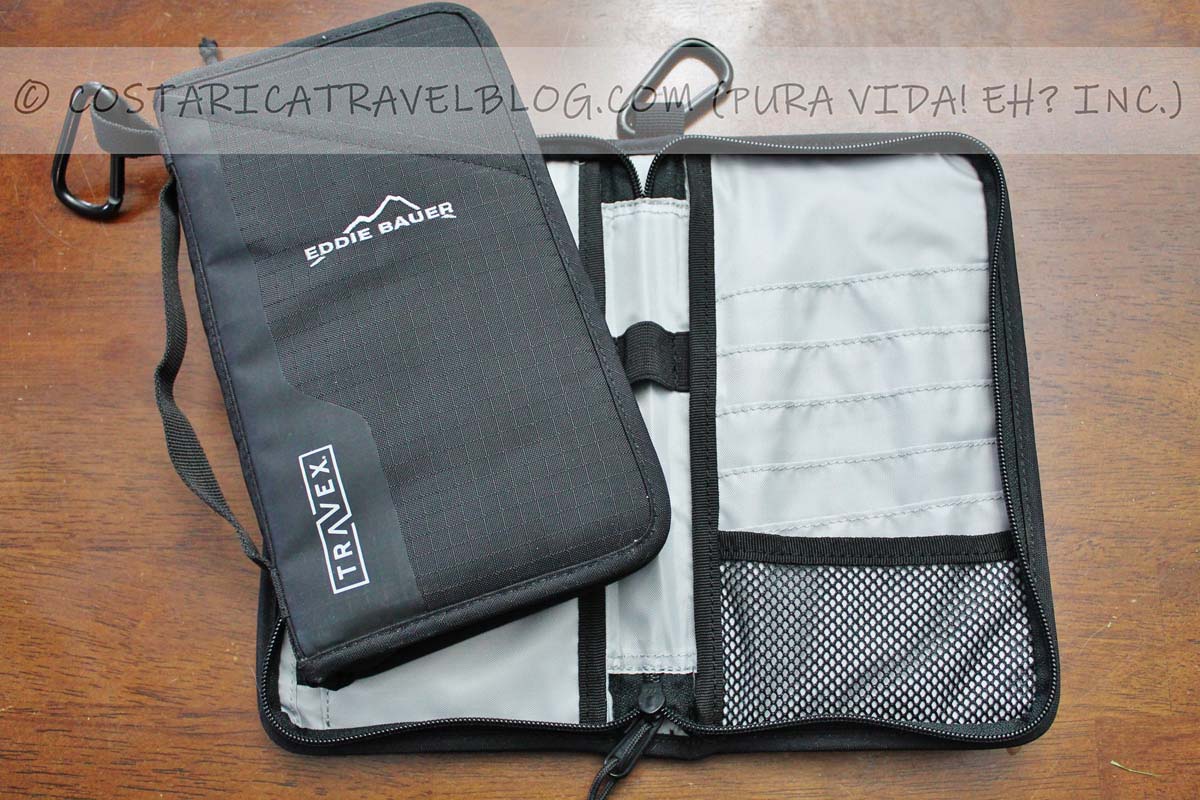
Here’s what we suggest skipping when debating what to pack for Costa Rica.
- Journals or books that you don’t honestly think you’ll use during your trip . If you’re an avid reader or writer, by all means, bring your journal and a novel to Costa Rica. If you aren’t either of those things, though, we’re certain you can find better items to fill your luggage with than hundreds of untouched pages.
- Jewelry. Let’s state the obvious: you’ll probably wear casual clothing, if not hiking or bathing attire, throughout most of your trip. If you plan to dress up while on vacation, skip the fancy jewels . The last thing you need to worry about on a trip to the rainforest is the whereabouts of your expensive or irreplaceable accessories and heirlooms. It’s also worth noting that flashy things can attract sly eyes, so if bling is your thing, keep the adornments to a minimum.
- Travelers cheques . Apart from some all-inclusive resorts, most tour operators, hotels, restaurants, and shops in Costa Rica don’t accept travelers cheques. Furthermore, most Costa Rica visitors rely on cash and credit cards, not travelers cheques, to pay for things in Costa Rica. (For more information about this topic, see our related blog post Spending Money In Costa Rica: What To Know About USD, Colones, Credit Cards, And More! , as well as the information we provide in the “Money and Spending Safety” section of our related blog post Is Costa Rica Safe? Yes, If You Do This. ) If you absolutely must bring travelers cheques to Costa Rica, know that in most cases, you’ll only be able to cash them in at Costa Rican banks, so you’ll need to make time during your trip for multiple jaunts to local bank branches .
- Anything that Jean Claude Van Damme would carry with him. Unless you’re up for roughing it in Costa Rica Bear Grylls style, you’re probably not going to need duct tape, a match set, a Swiss Army knife, a compass, or any other similar kind of wilderness survival tool.
When deciding what to pack for Costa Rica, don’t forget to leave space in your luggage for souvenirs. (See our related blog post Costa Rica Souvenirs: Buying Tips And Photo Galleries for souvenir suggestions and photos.) Better yet, when packing for Costa Rica, fill the space you allot for souvenirs with donation items, such as school supplies, medical supplies, and futbol (a.k.a., soccer) shoes, that can be donated to Costa Rican schools, organizations, and sports clubs. You’ll be surprised to learn just how rewarding a Costa Rica vacation can be when you pack a little philanthropy into it. 😉
QUESTION TO COMMENT ON: Have you been to Costa Rica before? What did you pack for the trip?

Hey, Costa Rica Travel Blog reader, thank you for visiting and reading our blog! We're truly grateful for your time and preference.
Do you know that your spam-free reading experience is most important to us? Unlike some other Costa Rica blogs, we do not to sell your personal information, and we choose not to display ads, sponsored content, or affiliate marketing on our blog so we can keep your visit as distraction- and junk-free as possible. Because we prioritize your privacy, we don't earn money when you visit us, when you sign up for our e-course, or when you click on our links, which means the time and work we put into this blog—including its 300+ articles—is entirely voluntary! If you find our content valuable, and you'd like to thank us for making the trip-planning process easier and your Costa Rica vacation more enjoyable , please consider making a small donation ($1, $2, $3, or an amount of your choosing) to our blog. Doing so is a great way to pat us on the back if you feel we deserve it . 😊 Pura vida, amigos!

Click on the button above to donate through PayPal. (If you cannot see the PayPal button above, click here .) A PayPal account is not required to make a donation; credit and debit cards are also accepted. PayPal donations are confidential; we never see your payment details.

Tagged: adventure , beach , budget travel , costa rica , costa rica travel , costa rica travel tips , costa rica vacation , packing , tourism , tours , travel , travel guide , travel tips , vacation
- Author Posts
The comment section of this article has moved! If you have a question or comment about our article above or Costa Rica travel in general, please post it in our Questions and Answers Forum on DIY Costa Rica , our sister website, where you can also access our private Costa Rica recommendations, our Costa Rica Destination Tool, and our Costa Rica Recommendations Map. See you there, amigos! 🙂
I NEED to go back soon. <3
Hey dawnkealing!
Costa Rica is calling your name! 😉
Loved Costa Rica, but after getting stuck in a downpour at Manuel Antonio, I wish I had an umbrella. We had rain gear, but it was no match!
Hey alongourway!
Good point! Umbrellas aren’t great to use in a few different scenarios, but if you’re in town and get caught in a downpour, they can be helpful. Thanks for adding this tip! 🙂
WOW great advices. Umbrella is the most useless thing. During organized trips it is impossible to look around you with umbrella. I don`t use one, too. Thank you for sharing your amazing tips. They are soooo useful. Best regards!
Con mucho gusto (you’re welcome), Lorene! 🙂
Wow! These tips are very helpful. I am planning to travel to Peru on August for a month and I just realized that some of the things that is in the list here are somewhat important. Thanks for sharing tho.
I’m glad our tips are universal and have been able to help you, Clair! 🙂
Awesome site… We leave for Costa Rica in 3 days, lots of great information… Thanks
Hey Michael!
Glad we could help. Happy travels! 🙂
So cool advices in this blog! I am going on a vacation and I have to pack my stuff but I don’t know what to take with me and what to leave at home. Thank you for sharing these packing ideas!
Hello Olivia Brandon!
No problem! Wishing you safe and enjoyable travels! 🙂
You two are so cute! And this is such great advice. I happened to overhear a mother and daughter recently discussing the type of shoes the daughter should take to Costa Rica where her group planned to backpack through the forest, ultimately to visit a volcano. The mom was pressuring her to buy a pair of snake-proof boots (we live in Texas where those are handy if you hunt).
I could not keep silent, and asked her if she had any Tevas. Blank look. So I described shoes like yours, the open design warm weather hiking shoe. Another blank look. They were still at it when we left the store. If only I could’ve emailed her your website!
Sure hope she didn’t run across any snakes. 🙂
Oh my goodness! I hope the daughter made out alright! How I wish we could know how everything went. 😉
We are leaving in 2 weeks with our 16, 14, and 9 year old Boys. How do you recommend we travel with their passports and documentation as this is our first family trip out of the US? Thanks for the great list!
Congrats on the upcoming *first* family international trip! 🙂
Travel documents (such as passports) are precious, and travelers sometimes ask us whether it is better to carry the documents with them at all times or leave them in the hotel room. This is a tough call because risk is inherent anywhere and everywhere! We usually say to trust your gut. In most cases, we recommend leaving the original documents in your hotel room (many offer in-room safes) to avoid losing or causing damage to the documents while you participate in tours and activities. This being said, we highly recommend keeping a copy (or two!) of any/all important travel documents throughout your trip (you can even email copies to yourself, if you wish to have an electronic copy too), and ensuring those copies are kept in a different place than the originals at all times. For more information about safe (and smart) travel, please see our related blog post Costa Rica Safety Guide: Is Costa Rica Safe? Yes, If You Do This. and pay special attention to the section on “Identification And Document Safekeeping.”
Pura vida! 🙂
Thank you for this comprehensive guide – particularly about the footwear!
Con mucho gusto (you’re welcome), Chanel, and thanks for commenting! 🙂
- The forum ‘Costa Rica Travel Blog Forum’ is closed to new topics and replies.
- Kale by LyraThemes.com.
We're Nikki and Ricky, and we're human!
Sadly, ai-generated costa rica blogs and guides are taking over the internet. thank you for choosing our authentic website and resources over others, for trusting our firsthand experience, and for preferring our human-backed recommendations 😀 other ways we are unique:.
✓ We choose not to display ads, sponsored content, or affiliate marketing on our blog. Because we prioritize your privacy, we don't earn money when you visit us, when you sign up for our e-course, or when you click on our links, which means the time and work we put into this blog is entirely voluntary. ✓ Ricky is a born-and-raised Costa Rican and Nikki (married to Ricky) has explored Costa Rica since the mid-2000s . ✓ We've operated our Costa Rica-based business, Pura Vida! eh? Inc. , for 16 years (and counting!) . ✓ Our Costa Rica guidebooks are published by the prestigious Moon Travel Guides brand . ✓ We only ever write about experiences we know firsthand , and we never stuff our blog with general information about Costa Rica that is widely available elsewhere . ✓ We never copy or plagiarize other writers' content . How we wish other writers would show us the same respect! ✓ Unless stated otherwise, every photo displayed on our blog was taken by us, and with our own two hands. (Unlike some other bloggers, who rely on drones to travel and conduct research for them, we actually visit and explore the places we write about .)👍🏽 ✓ We're active in promoting Costa Rica around the world . We've written about Costa Rica for Wanderlust Magazine (UK), presented Costa Rica on Rick Steves' Monday Night Travel Show and podcast/radio show (US), and served as a Costa Rica Destination Editor for Essentialist (Spain). ✓ Our work is backed by hundreds of positive reviews and testimonials ( read some here ) ✓ We are not overly active on social media . Instead of fixating on our own popularity, we spend the majority of our time exploring and researching Costa Rica, updating our various Costa Rica resources, and working with travelers one-on-one. We're focused on the quality of your travel experience , not the quantity of our followers. ❤️
We hope you enjoy your visit to our junk-free blog as much as your time in Costa Rica. 😊

- Privacy Policy Overview
- Remember my preference
This website uses cookies to operate and provide you with the best user experience possible. To ensure you're aware of and okay with this and our other privacy-related practices, please review our Privacy Policy, then click the button below to accept it.
If you do not accept the policy, we respect your choice 100%. Unfortunately, several of our website’s features, including our Questions and Answers Forum, rely on cookies to operate. Most are also run by themes, plugins, and other add-ons to our website that we do not and cannot control, which means the cookies you receive are mainly provided by third parties. Because simple actions like reading our articles, asking a question, and even visiting our website’s homepage require the use of cookies, it is not possible to explore or use our website without them. If you would prefer not to receive cookies, we kindly (and sadly) ask that you do not visit our website. (Alternatively, you can try setting your browser to remove or reject browser cookies before visiting our website, but you may find that our website doesn’t function properly without them.) By visiting or submitting information through our website, you acknowledge and accept our use of cookies, and the use of third-party cookies. For more information, please see our Privacy Policy.
Thank you for understanding!
In order for our site to remember that you accept our policy, please enable the Strictly Necessary Cookie.
If you leave the Strictly Necessary Cookie disabled, we will not be able to save your preference. This means that every time you visit this website you will need to accept the policy again.
- Skip to primary navigation
- Skip to main content
- Skip to primary sidebar
- Skip to footer

Costa Rica Travel Information
The Complete Packing List for Costa Rica: The Essential Items to Bring
January 1, 2024 By Sammi 129 Comments
What do I need to pack for Costa Rica? As one of the most common questions we get, this Costa Rica packing list post will help you immensely. The most important thing to know about packing for Costa Rica is that there around 27 micro-climates in the country so don’t just throw your shorts and flip flops in your bag, read our packing list for Costa Rica to find out exactly what you need to bring!
*Click the link to get our free packing checklist to help you stay organized! *
Disclaimer: There are affiliate links in this post.
Essential items You Cannot Forget to Bring to Costa Rica
- Original passport. No photocopies, no color copies. Must be your original passport that is not expired and will not expire during your time in Costa Rica.
- Original valid driver’s license (if you are renting a car or driving). No temporary licenses, no photocopies, no paper copies. Cannot be expired or will expire while you are in Costa Rica.
- No foreign transaction fee credit card. My Chase Sapphire Preferred card is a fantastic travel credit card with no foreign transaction fees and many other travel benefits. Make sure to bring a Visa because AMEX is not as widely accepted. Apple Pay/digital cards are not widely accepted in Costa Rica – some places in the city may accept digital cards but it is not common.
- Travel insurance . Highly recommended especially now we know due to the pandemic that anything can happen! Check Safety Wing (great for digital nomads), World Nomads (ideal for adventurers) or browse through various options from Visitors Coverage to find the one that fits your needs.
- Your return flight ticket out of Costa Rica. This can be printed or saved on your phone) to show to immigration if they ask.
- Hotels, tours, car rentals and flight reservations (printed or saved on your phone)
The Essential Things to Bring to Costa Rica
These are the essential items for your Costa Rica packing list: lightweight dry fast clothes, comfortable sandals, swimwear, mosquito repellent, sunscreen SPF 30+, hiking shoes/trail running shoes or closed toed hiking sandals, sunglasses, a hat, battery pack, medical kit, waterproof phone case, camera, day pack, rain jacket, jacket and an insulated water bottle.
Costa Rica doesn’t have a strict dress code so comfortable and casual is best for pretty much the entire country. At the beach where daytime temperatures reach up to 95 F (35 C) with high humidity, your wardrobe will consist of shorts, tank tops, tshirts and flip flops. In the city where daytime temperatures are around 78 F (25 C), we recommend closed toed shoes, long pants and a jacket or sweater. If you’re visiting higher elevation areas ( Monteverde , Bajos del Toro , Vara Blanca, Poas, San Isidro de Perez Zeledon, San Gerardo de Dota , San Jose, Heredia , etc.), then long pants, a warm sweater, long socks and a jacket are necessary. If you are visiting during rainy season, then a waterproof rain jacket or shell is mandatory.
For women, there is no real dress code. You can perfectly wear tank tops and show your shoulders. It is not common for local women to wear leggings as daily wear though. As for the men, no board shorts or short shorts in the city.
Our recommendations: For Costa Rica, clothes that dry fast and wick away moisture are the best. In the city, normal city wear is fine (no beach clothes). For hiking, as a woman, I personally prefer hiking pants rather than leggings due to the intense humidity and mosquitoes. Our closet is full of Columbia , REI , prAna , Nike, North Face and Eddie Bauer with lots of lightweight, moisture wicking clothes for our life on the North Pacific coast.
If you’re doing any activities, hiking shoes/sandals (with straps), sneakers, trail running shoes or hiking shoes are necessary. For the beach, flip flops are necessary. Whenever we travel around Costa Rica, I normally bring one pair of flip flops and one pair of sneakers/hiking shoes or closed toed hiking sandals depending on what we’re doing.
Yeison usually brings a pair of flip flops and his trail running shoes or closed toed hiking sandals. If we’re doing long hikes, he wears waterproof Salomon trail running shoes . I usually bring a pair of flip flops and my KEEN hiking sandals . For hikes, I also have a pair of Salomon hiking shoes.
Our recommendations: We love closed toed hiking sandals. They are amazing for all sorts of light outdoor activities that go from land to water. They dry fast, don’t smell, your feet can breathe and are much more comfortable than stuffy shoes and socks. Waterproof trail running shoes are also amazing for Costa Rica for more intense hikes. If you don’t want to purchase closed toed hiking sandals, a pair of sneakers + water shoes will be great for light activities like ziplining, rafting, tubing, snorkeling, boating.
We love our KEEN hiking sandals and you can read our in-depth guide to what are the best shoes for Costa Rica . Remember, many activities require completely CLOSED toed shoes.
Mosquito Repellent
You have to bring mosquito repellent for Costa Rica as they are present all year round. The coasts are the worst places for mosquitoes and there are a few serious diseases you can catch like dengue fever. There are also other annoying little bugs that bite like gnats and no-see- ums. Mosquitoes are not really found in high elevations above 1500 meters (4900 feet) or so.
Our recommendations: You can find mosquito repellent in the supermarkets but we recommend bringing your own as it is a bit more expensive here. Additionally, there aren’t a ton of natural or non-DEET options. We like this OFF! 20% Picardin and also Avon skin so soft which is DEET free and has SPF.
Repel is another excellent brand that we use a lot (especially me, as non DEET products don’t work great for me and I’m a mosquito magnet). You can read about our favorite mosquito repellent products in this Costa Rica mosquitoes post.
Sunscreen is also a must and bring at least SPF 30. If you burn easily, SPF 50-70 is best and do not forget to reapply! Costa Rica is only 8-12 degrees from the equator so the sun is strong! Additionally, after sun care is very important in case you (probably will) burn.
Our recommendations: If you are going to be going in the ocean, we encourage you to buy reef safe/reef friendly mineral sunscreen . We personally love Raw Elements , SunBum and Reef Repair . If you can, bring sunscreen. If you can’t, you can get sunscreen at any supermarket or pharmacy but it is a bit more expensive with limited options. Don’t forget chapstick with SPF ! Also if you’re surfing, make sure you get a face stick sunscreen with Titanium Dioxide/Zinc Oxide and wear a rash guard with SPF .
Toiletries and Medications
You can find all toiletries in Costa Rica like shampoo, conditioner, lotion, toothbrush, mouth wash, toothpaste and floss in the supermarkets. There are a few items that I do recommend to bring. These are tampons for women (not always readily available), face wash (expensive), hair detangler spray, wet wipes, triple antibiotic ointment, non drowsy allergy medicine, band aids, a packet of tissues and face wipes. Menstruation cups are becoming more available in Costa Rica and are great for travel. If you wear contact lenses, make sure to bring a couple extra lenses, cases and contact lens solution. They do sell contact lens solutions at most supermarkets and the pharmacy but it is a bit more expensive.
If you’re taking any medicines, write down a list of them and keep it with you at all times. Try to include the active ingredients in each medicine or find the Spanish name.
Pharmacies in Costa Rica are not only for prescription medicines. They sell everything like shampoo, lotion, vitamins, supplements, cold medicine, toothpaste and OTC things like that as well as prescription medicines.
For basic medicines, you can find them OTC like cold, flu, sinus, diarrhea and muscle pain at the supermarket. As for other medicines, you’ll need to go to a pharmacy so we recommend bringing any specific medicines you prefer to take.
For example, you can buy anti-nausea medicine at the pharmacy (not supermarket). I like to bring non drowsy Dramamine because this brand isn’t available in Costa Rica and motion sickness medicine is only available at the pharmacy (no prescription required). Also the pharmacist may accidentally give you one that induces drowsiness (this has happened to me before). I always bring my own Claritin for my bad allergies because it is difficult to find non drowsy allergy medicine. Cough drops are not readily available OTC either.
Rain Jacket
A rain jacket is an essential item if you’re visiting during Costa Rica’s rainy season (May to beginning of December). And you want to get a waterproof one, trust me! A poncho can work too but get a good quality one, not those dollar store ones that you throw away after one use which is very wasteful.
However, even in dry season, we recommend to bring your lightweight rain jacket if you’re visiting the rainforest or mountains as it can still rain. These are places like Monteverde, Poas, Vara Blanca, Bajos del Toro, Dominical , Uvita , Bijagua , Monteverde or Osa Peninsula . Also remember the Caribbean ( Tortuguero and Puerto Viejo ) follows a different weather pattern and it can rain at any time of the year.
Our recommendations: We love our The North Face Venture Jackets (I grew up in Washington state so I have lots of experience with rain jackets). I also have a Marmot Precip jacket . We recommend to get a lightweight jacket with zipper ventilation pockets to let air flow through.
For day trips, sight seeing and tours, bring a day backpack. Do not bring those flimsy drawstring gym bags. If you’re not planning on doing long hikes, you can get away with a 20-25 L backpack to hold all the essentials: snacks, water, hand towel, change of clothes, camera, etc.
Our recommendations: We have a bunch of backpacks each with their own purpose. I have a 20 L Osprey , a 30 L Aqua Quest , and Yeison has a 40 L REI. In rainy season, you must bring a waterproof backpack. I love my Aqua Quest waterproof backpacks for hiking and our IDRYBAGS for boating. If you don’t have a waterproof backpack, you can get a rain cover or use waterproof spray.
For photographers, Yeison has a Shimodo Explore V2 which is an absolutely fantastic travel photography backpack as well as a WANDRD . As a content creator, having a good backpack to protect your gear is absolutely crucial. I have the womens version Shimoda Action x30 for my camera equipment with a rain cover and it is amazing!
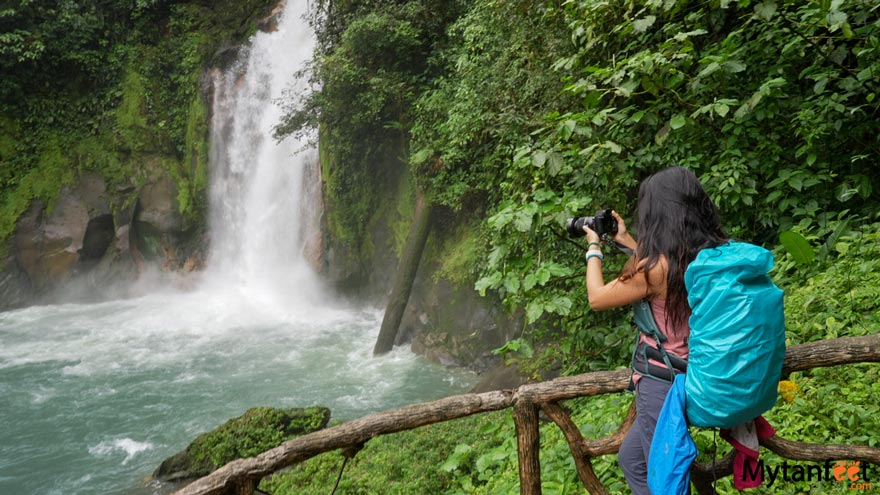
If you are traveling with infants/babies, you must bring a child carrier . Most places like national parks, reserves, hiking trails, do not allow or are not suitable for strollers.
Want more Costa Rica travel tips directly to your inbox? Sign up to our mailing list for weekly and monthly newsletters filled with Costa Rica goodies!
Insulated Water Bottle
I never leave home without my insulated water bottle. It’s the best feeling in the world to take a long sip of fresh cold water when it’s 90 F out. Additionally, bringing your own water bottle helps to reduce the amount of plastic water bottles and you’ll save money on buying water. You can drink tap water in most places in Costa Rica or bring a water filter if you have a sensitive stomach.
We both have 40 ounce Hydro Flasks and it keeps our water nice and cold for up to 24 hours. I also recommend to get the boot for your water bottle because it will get banged around as you take it on hikes and adventures.
Micro Fiber Towel
Our second favorite item we never leave without. A micro fiber towel is awesome for wiping sweat off, using as a fan to cool off or to wrap your stuff in if it starts raining. We have several of various sizes: a hand towel and body towel.
If you’re a surfer, I am in love with my microfiber surf poncho . So comfortable and convenient for changing out of your swimsuit after a surf session.
Sunglasses and Hat
As for the sunglasses, I recommend bringing 2 pairs of sunglasses. You will want to bring one cheap pair so that you won’t cry if it gets lost in the ocean. A hat or visor is also essential to bring to Costa Rica.
Sarong and Swimwear
I love my sarongs. It’s so useful as a towel, beach cover up or even as a blanket for those long cold bus rides. Sometimes I use them to cover my legs at night to protect against mosquitoes when I’m sitting outside. You can buy them in souvenir shops here for around $10-20 USD.
As for swimwear, we recommend at least two pairs. For guys, the swim trunks without the mesh is best and ladies, if you’re visiting popular beach towns like Tamarindo and Jaco , you can buy some super cute locally made bikinis.
Cameras and Technology
If you want to capture all those awesome adventures, an action cam is the best. GoPro is still the reigning king of action cameras. Another really fun action camera is the Insta360X to capture ALL of the moments!
If you’re a photographer, bring a wide angle for landscape shots and a telephoto lens (at least 300 mm) for birds and wildlife. A sturdy tripod is a must for wildlife photographers (we personally use Manfrotto ).
Our recommendations: Make sure to bring the correct accessories for your action camera to attach it to helmets, surf boards, etc. For Go Pro, most tour companies will have the part that attaches to the helmet but you need to bring the other part.
Also, bring plenty of SD cards as it is very difficult to find Class 10 SD cards and mini SD cards . Bring a universal power adapter if you need to as they’re not super common to find here. Costa Rica’s power is 110 Volts, the same as US.
Flashlights or Head Lamps
I always bring a small pocket flashlight with me when we travel around Costa Rica. This is because it can be common for the electricity to go out during really rainy days. It is also helpful if you’re walking at night since many streets do not have any street lights or are very dimly lit. Furthermore, there aren’t really sidewalks so you have to walk on the road.
Anti Theft Travel Bag
I have an anti theft travel purse which I absolutely LOVE. I use it all the time and brought it with me to Europe and the US (it saved me in Spain when I almost got pick pocketed). It’s super useful, spacious and handy for everyday use, light hiking and travel.
The brand is Sherpani and many of their travel backpacks are convertible for two or three styles, has RFID protection, a chain look system, exterior lock system and are water resistant. Some even have slash proof material. I have two of their purse/backpacks which are my go to in Costa Rica and during our international travels.
I also have a RFID wallet which I highly recommend!
Battery Pack
And because the electricity may go out (especially in Costa Rica’s rainy season ), I always have a fully charged battery pack , wall chargers and extra charging cables with me. Super useful when we stay in rural areas or on a long drive!
If you are working while you travel, I highly recommend this USB C Travel Power Strip . Older or cheaper hotels have very few outlets so this is super handy to charge multiple devices at once.
Waterproof Phone Case/Pouch
These waterproof phone cases are super useful. You can wear it around your neck and use it during light water activities like tubing, canyoning, etc.
This is also really nice alternative if you don’t have a waterproof camera and don’t want to spend $500 USD on a GoPro. But remember, these are not recommended to take scuba diving or anything like that, just light water activities.
Accessories and Extras
Here are some other items that will be useful.
- Small first aid kit
- Ziplock bags to protect your electronics
- Laundry bag
- Dryer sheets as your dirty and sweaty clothes will get stinky in your luggage
- Reusable shopping bags
- Lots of silk hair ties and clips
- Sleeping pills if you normally take melatonin/magnesium/etc.
- Travel hair dryer. Hostels, cheap/budget hotels, some Airbnbs don’t have hair dryers in the room. If you’re visiting a cold area, bring a small travel hair dryer .
- Ear plugs, especially if you’re staying in a hostel or cheap hotel downtown. Also, if your hotel is by the side of the road, you may hear the very loud trailer trucks engine braking all night long.
- Car cell phone holder if you are renting a car. Planning to rent a car? Get our Costa Rica car rental discount and extra freebies here!
- Spanish dictionary or guide. Download our free survival Spanish pocket guide . Though English is widely spoken since Costa Rica is a touristic country, it is still helpful to know some phrases and words in Spanish.
- Map. The National Geographic Costa Rica map is fantastic. I buy their maps for other countries.
- Binoculars if you are an avid birder or love wildlife. You do not need a super expensive pair, I have this pair of binoculars which have been great.
- Master Lock – this is especially useful if you are surfing. This way you can lock the car key and have a safe place for it, especially if you have an electronic car key.
Things NOT to pack for Costa Rica
- Expensive jewelry and designer clothes.
- High heels, stilettos. Costa Ricans sidewalks and roads commonly have pot holes and cracks. Even if you’re going for a bachelorette party or plan to party it up, choose cute flats or sandals instead.
- Expensive purses. Better to have a more low key travel purse or practical day bag.
- Rainboots. They take up a ton of room and they’re really not necessary. If you do need rain boots, you can buy a cheap pair at the hardware store. Then donate them when you leave.
- Every single credit and debit card you have. Just bring the ones you’re using.
Luggage Recommendations
I personally use the Beis The Carry On Roller Bag and absolutely love it. It has many features and pockets that make it super easy to keep organized. I’ve used this for all of our international travels when I want to be carry on only. It is a hard shell carry on with an expansion zipper so I can shop without worry. I also have their cosmetic case and and hanging cosmetic case . They even have a pet carry on bag.
Yeison uses a Columbia Carry On Roller Bag which he loves. It’s soft shell but super durable and easy to clean. This one has two wheels. It’s amazing how much clothes he can pack in this carry on as it looks small but it holds a lot!
Check In Luggage
We have several Amazon Basics 24 inch and the Amazon Basics 28 inch . They’re basic like the name but we haven’t had any issues with them the past few years. If you don’t need anything very heavy duty or if you don’t travel often, the Amazon Basics line is a great affordable option for luggage.
The only thing is that these luggage pieces are fairly common, so even with the blue and orange colors we bought, I put a ton of stickers and tags on them to recognize them easily.
To help stay organized, packing cubes are very useful. We used to have this eBags set.
Related: What to bring when you move to Costa Rica .
Rainy Season Packing List
Generally around beginning of May – end of November. This is the time of thunderstorms, rainstorms and very windy days. Rainiest months are September and October for most of the country. October is the summer month for the Caribbean coast but still bring a light rainjacket!
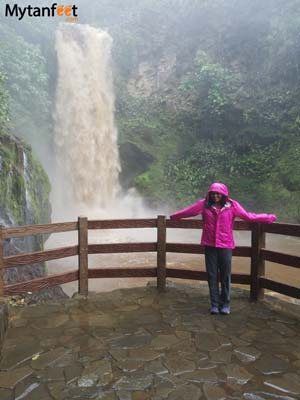
It is very important you come prepared in rainy season since Costa Rica weather can be fairly unpredictable. It can go from a hot sunny morning to a crazy thunderstorm in a matter of minutes.
The same packing list for Costa Rica in dry season but if you’re coming in rainy season, add these to your list:
- Rain jacket/poncho.
- Waterproof backpack or rain cover/waterproof spray. This is a must!
- Sweaters/jackets.
- Long pants and long sleeve shirt
- Hiking clothing.
- Hiking shoes. Waterproof preferable.
We have a complete Costa Rica rainy season packing list with more information.
OK so by now, you might be wondering what specific items to bring for your destinations. Read the section below to find out!
Packing List for Costa Rica: Different Destinations and Activities
Arenal and la fortuna.
This area gets pretty hot and humid during dry season with temperatures in the high 80s F (29 C). If you are staying around Lake Arenal or Nuevo Arenal, it is cooler. In La Fortuna , it gets hot and you can wear shorts, t shirts and sandals.
Hiking: Running shoes or hiking shoes will be fine for most hikes in Costa Rica . In rainy season, I recommend a pair of waterproof hiking shoes or hiking sandals.
Ziplining: No flip flops or loose shoes.
Other activities such as horseback riding, canyoning and white water rafting require closed toed shoes. Closed toed hiking sandals work amazing or water shoes for rafting.
Monteverde sits around 1500 meters (4900 feet) in elevation so it is a lot cooler up there. Dry season temperatures are around high 70s F (25 C) and at night, it gets down to the 50s and 60s F (14 C).
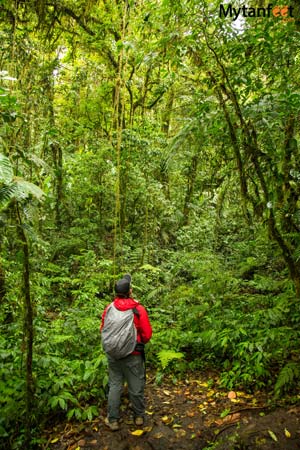
You need to bring a warm sweater/jacket and long pants for Monteverde. Also expect to run into spring showers even during the dry season months of March and April. Waterproof equipment and clothing is a must for rainy season in Monteverde.
Hiking the cloud forest reserves: Bring a rain jacket and wear closed toed hiking shoes. Some of the reserves have rain boots for rent.
Osa Peninsula (Corcovado National Park, Puerto Jimenez, Drake Bay) and Costa Ballena (Uvita, Dominical, Ojochal)
The Osa Peninsula and Costa Ballena are very humid all year long. Closed toed hiking shoes are a must for the national park. Trails are well laid out in Corcovado National Park but if you’re doing the walk from Leona to Sirena station, you will have to cross some rivers and walk on the beach. Some hotels have boots for rent or you can buy boots in Puerto Jimenez.
If you are visiting in rainy season, I recommend solid waterproof hiking shoes. If you are bringing camera equipment, you need waterproof gear since this area is SO humid and rains hard. Bring 100% waterproof backpacks and ziploc bags.
Must bring items: A micro-fiber towel, a hat, a flashlight, good pair of hiking shoes, lots of mosquito repellent, battery pack, insulated water bottle, quick dry clothes workout clothes, waterproof backpack and an open attitude. You will run into lots of bugs and be hot and sweaty!
The same goes for Sarapiqui . This area is super humid!
Jaco and Manuel Antonio
Both Jaco and Manuel Antonio have similar weather and are hot and fairly humid. Bring all your beach clothes, sunscreen, mosquito repellent, sunglasses, a hat and swimsuit.
Guanacaste (Coco, Tamarindo, Conchal, Samara) and Nicoya Peninsula
The Guanacaste province is extremely hot with a longer dry season. Temperatures are consistently in the low 90s F (33 C) throughout the year. You must bring tons of SPF 50 sunscreen, mosquito repellent, sunglasses, hat and after sun gel. Protect yourself from the sun! An insulated water bottle will be super useful so you can always have cold water.
In dry season, the Nicoya Peninsula is extremely dusty. If you plan to rent an ATV, make sure to bring something to cover your face like Buff Headwear because the dust is incredibly bad there.
Rio Celeste
The Tenorio Volcano National Park where Rio Celeste is rains often so bring a rain jacket, even in dry season. When we visited in April, it poured almost all 3 days we were there.
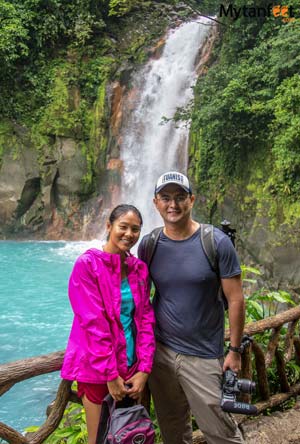
A waterproof backpack is highly recommended (especially for photographers) and hiking sandals or waterproof hiking shoes is also recommended. The national park has rain boots for rent.
Tortuguero and Puerto Viejo
Since The Caribbean coast can rain almost all year long, be prepared for rain. The dry season month is October but believe me, bring your rain jacket still. It’s extremely humid in Tortuguero and Puerto Viejo so fast drying clothes is necessary. If you plan to hike in the national park, you can rent boots as it can get muddy.
A battery pack is highly recommended as Puerto Viejo can get very stormy and the power can go out.
Free Costa Rica Packing Check List
Click here to get our FREE packing checklist with an abridged version of the notes above so you can print it out and refer back to it while you’re preparing for your trip!
Costa Rica Vacation Checklist
- First time to Costa Rica? Read our First Time in Costa Rica guide.
- Not sure how to move around Costa Rica? Read our How to Get Around Costa Rica guide to find the best transportation method for you.
- Do not forget to purchase Travel Insurance for your trip to Costa Rica.
- Stay connected by purchasing a prepaid SIM Card in Costa Rica. Get 10% off your Airalo eSIM package with our promo code “mytanfeet”
- Save money with Mytanfeet Deals for tours and hotels. Save more money with our Costa Rica Car Rental Discount.

Read other Costa Rica travel tips below!
Driving in Costa Rica
Best places in Costa Rica
10 day Costa Rica itinerary
Costa Rica safety tips
Exclusive deals

Costa Rica 10 Day Itinerary (From Liberia): The Best Highlights
White clouds float over green mountains. Hanging bridges sway deep inside mist covered tropical forests. Ocean waves crash on pristine beaches. White waterfalls plunge into turquoise pools. There is never a dull scenery in Costa Rica! The abundance of natural resources in the country and a conscious effort of conversation also make it home to several species of birds and animals. It comes as no surprise that this Central American country is a bucket list travel destination for many people around the world. If you are among them, we have got you covered for your trip planning. We created this Costa Rica 10 day itinerary covering the best highlights of the country.
As Amazon Associate we earn from qualifying purchases. Thanks for supporting Paradise Catchers.
Watch our YouTube video below about the essence of Costa Rica and get inspired to book that ticket!
Table of Contents
Costa Rica 10 Day Itinerary
To help you plan how to best spend your 10 days in Costa Rica, we shortlisted an assortment of destinations that will give you a glimpse of different diverse ecosystems. The itinerary has been optimized in such a way that you get a taste of beaches, cloud forests, waterfalls, hot springs, volcanoes, wildlife, but without much hassle of long distance travels.
This itinerary is perfect for you if you plan to enter and exit via Liberia airport, one of the two international airports in Costa Rica.
Costa Rica Trip Planning Resources :
Check out Costa Rica Activities to plan your Costa Rica trip. If you have a shorter vacation in mind, consider these 5-day itinerary options.
You can check this Costa Rica itinerary for 2-weeks, if San Jose airport works better for you as points of arrival and departure .
The most convenient way of getting around in Costa Rica is to rent a car .
Must-have things on your Costa Rica packing list: Reef Safe Sunscreen , Insect Repellent , and Rain Poncho . You can read our full packing guide and download the free packing checklist for the Costa Rica trip.
Day 1: Fly in to Liberia – Rio Negro Hot Springs and Waterfalls
After flying in to Liberia airport during the first half of the day, reserve your afternoon for some relaxation and rejuvenation, typical Costa Rica style! Go on a lazy nature walk to explore the Rio Negro series of waterfalls in the jungle. Then pamper yourself by soaking in the Rio Negro hot springs by the river. The setting is therapeutic. During your time at the hot springs, you can also try a volcanic mud bath, which is fun and healing at the same time.
For the first couple of days, you can base yourself in the Rincon de la Vieja area, about 30 minutes drive from the Liberia airport. Hotel Hacienda Guachipelin is a good accommodation option because it is located near the Rincon de la Vieja National Park. Also, the stay here includes free access to all the waterfalls of the area as well as the Rio Negro hot springs, which otherwise you would need to purchase a pass for.
If you arrive in Costa Rica during the second half of the day, treat it as your Day 0. Relax with a nice dinner and a good night’s sleep before you begin your travel adventures the next day.
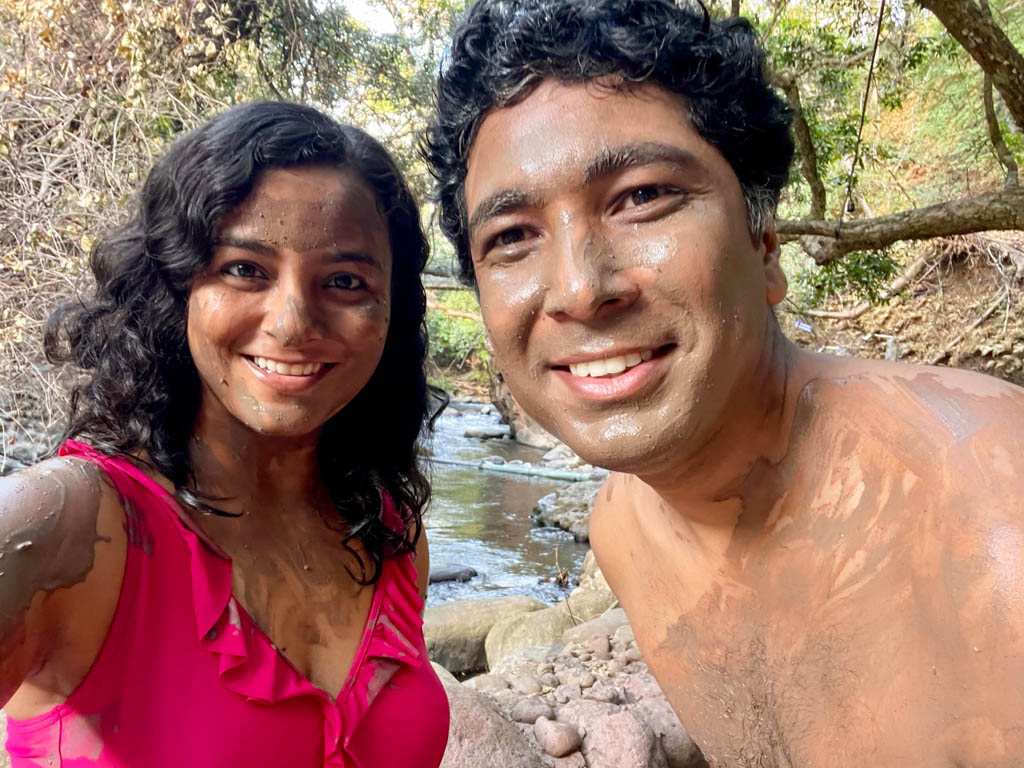
Day 2: Rincon de la Vieja National Park and Oropendola Waterfall
Start early on Day 2 of your Costa Rica trip to visit the Rincon de la Vieja National Park. The park has two main sectors, Santa Maria and Las Pailas. The latter is the one next to the Hacienda Guachipelin property and thus the one you can visit easily on this day. Las Pailas sector has a few trails – the crater trail of Rincon de la Vieja volcano, trails to couple of waterfalls and a trail by the same name as the sector, Las Pailas.
However, if you have 10 days in Costa Rica, you may not want to spend multiple days hiking on different trails of the same national park. So, you need to choose a trail or two for your hikes.
If you are looking for a nice and easy hike, choose the Las Pailas sector for your hike in the Rincon de la Vieja National Park . It is a circular trail of 3.2 km (2 miles) going through tropical rain forests and tropical dry forests. While walking on the well paved trail admiring the interesting vegetation, look out for birds and animals, particularly howler monkeys and spider monkeys, hanging out discreetly around you. But the most interesting part of this Las Pailas trail is the variety of secondary volcano activities like volcanic mud pots, water pots, fumarolic lagoon and more. It is fascinating to watch how amusing our planet is.

Difficult Hikes
If you want a tougher hike, consider one of the waterfall trails or the volcano crater trail. If you decide to do the waterfall hike but are spoilt for choice between the two waterfalls, Catarata La Cangreja and Catarata Escondido, we would suggest La Cangreja waterfall . The gorgeous white waterfall tumbling into a turquoise natural pool is totally worth the effort of the 10 km (6.2 miles) hike.
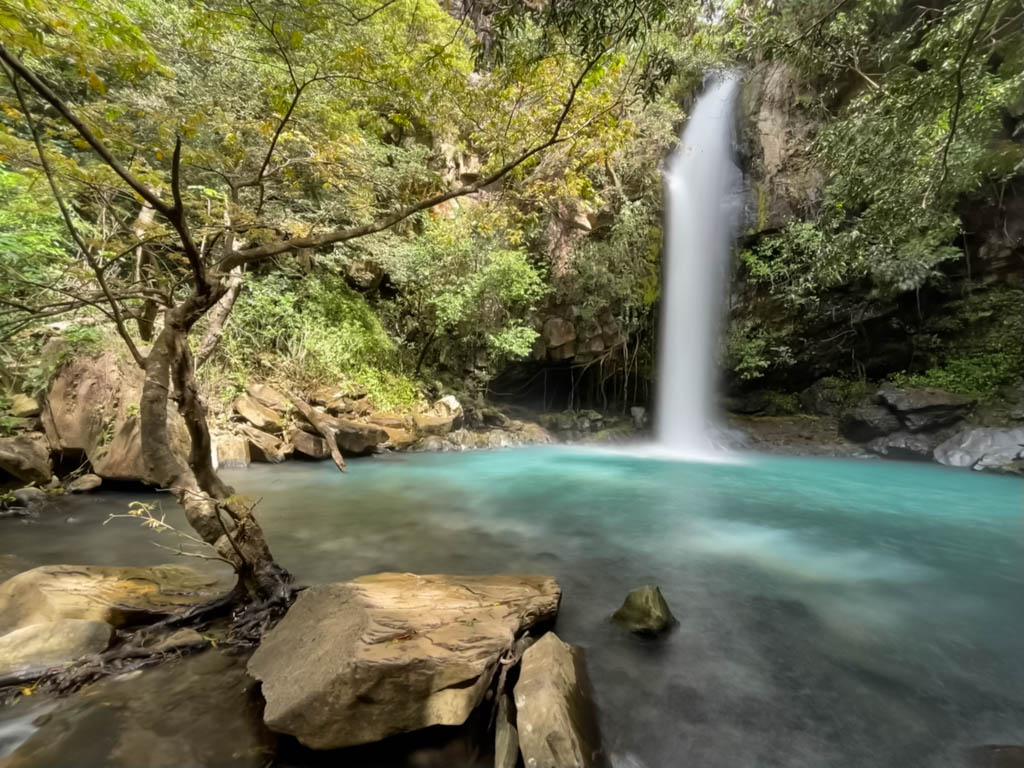
Oropendola Waterfall
On your way out from Rincon de la Vieja National Park, take a quick trip to the Oropendola waterfall located just outside the boundaries of the national park. From the parking lot, you can access the waterfall by an easy walk, including few shaky minutes on a constantly swaying hanging bridge.
Enjoy the views of this wildly beautiful waterfall from the viewing deck. Or take the iron stairs to go down into the emerald pool for a swim and for enjoying the splash of the waterfall.
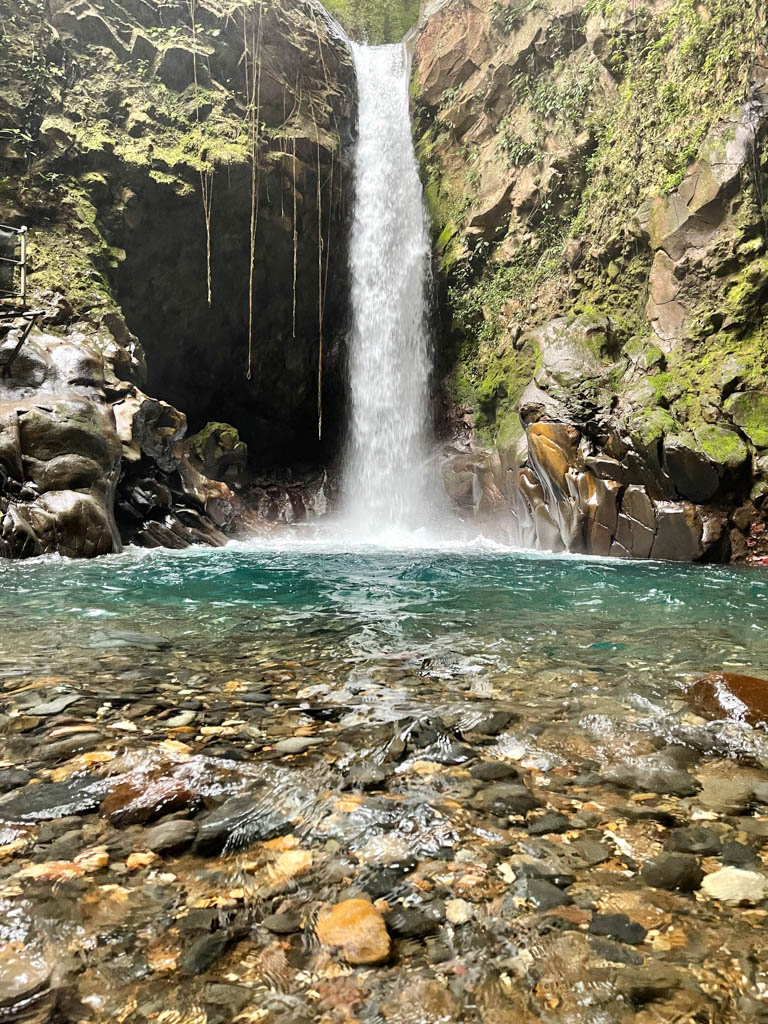
If you prefer organized guided tours, you can also check the following tour options that offer guide, lunch and transportation including free pick and drop from hotels in the Tamarindo, Conchal, Flamingo areas and/or the resorts in the Gulf of Papagayo.
If you prefer a private tour, here is an option –
There are ziplining and river tubing options in the area apart from the hot springs. So you can check this to ur for these experiences.
Day 3: Liberia to Monteverde – Monteverde Night Walk
On Day 3, check out from your hotel in Rincon de la Vieja and start your journey towards Monteverde, the cloud forest haven of Costa Rica . The trip should take between 2 and 2.5 hours, without any stop.
Apart from its cloud forests, this mountain town is also known for several exciting activities and attractions, and hence your next couple of days in Monteverde are going to be packed. So you might as well take the first day easy.
Afternoon Relaxation and Sunset
After arriving in town, treat yourself to a filling lunch at one of the many nice restaurants of Monteverde . Post lunch, spend a cozy relaxing afternoon in your hotel room or at a coffee shop, sipping a cuppa and reading a book, while enjoying the cool climate and lush mountain views. This afternoon in Monteverde can be the epitome of your much needed tranquility.
As the afternoon progresses, head towards one of the vantage sunset points in Monteverde to see the perfect orange sun setting over the Gulf of Nicoya with the backdrop of the mountain landscape.
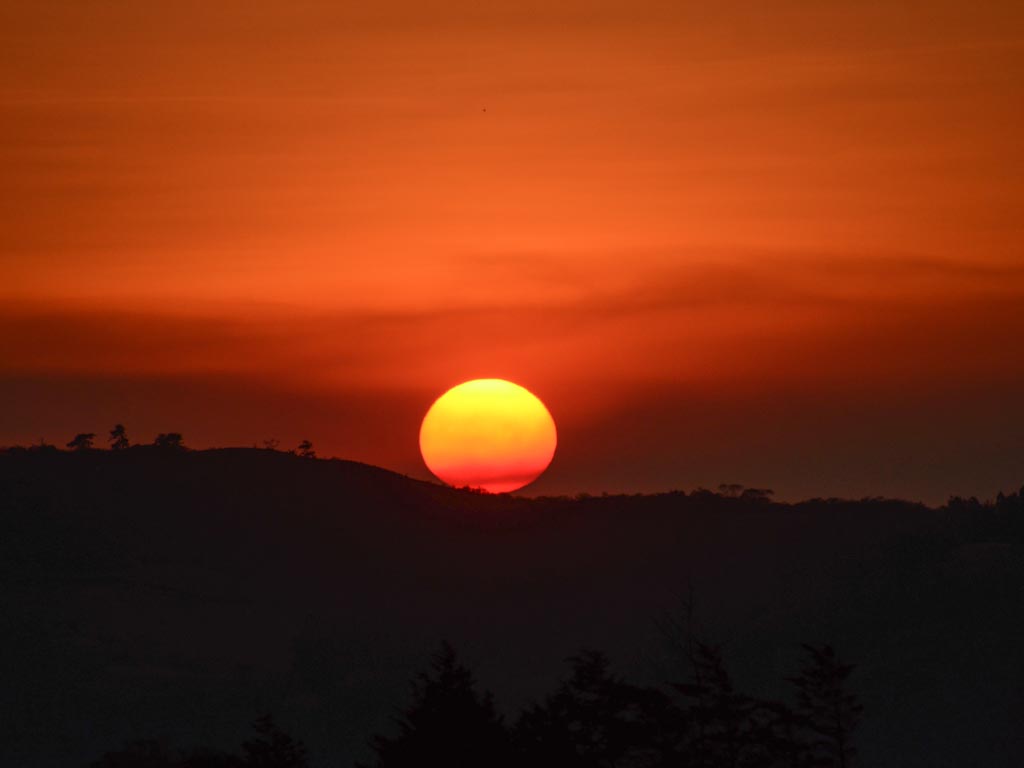
Monteverde Night Walk
If you are re-energized after all the day’s rest, you can still fit in a Monteverde activity on this Day 3 of your Costa Rica 10 day itinerary. With various ongoing conservation efforts, Monteverde has retained its natural biodiversity and thus is home to several species of flora and fauna. So, you are never far from the elements of nature in Monteverde.
But, as the sun goes down, a layer of mystery seems to engulf the forests of Monteverde which come alive with all kinds of sounds in the darkness of the night. This is when you get the chance to spot several nocturnal birds, mammals, arthropods, amphibians and reptiles. The best way to experience this night time forest of Monteverde is by going on a guided night tour. Check this out for all the details on how you can plan your Monteverde night walk.
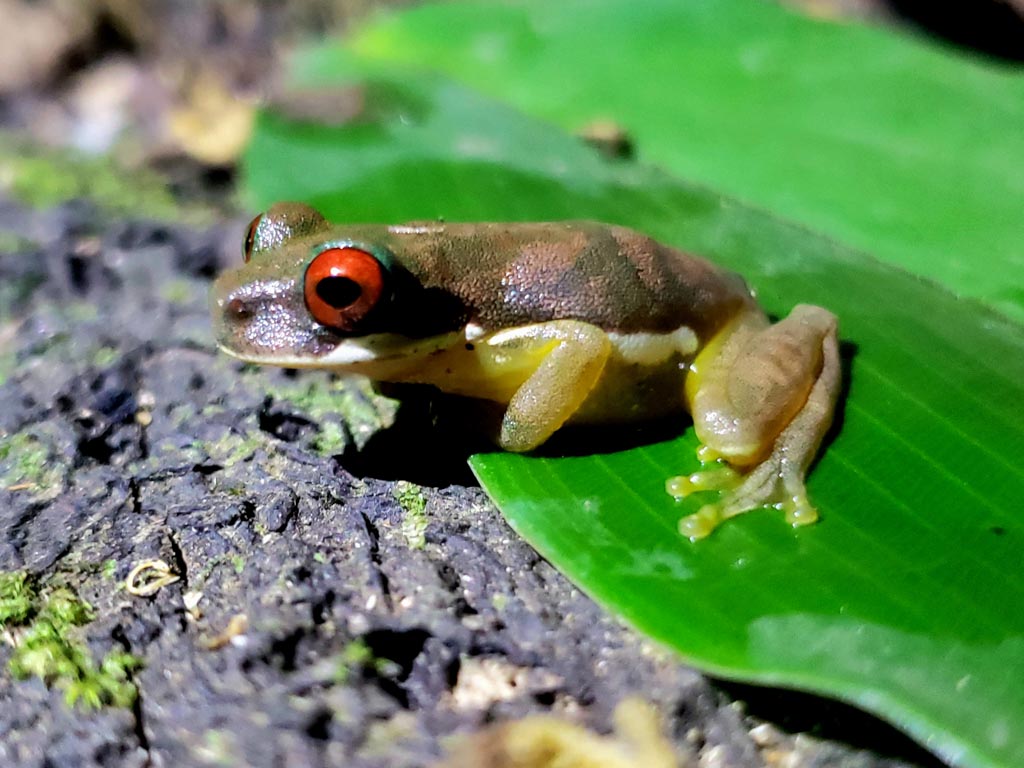
Day 4: Monteverde – Zip-lining and Hanging Bridges
This day of your Costa Rica 10 day trip is bound to give you the ultimate adrenaline rush.
Go on a zip-lining and hanging bridges combo tour. Experience the cloud forests of Monteverde from close quarters and get transported to a different world of solitude and serenity, while still experiencing an adrenaline boost.
Based on your preferences, you can also choose to go for either the hanging bridges walk or the zip-lining tour, if not both. Most adventure parks in Monteverde offer both the tours, individually and as combo, which you can also pair with some other lighter activities, based on the package you purchase. Sky Adventures and Selvatura Park are the most prominent among all the adventure parks in Monteverde.
Monteverde Hanging Bridges
Walking on the hanging bridges is a hiking activity of about 2 to 2.5 hours. You follow the well marked nature trail which also takes you through a series of high and long suspension bridges. As the bridges are constructed near the canopy level, you can enjoy unique perspectives of the forests, including eye level sightings of several birds and monkeys at the forest canopy.
Typical of cloud forests, the forests often wear blankets of passing clouds. So, when you walk on the hanging bridges, some of which are as high as 164 feet, you get the feeling of walking over the clouds!
You can go for a self-guided tour or a guided tour. While you can definitely enjoy the hanging bridges on a self-guided walk, on a guided tour, the naturalist guide can help you with better wildlife sightings. And you also get to learn more about the natural biodiversity of the area.
For comparisons of different hanging bridges tours of Monteverde, and details on how to book the tour, what to expect and how to prepare for the tour, read this post on hanging bridges of Monteverde .
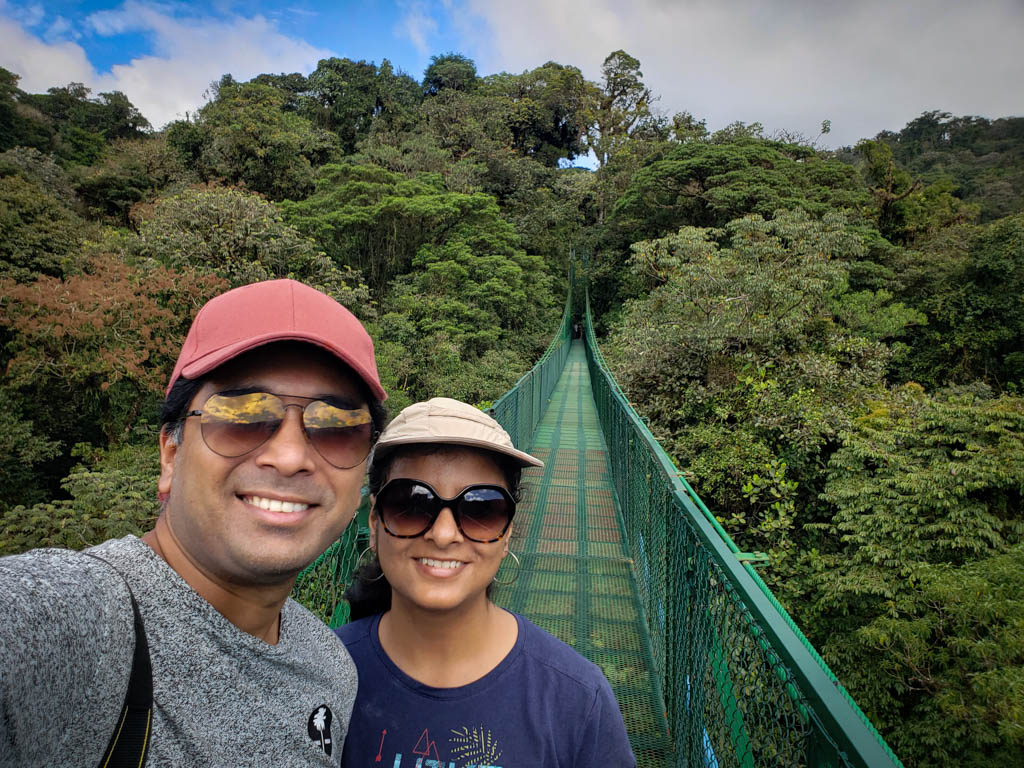
Monteverde Zip-lining
If walking over the clouds on the hanging bridges gives you a high, how about taking the experience one notch higher? On the zip-lining tour in Monteverde, you get the feeling of flying over the cloud forest!
The zip-lining tour also takes about 2 to 2.5 hours. Staying attached to the zip-line through a harness, you zip across from one platform to another. As you glide in air, enjoy the views of the vast expanse of the cloud forests. Some tours include an optional Superman zip-line at an extra fee. If you opt for this, you get to experience a bird’s eye view of the forest as you slide along the zip-line in a Superman like position.
Zip-lining in Monteverde is a guided activity (of course!). The group of zip-lining tour customers is always accompanied by a professional crew. They will guide you about safety features, assist you with the gear, and help you with take-off and landing on every line.
For comparisons of different zip-lining tour providers of Monteverde, and details on how to book the tour and what to expect, read this post on zip-lining in Monteverde .
Here are some snaps from our zip-lining adventures at Sky Adventures and Selvatura Park in Monteverde.

For organized guided tours, check out these options here and here . Also, you can check the tours on Viator below –
Day 5: Monteverde – Bird-watching and Cloud Forest Hiking
The next day in Monteverde is also filled with activities, but they are more calming than thrilling, like birding and hiking. But you will be burning a lot of calories as the day involves quite a few hours of walking.
The previous day you walked over the clouds of the cloud forest and zip-lined high above the cloud forest canopy. Today, it is time to keep your feet on the ground (pun intended) . Explore the cloud forests of Monteverde from inside. Go for hiking in the cloud forest reserves, after going for (an optional) birding tour in the morning.
Curi Cancha Reserve
Around 400 species of birds have been recorded in Monteverde. Many of these birds, with their brilliant colors and amusing behavior, are a delight to watch. One such bird is the elusive Resplendent Quetzal. Monteverde is one of the very few places in Costa Rica where you can spot this majestic looking bird. Otherwise, you can spot Quetzals in San Gerardo de Dota or Los Quetzales National Park , which are not part of this Costa Rica 10 day itinerary.
The best way to enjoy the birds of Costa Rica is by going on a bird-watching tour. Curi Cancha Reserve in Monteverde is a great birding destination as it has several nature trails including some along open landscaped spaces, which make bird sighting easier.
Go for an early morning tour for better chances of birding and also to fit in other activities for later in the day. You can go for self-guided tour from 7:00 am onward, whereas the guided tour starts at 6:30 am. Read this post for details on the trails and viewpoints of Curi Cancha reserve and how to book the tour .
This guided bird-watching tour with a local guide includes entry tickets. If you have transport and bought the entrance tickets, here is another excellent option .
If you are not a birding enthusiast, you can skip Curi Cancha and instead start the next activity earlier.
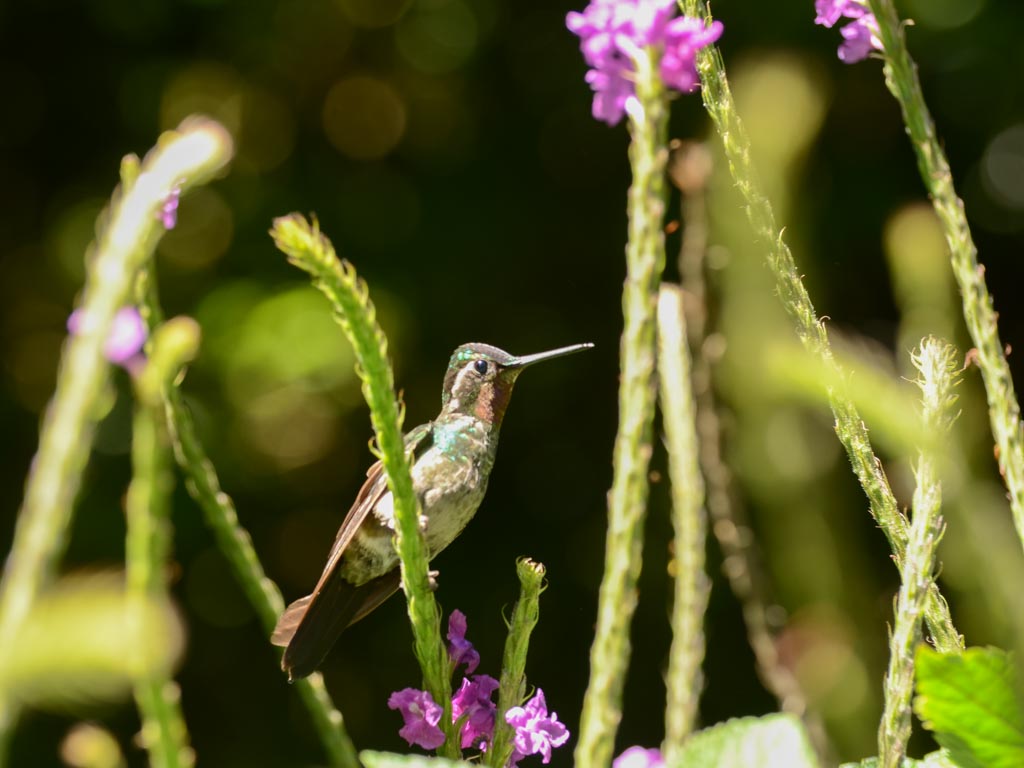
Hiking in the Cloud Forest Reserve
There are 3 major reserves in Monteverde, each special in its own way. You can include any one of these 3 reserves in your Costa Rica 10 day itinerary. None will disappoint the nature lover in you.
Monteverde Cloud Forest Biological Reserve
Established by the Quakers, the pioneers of the Monteverde community settlement, this reserve has 8 trails of lengths varying between 0.2 km (01. mile) and 2 km (1.12 miles), with some intersections/ connections among them. Apart from the cloud forests, Monteverde Reserve has several other attractions like diverse vegetation, wildlife sightings, river trail and waterfall. But the major highlights of this reserve are a hanging bridge and a viewpoint of the Continental Divide.
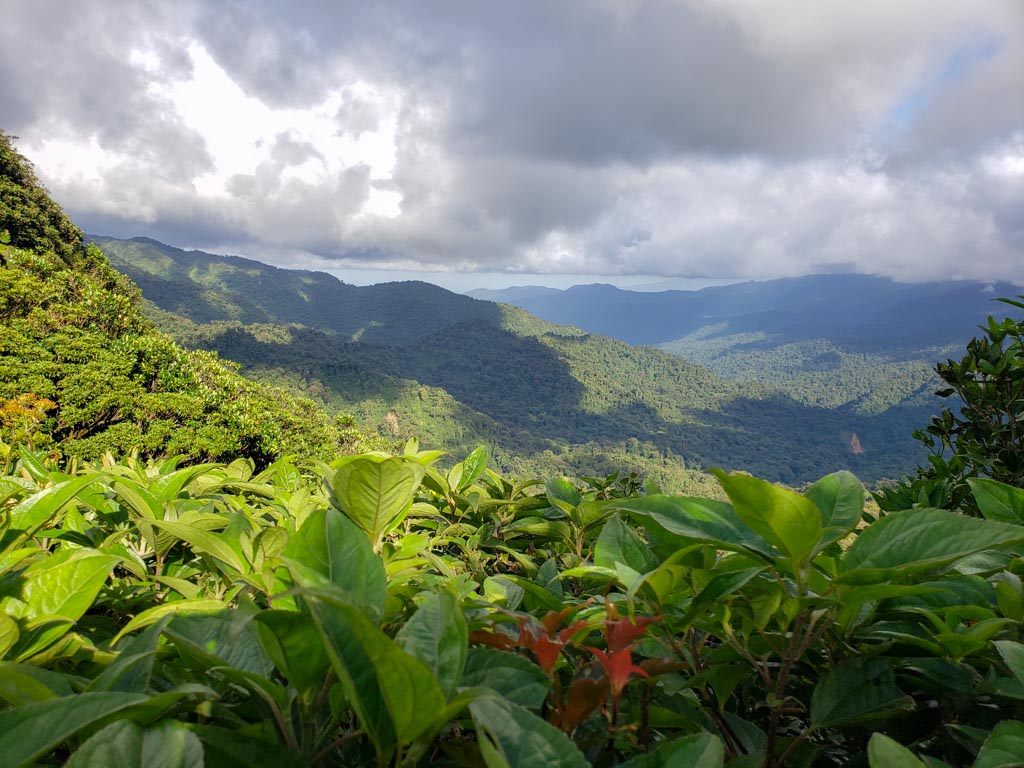
Santa Elena Cloud Forest Reserve
Situated at a higher elevation, Santa Elena Cloud Forest Reserve gives you an immersive cloud forest experience. The reserve has 5 different trails covering a distance of 12.5 km (7.8 miles) in total. One of the highlights of the Santa Elena Reserve is the observation tower. From the tower, you can see 4 volcanoes, including the Arenal Volcano on a clear day. For more details, read our complete guide to Santa Elena Cloud Forest Reserve .
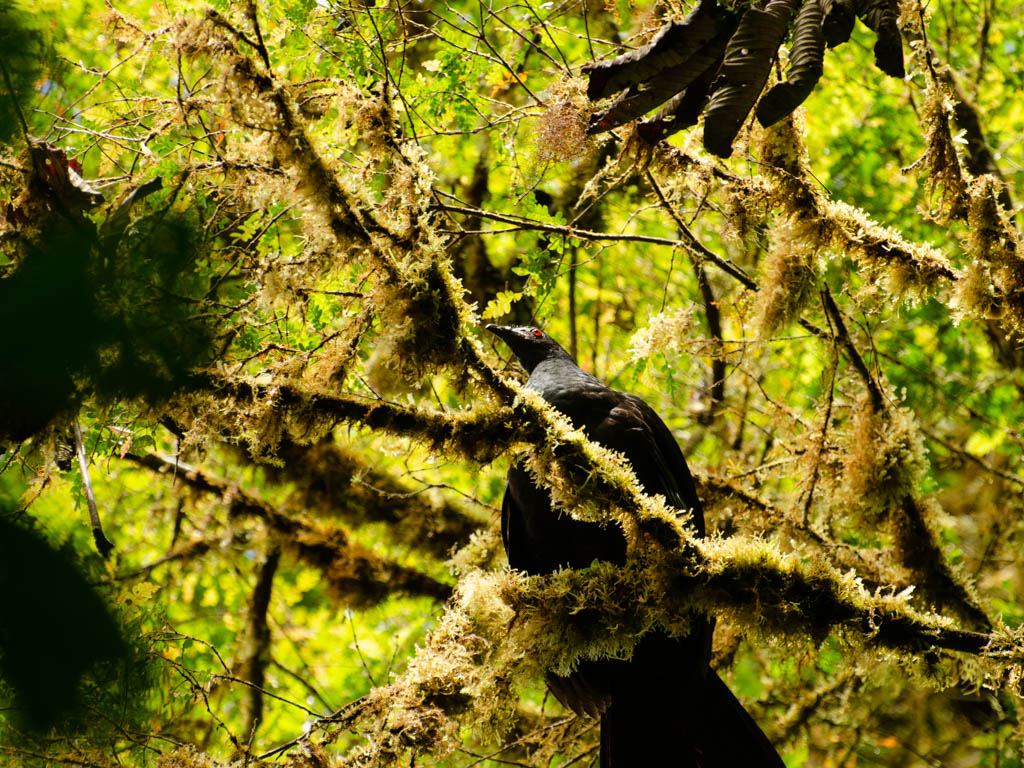
Bajo del Tigre Reserve, Children’s Eternal Rainforest
Bajo del Tigre is a small sector of the largest reserve in Costa Rica, Children’s Eternal Rainforest. The reserve has 3.7 km (2.3 miles) of trails which are mostly flat and easy to walk on. There are also benches in some parts for resting. This reserve is perfect for families with kids and elderly people. Bajo del Tigre reserve is positioned in a transition zone of wet to seasonal moist. Thus, you also get to enjoy the rain forest experience here. For planning your trip to this reserve, read our complete guide to Bajo del Tigre Reserve .
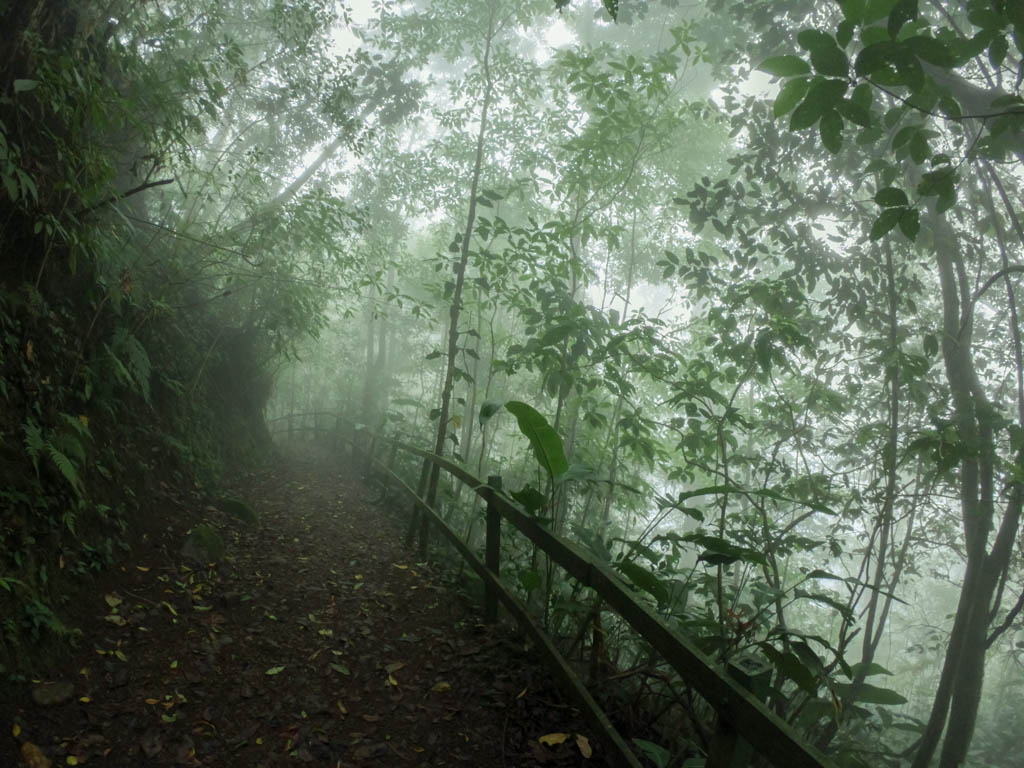
Day 6: Monteverde Coffee Tour – Monteverde to Playa Avellanas
On your last morning in Monteverde, spend some time learning about the other thing Monteverde is famous for. Its coffee. Sign up for a coffee farm tour which lasts for about 2 to 2.5 hours. On this tour, you will get to learn more about coffee farming, processing and roasting. El Trapiche and Don Juan Monteverde offer 3-in-1 combo tour of coffee, cocoa and sugarcane, while Cafe Monteverde gives a more in-depth coffee experience mapping it against social and economic context.
After wrapping up the coffee tour by afternoon, it is time to say good bye to Monteverde and proceed to your next destination, Playa Avellanas. It is a less developed beach in a village of the Guanacaste province of Costa Rica. The drive from Monteverde to Avellanas takes around 3 hours. So, you may reach town just in time to catch a beach sunset at Playa Avellanas.
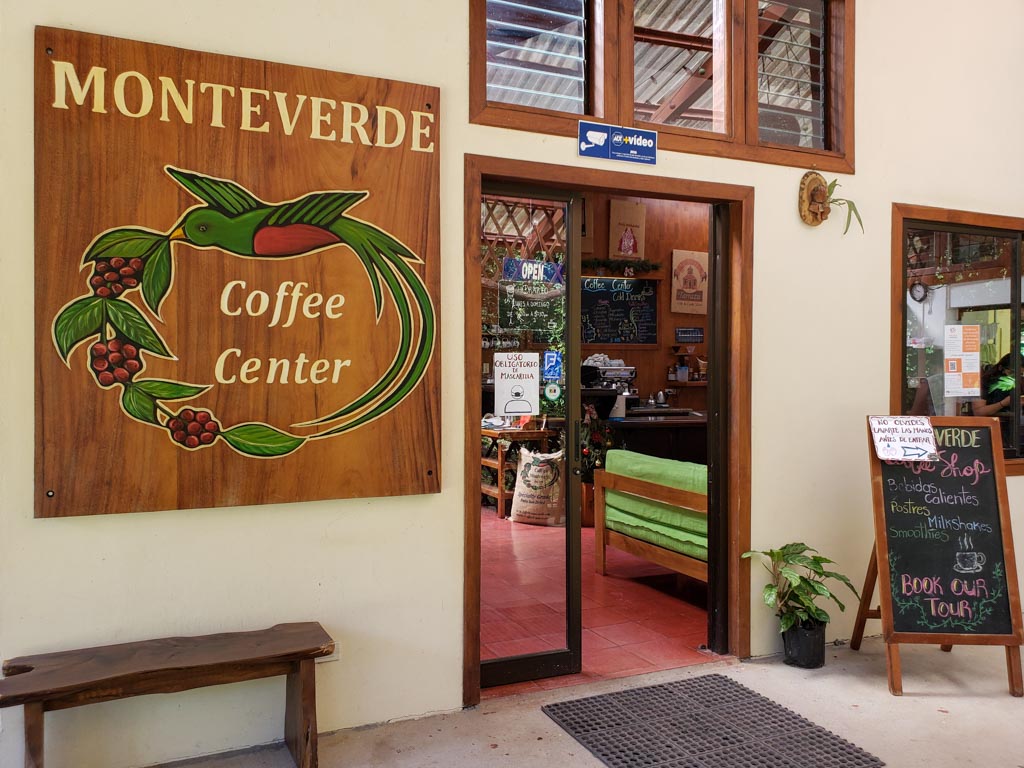
Alternative Destination Recommendation for Monteverde: Days 4 to 6
You can swap Monteverde with La Fortuna . It is an equally exciting destination, and takes around the same amount of time to reach from Liberia as Monteverde.Monteverde is great for cloud forests, cool mountain climate, wildlife sighting opportunities, hanging bridges and zip-lining. Lying in the northern plains region, La Fortuna is known for the famous Arenal Volcano National Park , Arenal Lake, rain forests, hanging bridges , zip-lining, bird-watching and sloth-sighting opportunities , La Fortuna waterfall and volcanic hot springs among others. From La Fortuna, you can also take a side trip to the magical Rio Celeste waterfall .
La Fortuna activities and tours: You can check the tours that pack multiple activities in a day. This tour has the La Fortuna hi ghlights or this one that includes the volcanic hot springs as well, in case your stay does not have a hotspring. Also, the coffee tour , sloth-watching tours , and night tour are other interesting activities in La Fortuna and Arenal.
If you are up for some adventure activities, below are some options.
Watch our YouTube video below about La Fortuna waterfall.
Day 7: Playa Avellanas – Beach Hopping
Avellanas beach.
Although Playa Avellanas is a favorite beach among the locals of Costa Rica, organized tourism is yet to catch up here. And that is what we like the most about Playa Avellanas. You get to enjoy a long stretch of soft sand beach, without the intervention of many beach side constructions. Take a stroll on the beach and watch a perfect beach sunset. Also, walk on the Insta-famous Avellanas Bridge . This wooden bridge is great for photo ops and to see the mangrove marshlands up close.
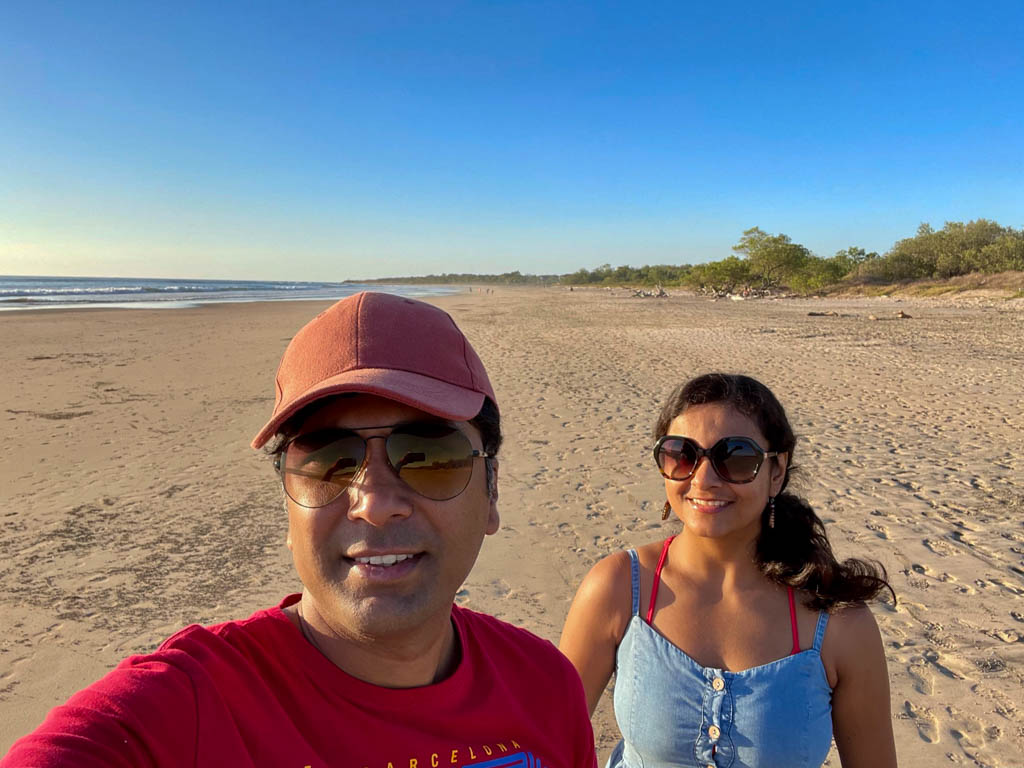
Beach Hopping around Avellanas
Since this is effectively your first beach day in Costa Rica, you may consider scouting the area for other nice beaches that you can return to later. If you keep driving southwards from Playa Avellanas, you will come across a few other beaches within a distance of 10 km (6.2 miles), each having its own character.
At around 2 km (1.2 miles), Playa Lagartillo is the closest to Avellanas. With no souls in sight at this secluded beach, it turned out to be our favorite.
Playa Negra is located around 4.6 km (2.8 miles) south of Avellanas. There is a hotel property by the same name, Hotel Playa Nagra right on the beach, which makes activity at Playa Negra a little more prominent.
Located about 6.7 km (4.2 miles) from Playa Avellanas, Playa Blanca is a beautiful white sand beach. Due to the positioning of the adjacent small cliffs, you can enjoy the clifftop views of the beach. Some luxury residential project development in the area makes the facilities at Playa Blanca a little more organized, like guarded parking.
Playa Junquillal is a 4 km (2.5 miles) stretch of tan sand beach, the main beach of the town of Junquillal. There are quite a few hotels, guesthouses and eateries near this beach. But it still retains a raw beach town flavor.
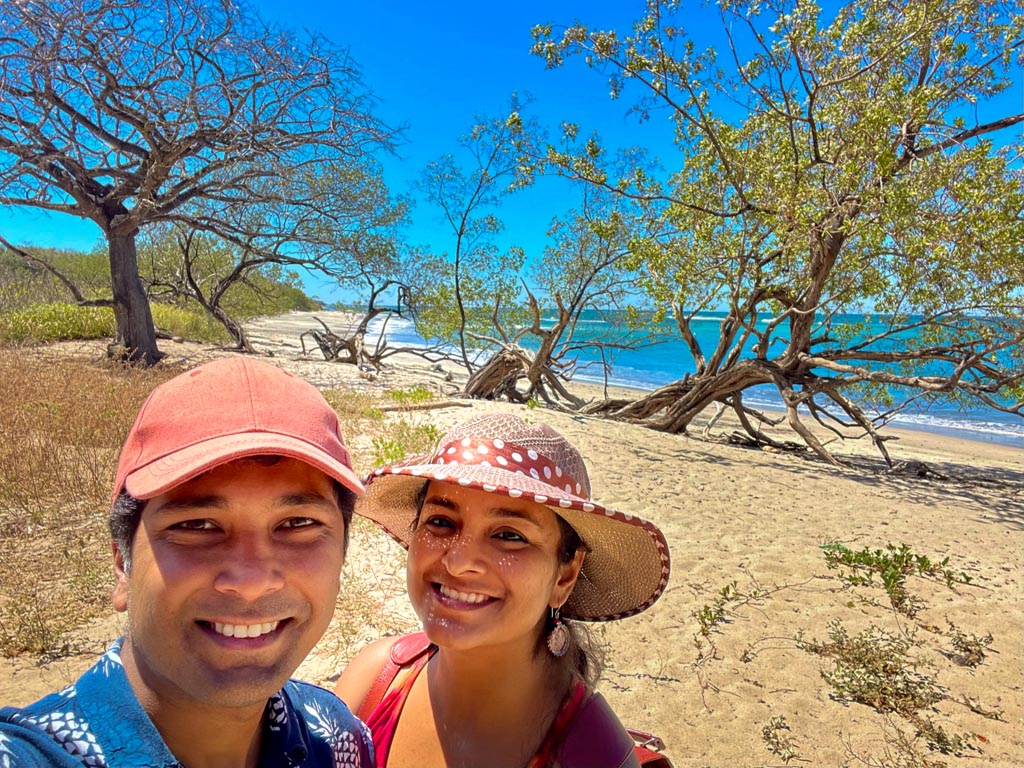
Day 8: Playa Avellanas – Swimming and Surfing
Spend Day 8 of your Costa Rica trip enjoying the warm waters of the Pacific Ocean.
Surfing is one of the best things to do at Playa Avellanas . So, if you are a seasoned surfer, just rent a surfboard and start taking on the waves. If you are a newbie or a beginner, you can sign up for surfing lessons from one of the surf schools. Or just sit on the beach, watching the surfers hone their skills.
Swim in the ocean or laze around under the shades of the trees. When you are hungry or thirsty, grab a bite and a drink at the iconic Lola’s restaurant on the beach.
There is not much of a nightlife at Avellanas. So you can conclude the day with a dinner at a nice restaurant. Kon-Tiki near Playa Negra has great wood-fired pizza which you can pair with a glass of wine.
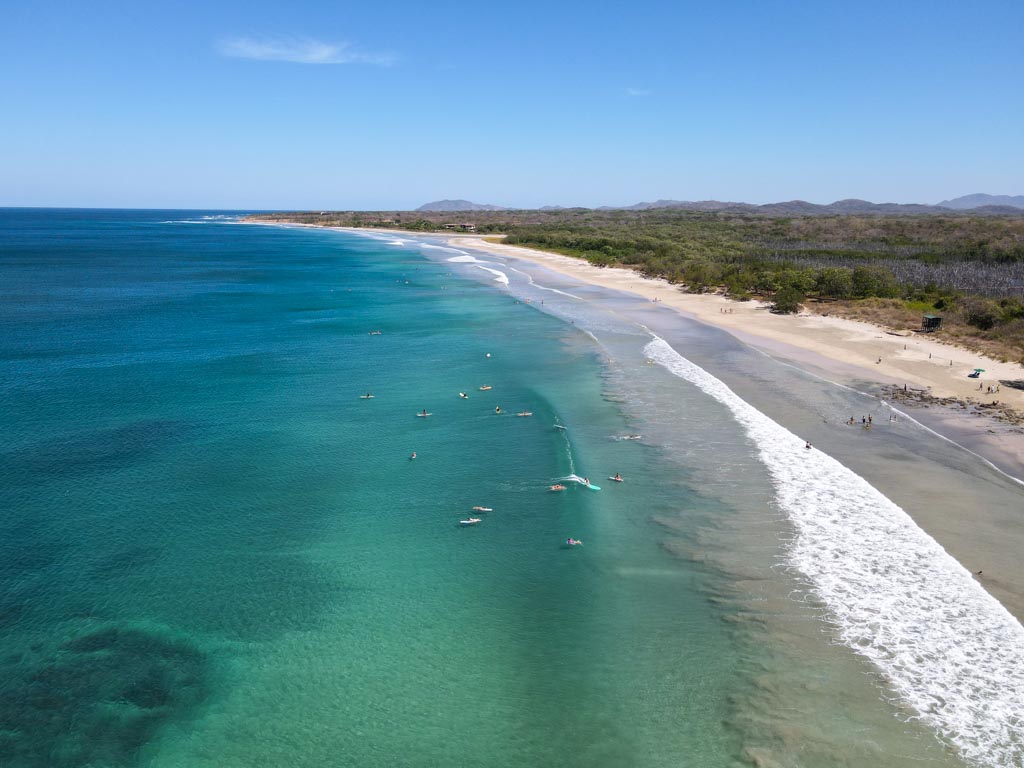
Read about other surfing beaches of Costa Rica:
Playa Carmen , Playa Hermosa , Playa Dominicalito , Malpais , Santa Teresa .
Day 9: Playa Avellanas / Tamarindo
To get the feel of a busier beach town, head to Tamarindo for your last night in Costa Rica. Tamarindo also has great surf breaks, a nice beach, several other great beaches within an hour’s driving distance and great sunsets. But Tamarindo is always bustling. There are scores of hotels, restaurants, stores, souvenir shops, all packed in the town center, and spread out in the vicinity as well. That is why the nighttime is also quite active in Tamarindo.
Tamarindo is around 40 minutes drive from Avellanas. So, if you check out before noon from Avellanas, you can grab lunch at Tamarindo, surf and swim in the afternoon, watch sunset from a rooftop bar and then end the day with fine dining at one of Tamarindo’s finest restauarants.
But if you enjoy the slow pace at Playa Avellanas, you can skip Tamarindo. Stay back at Avellanas for another day of surf, swim and sunset.
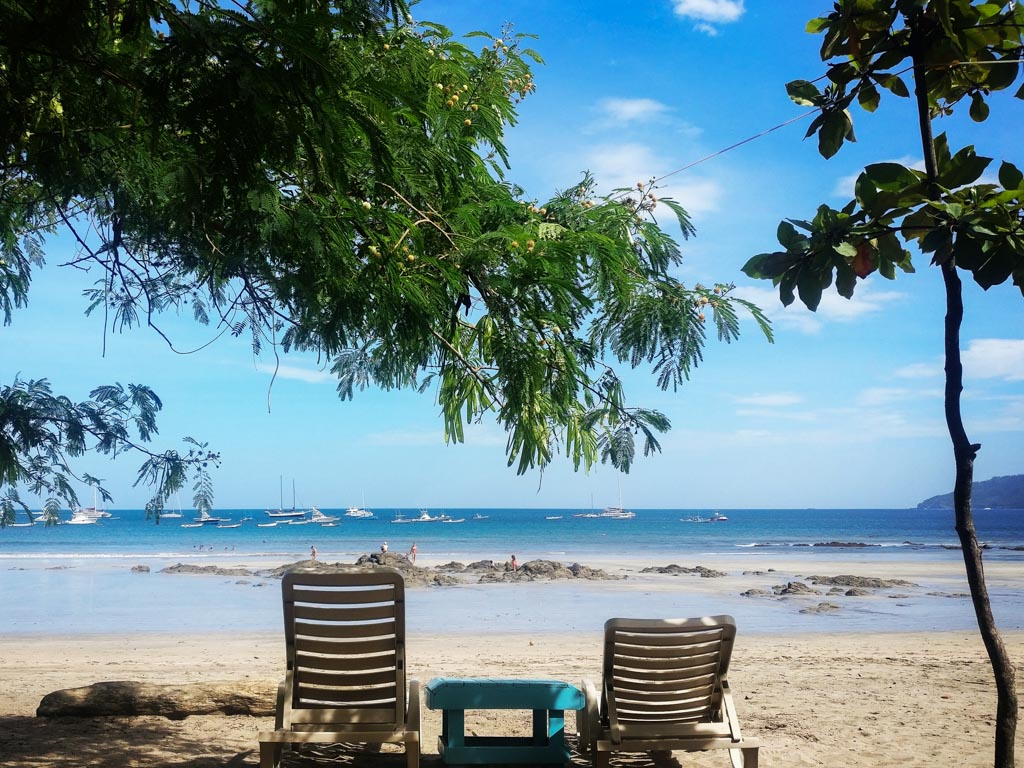
Check out a couple of interesting tour options from Tamarindo. This sunset and snorke l tour gives you a break from the beach on a catamaran cruise in the Pacific. If you want to have a full-day tour of the neighboring Nicaragua , you can consider the tour below.
Alternative Destination Recommendation for Avellanas Beach: Days 7 to 9
If you prefer bustling beach towns over quieter ones, replace your Avellanas days with Tamarindo. If you prefer something in between, like not too touristy, neither lacking development, consider Nosara. Choose between Playa Guiones and Playa Pelada in Nosara. Another great beach town in Guanacaste is Samara.
Day 10: Fly out from Liberia
Keep the agenda wide open for the last day of your Costa Rica 10 day itinerary. You need not schedule any activities in advance. But depending on the time of your flight, you may be able to sneak in one last ocean swim or one last nature walk.
The duration for transfer to Liberia airport will depend on your last destination. It can take between 1:15 hours and 1:30 hours from Playa Avellanas or Tamarindo, around 2 hours from Samara and 2:15 hours from Nosara. So, plan your airport transfer accordingly.
As you conclude this Costa Rica itinerary, reflect on the experiences you have gathered from this land of Pura Vida. It is time to say goodbye for this time and start preparing for the next trip to Costa Rica!
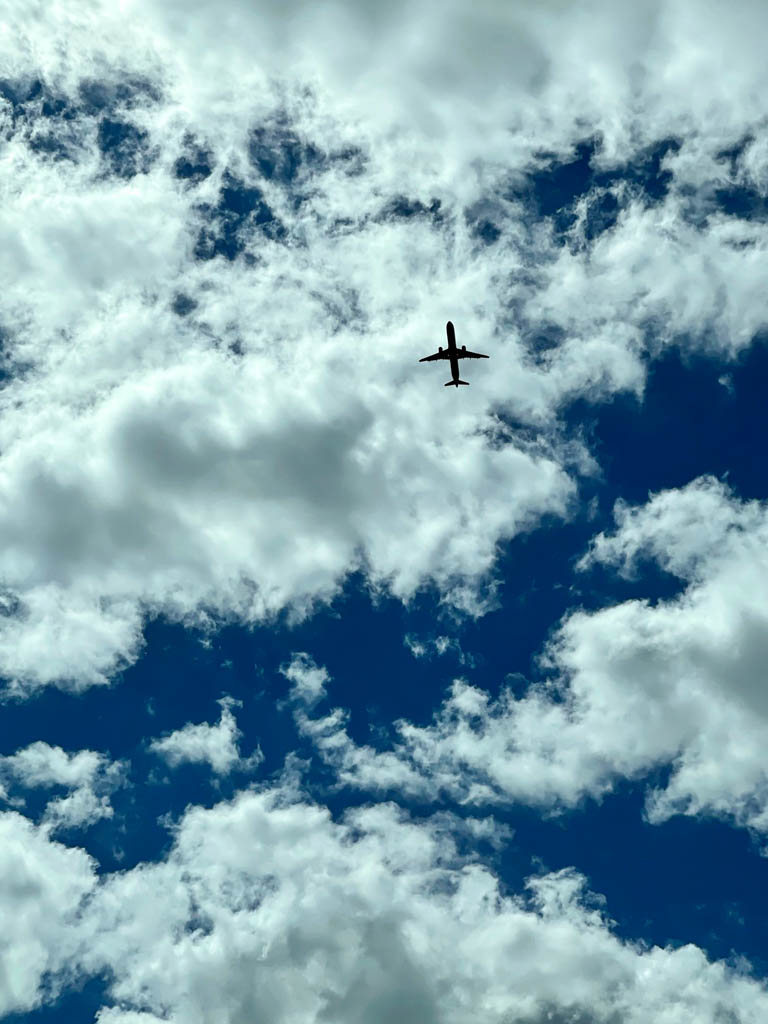
Hotel Recommendations for 10 Days in Costa Rica
In Costa Rica, you can find hotels, hostels and guesthouses of various budget ranges. But almost everywhere, you can expect decent service, clean premises and friendly staff. Here are some of our accommodation recommendations for your Costa Rica 10 day itinerary.
Rincon de la Vieja Hotels
- Hotel Hacienda Guachipelin: It is located in a big property right next to the Las Pailas sector of the Rincon de la Vieja National Park. The hotel offers dozens of rooms, with varying accommodation types such as Standard Room, Superior Room, Family Superior Room, Legacy Suite and Suite. The rooms are nothing too fancy, but work fine with comfortable bed and hot shower. The hotel has a swimming pool, a restaurant and offers secure free parking and free WiFi. But the best part about the stay at Hacienda Guachipelin is that the price of the stay includes free access to the Rio Negro Hot Springs and all other waterfalls of the region. Book your stay here.
Monteverde Hotels
- El Establo Mountain Hotel: It is a high-end hotel with incredible views, two onsite restaurants, a spa and a swimming pool. You can choose from four different accommodation options, Deluxe Double Room, Junior Suite, Suite and Honeymoon Suite. Book your stay here.
- Rainbow Valley Mountain Lodge: It is a mid-range option located on the highway few miles ahead of Monteverde. The accommodation options are Chalet, Budget Double Room, Double Room with Mountain View or Balcony, Suite with Mountain View, Family Room with Mountain View and Suite with Hot Tub. Each accommodation is an independent unit with kitchenette. Book your stay here.
- Cabañas Hoja Verde: It is a private cabin in the woods, great for isolated stays. The cabin features a living room, bedroom, balcony, fully equipped kitchen and a secure parking. Book your stay here.
- Greemount Hotel: It is a family-run budget hotel offering basic no frills accommodation. But you will find everything that you need for a comfortable stay. Comfortable bed, hot water, homemade breakfast, parking, WiFi, a common area with reading nooks and games. The room options are Double Room, Quadruple Room and Family Room. Book your stay here.
For more hotel recommendations, check out this “Where To Stay” section of our Monteverde travel guide.
Playa Avellanas Hotels
- Drift Away Eco Lodge: (This hotel is now the Blue Zone Resort) It is an eco-conscious property, around 1.6 km from Avellanas beach. This sustainable eco-lodge offers King Room, Queen Room, Twin Room and Two Bedroom Villa, each carefully appointed with rustic furniture, sustainably made bed and bath linens and toiletries. The property has beautiful landscaped gardens, a yoga center, a recreation room and a swimming pool surrounded by sculpted statues and fountains. Fair warning, Drift Away Eco Lodge may become the highlight of your days at Playa Avellanas. Book your stay here.
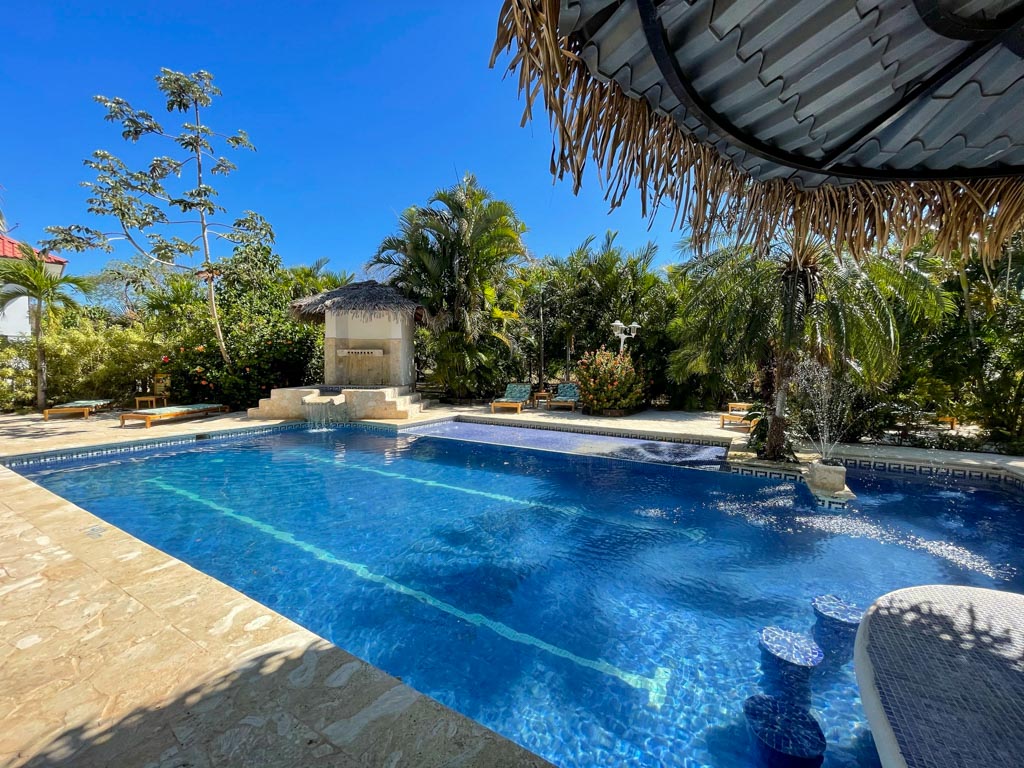
Tamarindo Hotels
- Tamarindo Diria Beach Resort: It is a beachfront property offering more than 200 rooms with ocean or pool views. The resort has 4 onsite restaurants, 1 gelateria, 1 lounge bar and 2 wet bars. There are several pools too, 1 beachfront pool, 1 children’s pool, 1 adults-only quiet pool, 1 scenic pool and 1 hydrotherapy pool. Diria Reosrt also has a casino! Book your stay here.
- Ten North Tamarindo Beach Hotel: It is a mid-range hotel located in the heart of Tamarindo. For your stay, you can choose from room and apartment options, some with pool view or balcony. Book your stay here.
- Jardin del Eden el Boutique Hotel: It is an adults-only boutique hotel, with carefully curated rooms, gardens and pools. This is a great romantic accommodation option, with some rooms offering private spa tubs. The nightly tariff includes breakfast and dinner for all room types. Book your stay here.
- Cala Luna Boutique Hotel & Villas: Located closer to Langosta Beach, it is a boutique hotel with secluded deluxe rooms, private villas with pools for families and luxury adults-only suites. With various well-being offerings like spa treatments, yoga sessions and farm-to-table dinners, you are likely to have an intimate connection with nature at Cala Luna. Book your stay here.
You can search for more Tamarindo hotels here.
What to Pack for 10 Days in Costa Rica?
Check out our comprehensive packing guide for Costa Rica , with a FREE checklist included that should help you at the time of packing your bags.
How to Get Around in Costa Rica?
The most convenient way of getting around in Costa Rica is to rent a car . It gives you the flexibility of timing, routes, and scenic stops. Due to the road conditions in some parts of the country, driving here can turn out to be adventurous. However, for the destinations we covered in this Costa Rica 10 day itinerary, you do not really need a 4X4. A car with high ground clearance should suffice. Compare the prices before you book the rental car, and remember to check the insurance coverage.
We have a Costa Rica Car Rental Deal for you
Our Car Rental Partner: Adobe Rent A Car, 100% Costa Rican company and a trusted name, with transparent pricing.
Click here to make your reservation, with the discount automatically applied. For the details of the deal, read this article .
Car Rental Deal Highlights: ~10% discount on base rate (varies by dates and demand) , free extra drivers, booster seats and baby seats at no extra cost, free door-step delivery of rental car to houses, condos and hotels near Adobe Rent A Car offices.
If you are not comfortable driving in a foreign country, you can ask your hotels to arrange for airport transfers and pick-up and drop-off between destinations. Alternatively, you can opt for public buses for traveling between destinations. For different tours, check with the tour providers if they can include hotel pick-up and drop-off.
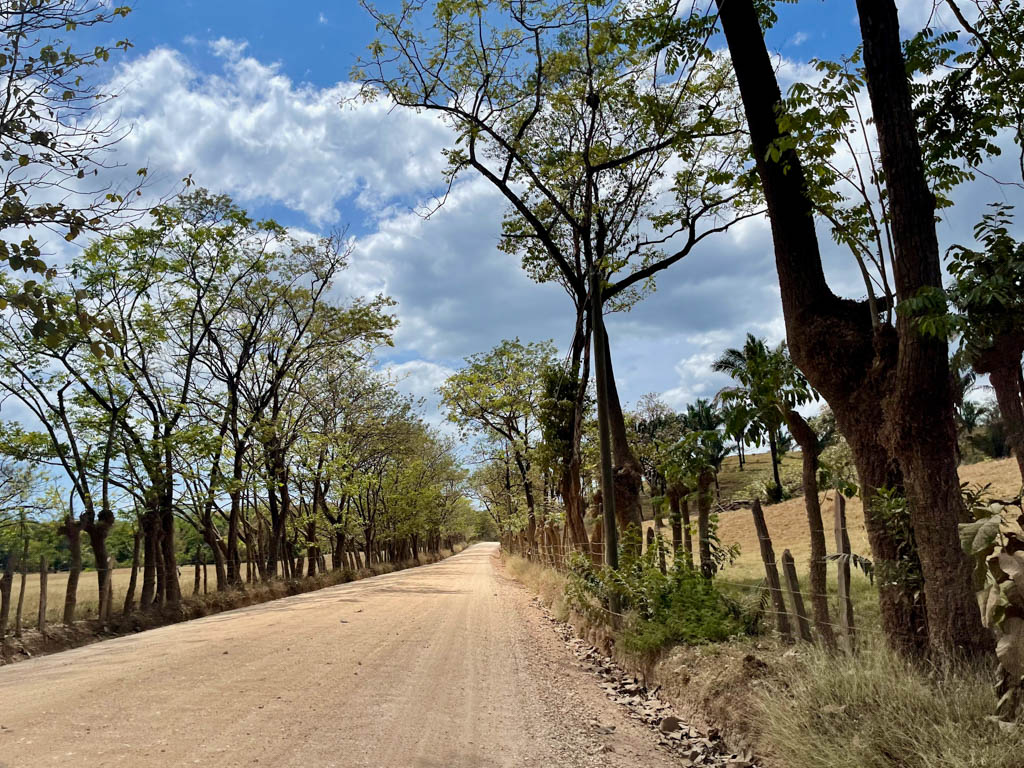
Final Thoughts on Costa Rica 10 Day Itinerary
Costa Rica is a great destination for nature seekers. It offers exciting activities and attractions for all kinds of travelers, families, couples or solo travelers. Ranging from tropical dry forests to tropical rain forests and cloud forests, from mountains to beaches, volcanoes to waterfalls, we explored various landscapes in this Costa Rica 10 day itinerary. Yet there is so much more to discover in this beautiful country in Central America. So, this could be the first of your many trips to Costa Rica. Or, who knows, this trip might as well turn out to be your temptation for moving to Costa Rica !
Like the post? Pin it!

Travel Planning Logistics
- Accommodation: For several years now, Booking.com has been our platform of choice for booking accommodation while traveling. You can apply all the desired filters and shortlist the ones that meet your criteria. On continued use, you will keep unlocking their Genius benefits. For long term stays, we use Airbnb . Of late, we have also started browsing Hostelworld for finding hostels.
- Tours: When traveling to new destinations, you can plan ahead and book your activities. Check for highly rated tours on Viator and Get Your Guide .
- Packing: From swimwear to sunscreen, hiking pants to insect repellents, buy your vacation packing essentials on Amazon .
- Flights: We always start our flight searches with Skyscanner and Momondo . They are aggregators that display flight options, compiling information across airlines and combinations. What we like the best about these flight aggregators is that you can put “Anywhere” as your destination, so that you find the best flight deals from your city of departure.
If you enjoy reading our free travel guides, tips and stories, please consider supporting our work. Thank you .
Disclosure: Please note that this post may contain affiliate links. If you make a purchase or a booking through these links, we may earn a commission at no extra cost to you. Thank you.
Share this:
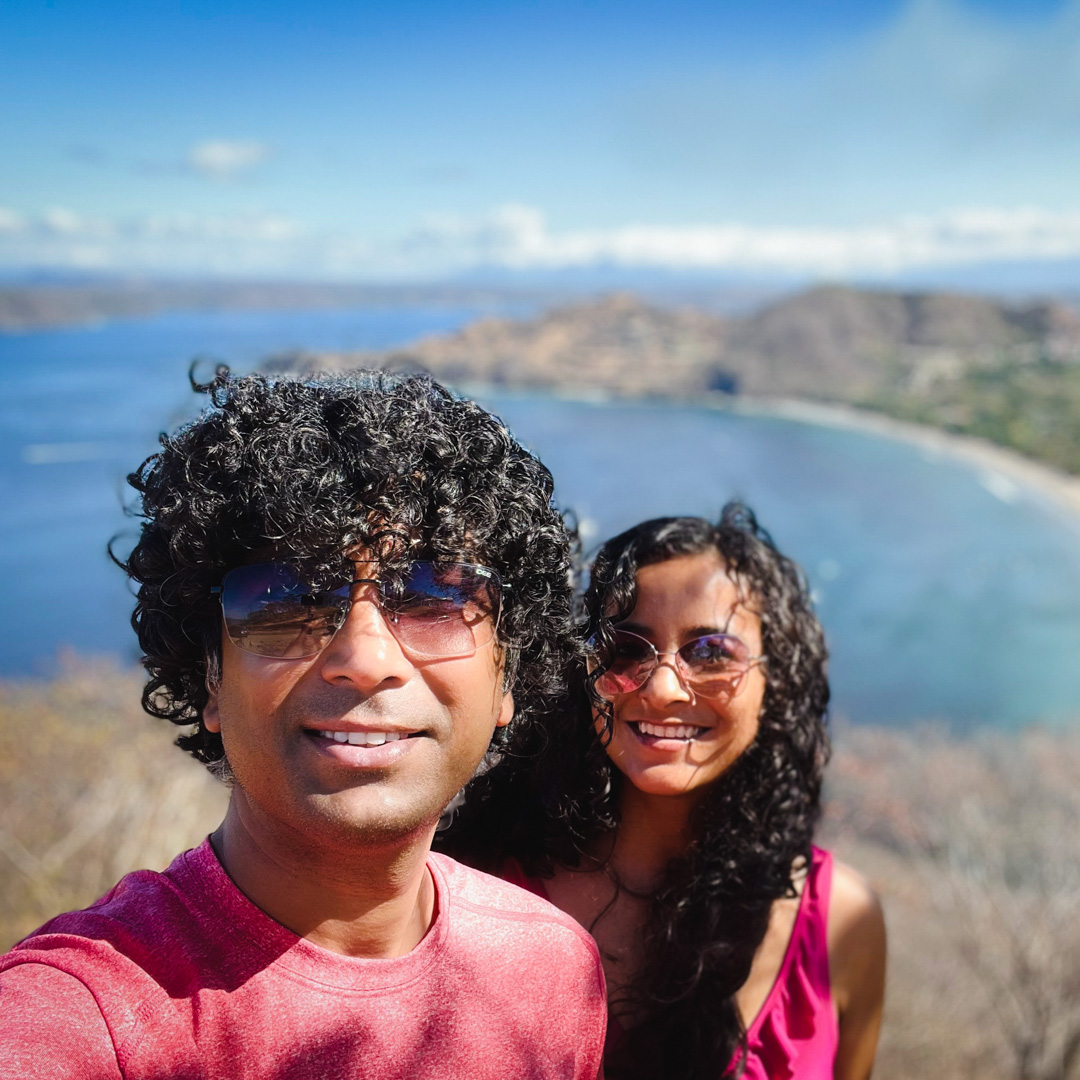
Paradise Catchers
We are Pubali and Indranil, an Indian couple living in Costa Rica and slow traveling Latin America and Caribbean.
21 Best Places to Visit in Colombia
Cerro tortuguero: hiking an inactive volcano, 8 thoughts on “costa rica 10 day itinerary (from liberia): the best highlights”.
Excellent description. Quite precise itinerary. Nice photographs. The presentation must force people to take a trip to Costa Rica.
Thank you 🙂
This is fantastic. We are tempted to follow this almost entirely!
If we are looking to squeeze in La Fortuna, should we swap out Monteverde or Rincon de la Vieja?
Thanks Nitin. You can choose to replace Rincon de la Vieja with La Fortuna, as thematically, both have volcano, hot springs and waterfalls, whereas Monteverde is more of a cloud forest, hiking and adventure kind of destination. Hope this helps 🙂
how much for 10day ecxscursion im in liberia
Hi Russ. Welcome to Costa Rica. How much you spend during10 days in Costa Rica will depend on your accommodation type, transfer/commute modes and chosen activities. Please note, we are not a tour company – so, we do not offer any excursions ourselves but will be happy to share recommendations of noted local tour operators in Costa Rica. Please feel free to send us an email. Thank you.
we are planning a trip for this January and I wonder if you have this itinerary mapped out so I could see it on a map? Thanks – would weather be Ok in early – mid January? Assume we’d need to be prepared for rain regardless since it is a rainforest~. Thanks appreciate your response.
Hi Laurie, we haven’t created a map for this itinerary yet, but good idea – we’ll put it on our things to do for enhancing this itinerary article. Thanks to you! 🙂 Meanwhile, if you need one sooner, please feel free to send us an email with the map request and we’ll respond.
January weather should be fine. Beaches will be hot and humid, but overall lesser chances of rain all over the country. And you are right, pack a raincoat in any case and you will be fine. Enjoy your Costa Rica trip! 🙂
Leave a Comment Cancel reply

Using Radical Candor to Strengthen Relationships at Work and Home with Kim Scott

Building an Investment Portfolio to Grow and Protect Your Wealth with Chris Doyle

Best Tools for Booking Hotels with Points & Miles with Greg the Frequent Miler

Best Tools for Booking Flights with Points & Miles with Greg the Frequent Miler

Reverse Aging and Live Longer with Bryan Johnson

Earn Points Paying Taxes with a Credit Card (+ Latest Deals/News)

My New Routine, Timeshare Pitches, and All the Hacks Plans for 2024

The Science-Based Tactics of Persuasion with Daniel Pink

Buying, Selling, Leasing and Trading In Cars with Car Dealership Guy

Expert Advice on Medical Emergencies and Travel Illnesses with ER Dr. Benjamin Jack

Masterclass on Habits and Becoming a Super Communicator with Charles Duhigg

10+ Hacks to Upgrade Your Brain, Learn Faster and Become Limitless with Jim Kwik

Costa Rica: A Top Travel Destination for Adventure, Rainforests and Relaxation with Javier Echecopar

Finding the Best Deals on Flights with Zach Resnick

Scale Yourself though Delegation, Assistants and Automation with Sam Corcos

Start a Million Dollar Business in a Weekend with Noah Kagan

The Most Powerful Paradoxes of Life with Sahil Bloom

Credit Cards: What's in My Wallet for 2024

Master the Skill of Sleep with Mollie Eastman

Top 10 Takeaways from All the Hacks in 2023

Unlocking Disney Magic: An Insider Guide with Leslie Harvey

Building a More Meaningful and Impactful Life with Scott Harrison

How to Save on Taxes with Ankur Nagpal

This Episode Changed My Perspective on Cruises with Emma Le Teace
- lol Badge Feed
- win Badge Feed
- trending Badge Feed
Browse links
- © 2024 BuzzFeed, Inc
- Consent Preferences
- Accessibility Statement
"I Had 10 Minutes Until My Flight, Only To Discover..." 19 Unfortunate And Avoidable Travel Mishaps That Actually Happened To People
"It was one of the first purchases I made on Priceline back when you’d buy the airfare online, and they’d send paper tickets in the mail..."

BuzzFeed Staff
1. Travel is many things — eye-opening, magical, exhilarating, and, at times, stressful. For example, there's nothing quite like the anxiety-inducing feeling of racing through security just as your flight gate is about to close. Well, Redditor u/yankeevandal asked , "Everyone has a travel blunder; what's yours?" Here are the stories people shared.
2. "put my keys back through the airbnb letterbox, as requested. a few minutes later i realized i needed the keys to access the garage where my rental car was parked. it took an hour and a half for someone to come and let me in. i got to the airport just in time to see my plane take off.".

— u/RedundantSwine
3. "My dad once made reservations for a very nice hotel in Spain in a central location. He couldn't believe how cheap the rooms were and what a good deal it was. He and my mother went to check in, and the hotel said they didn't have any record of the booking. My dad pulled up the confirmation email to show them and realized he had somehow booked a hotel with the exact same name...but in Chile."
— u/gentlybeepingheart
4. "When I was in my early 20s, I went to a nightclub in Istanbul with my girlfriend. Throughout the night, I stupidly ordered several of these half-bottles of champagne that were on the menu with no price listed. Of course, when the bill came, it turned out they had brought me the most expensive bottles, and I could not afford to pay for them. After a long standoff, the club eventually believed I couldn't afford my tab or just gave up and settled the bill for some reasonable amount that I had on me. Obviously, they were trying to take advantage of me, but it was also very stupid that I didn't ask for the price upfront."

— u/Orange_Kid
5. "The plane I was on hit turbulence, and I dislocated both hip replacements. I had to lay in the center aisle for 45 minutes while passing out in pain until we could make an emergency landing."
— u/JonnyP3283
6. "I needed to take a train to the airport in Rome to catch my flight home. So I got on the track where the train to Roma Fiumicino was announced. The train was fast, but it took way longer than I thought it should, and I started to worry a bit about being late for my flight. Then we arrived at the next train station....which was Florence! Somehow I had taken the wrong train (for which I did not have a ticket), and I also missed my flight. I explained the situation to the conductor, who kindly let me stay on until the next stop, Milan, without paying for a new ticket. By the time we reached Milan I had already booked a hotel room and a new flight home the next day. I had never been to Milan, and I had a good time there, so in the end, it worked out."

— u/sumpuran
7. "I made hotel reservations for the wrong weekend. I had to find a new hotel 30 minutes away. The original reservation was for a hotel where I could walk out of my room and directly onto the beach."
— u/mook1178
8. "Booked a train ticket from Rome to Venice and drank way too much the night before. I rolled into the train station with about 10 minutes to spare — only to find out that it was daylight savings time, and I was actually 50 minutes late."
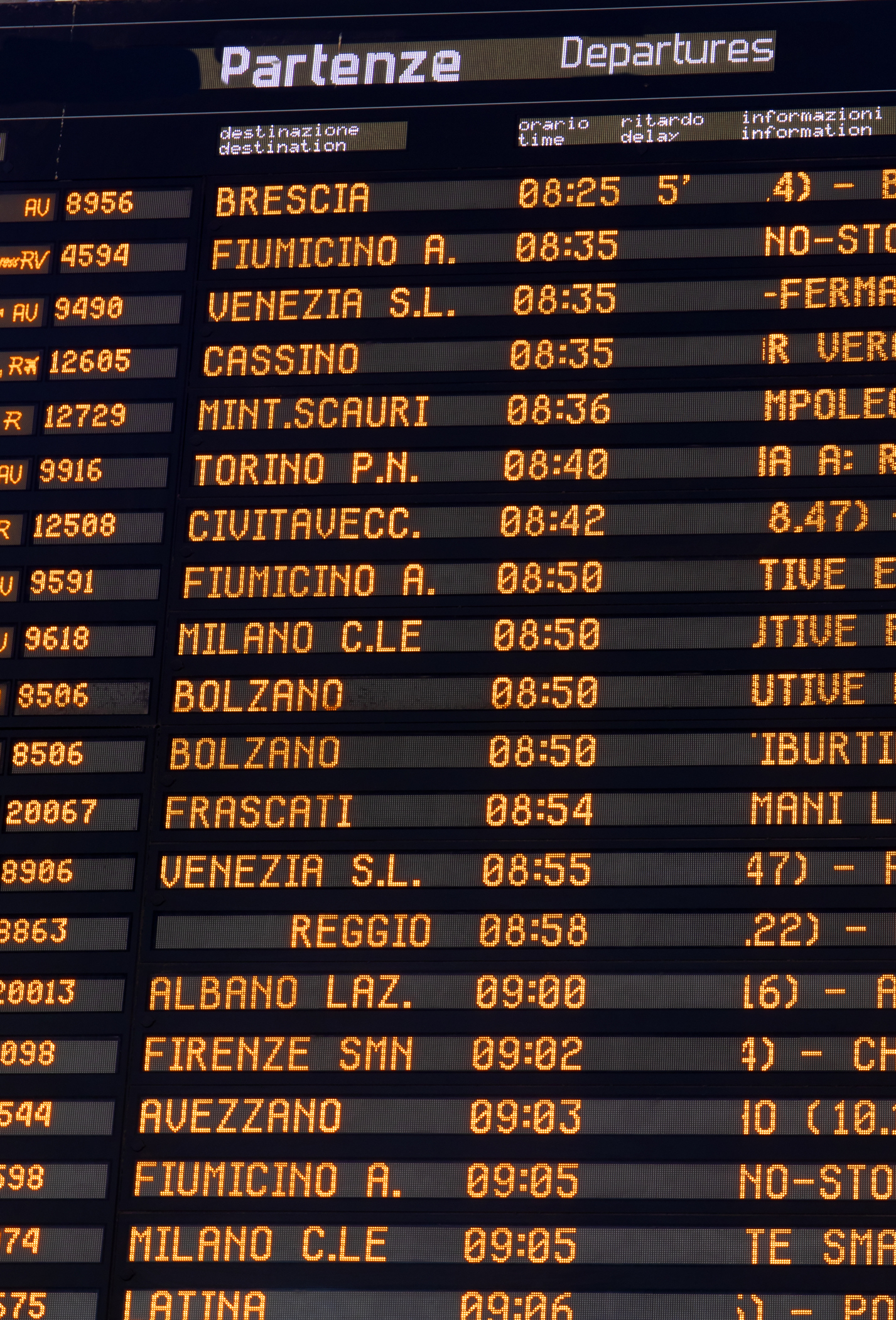
— u/Snazzypants11
9. "I missed my flight home from Ghana to California on a layover in Rome. I told everyone I fell asleep and missed the flight, but in reality, I was sitting at the wrong gate reading a book and didn’t hear my name being called (apparently, the airline was calling my name forever and then left me behind). In my defense, it was a really good book, and I was exhausted from a long travel day."
— u/zeebette
10. "I booked a holiday to Ibiza from the UK while out at a rave. The next day, I discovered that instead of flying from Southampton to Ibiza, I was actually flying Southampton to Amsterdam, Amsterdam to Madrid, and Madrid to Ibiza. What should have been a two-hour flight took most of the day. Whoops."

— u/Ok-Topic-6971
11. "I once read the flight arrival time as the departure time. My girlfriend had to be home for a class by the next morning, so the only option was to make the six-hour drive. She wasn’t stoked with me."
— u/twankyfive
12. "I booked a flight to Manchester, NH, when I was supposed to go to Manchester, UK. I was proud of myself at first for finding a great deal. In my defense, this was years ago, in the early days of the internet. It was one of the first purchases I made on Priceline when you’d buy the airfare online, and they’d send paper tickets in the mail."
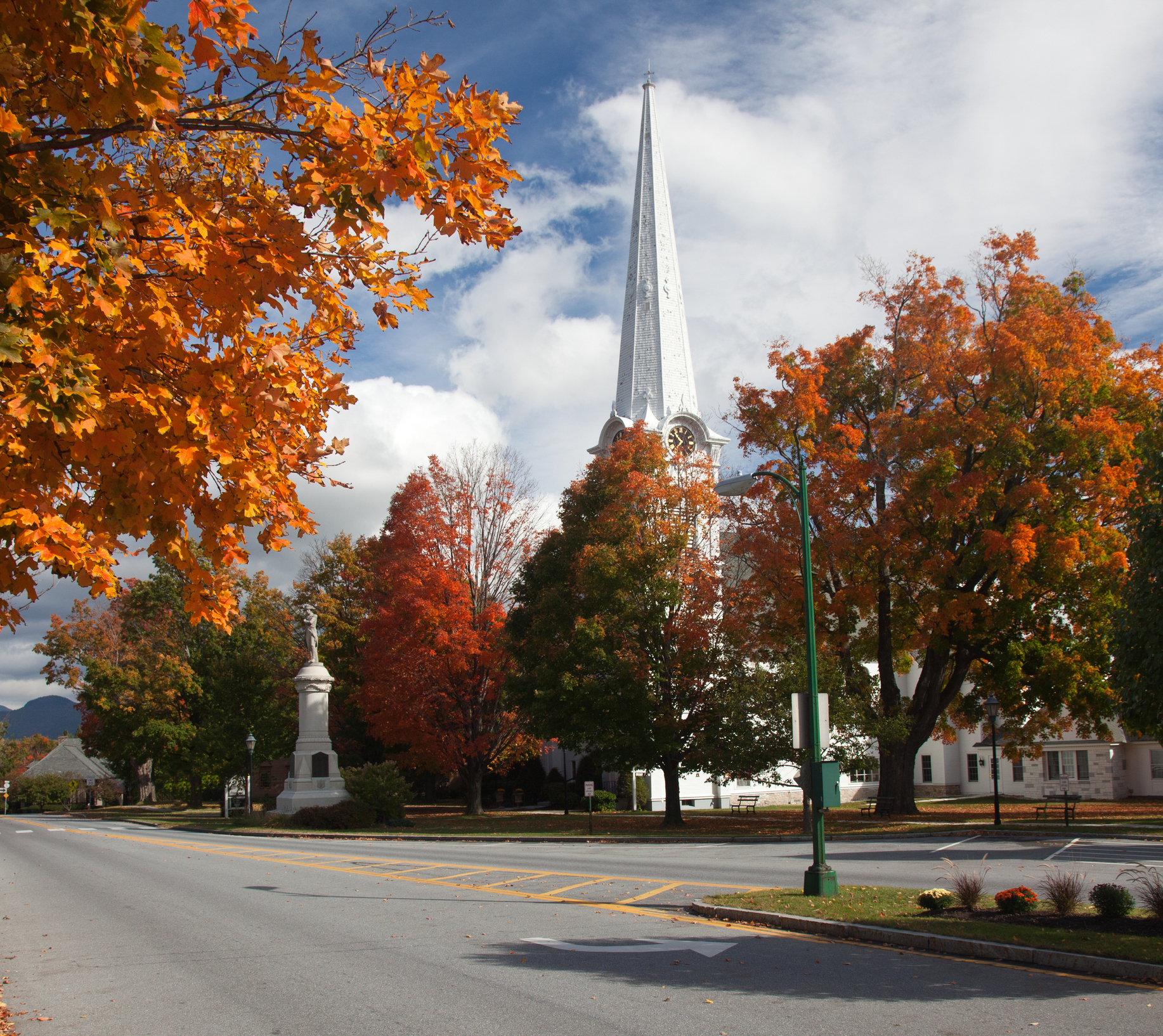
— u/HeatherAnne1975
13. "In Portuguese, gasolina means gas, and gasoleo means diesel. Despite the confusingly similar names, these two things are still not interchangeable. I learned this the hard way."
— u/c322617
14. "I missed a flight because I was eating a Big Mac. And my buddy just got on the plane without me."

— u/Gigahurt77
15. "I mixed up AM and PM for my flight time and showed up at the airport 12 hours late. Had to book a new one."
— u/dude341387
16. "I booked a flight to Santiago, Spain. Months later, when checking into my flight, I realized I had booked for Santiago, Chile. I repacked my bag and went to Chile six hours later with zero itinerary or reservations. I ended up in Patagonia and had an awesome trip."
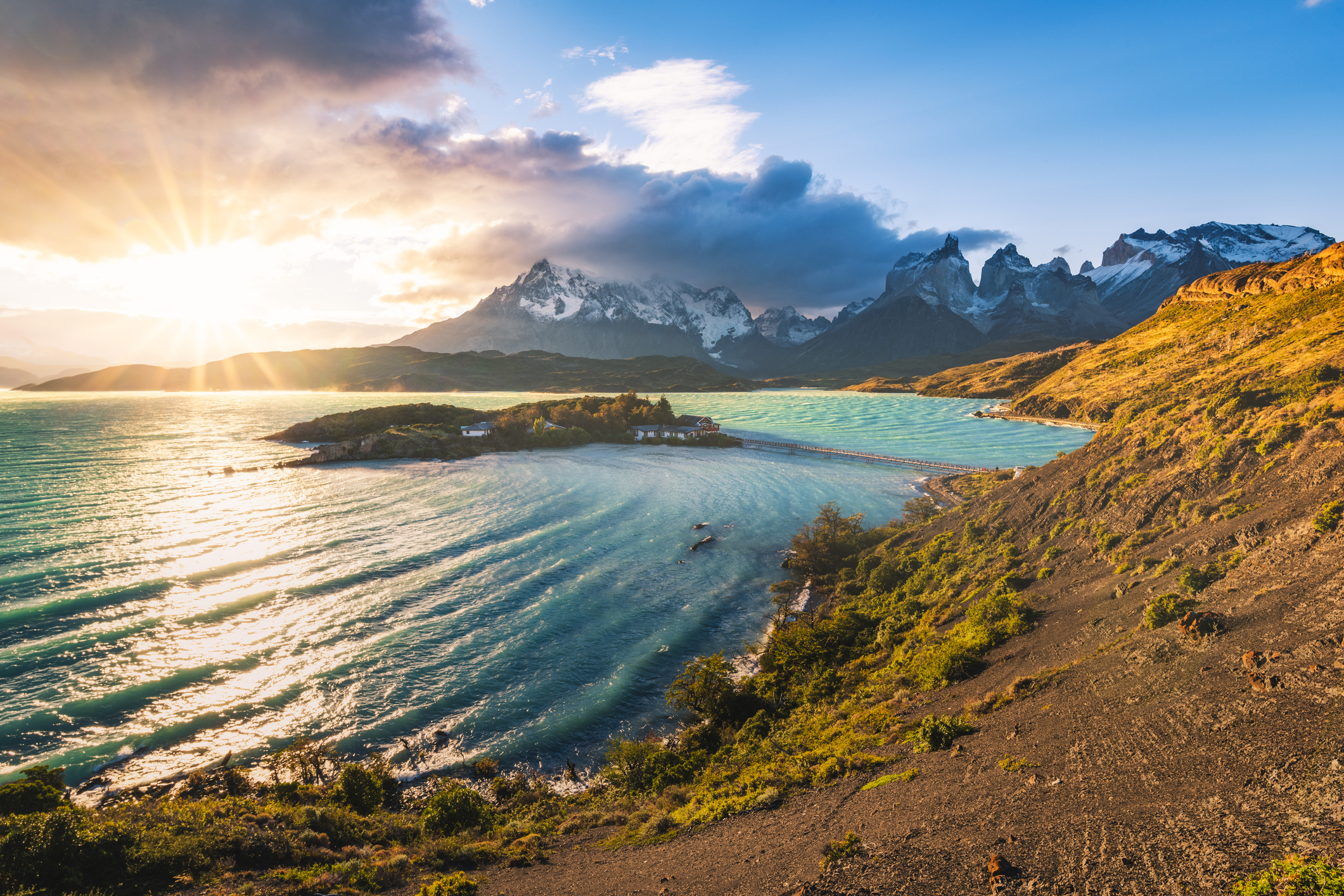
— u/AccidentalTourista
17. "My husband passed a kidney stone on the first night of our honeymoon."
— u/TinyBunny88
18. "Turns out SJC is NOT the airport code for San Jose, Costa Rica. Rather, it's San Jose, California. I figured this one out too late."

— u/Frodosear
19. "A hotel I was staying at gave me the key to someone else's room. When I opened the door, there was some random guy lying on the bed without a shirt on. We both sort of jumped. I slammed the door shut and walked away. I got a free (and vacant) room after that incident."
— u/DJAlaskaAndrew
20. "I traveled for over ten hours for a sold-out festival in Vegas. All major hotels were sold out because of it, and I realized I booked the hotel for 2024 instead of 2023."

— u/smolperson
So, what's a travel mishap you'll never forget and never live down? Tell us your story in the comments or drop it into the Google form.
Share this article.
Costa Rica Monkey Tours

20 Travel Hacks to make your Journey to Costa Rica Even Better
5. Binder clips are also great for wrapping your headphones

6. A pill container can be great for storing and sorting jewelry
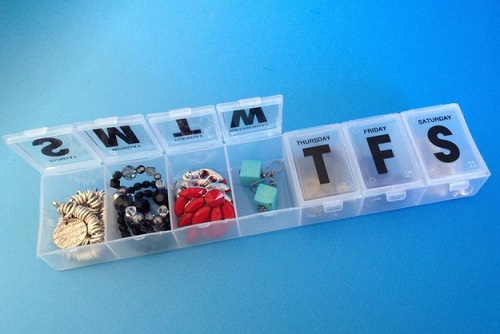
Social Share
Leave a reply cancel reply, travel guide.
- Costa Rica Tours
- Costa Rica Maps
- Costa Rica News
- Costa Rica Music
- Costa Rica Hotels
- Medical Tourism
- Costa Rica Sports
- Costa Rica Rafting
- Costa Rica Wildlife
- Costa Rica History
- Culture in Costa Rica
- Costa Rica Beaches
- Traveler Questions
- Costa Rica Airports
- Costa Rica Nightlife
- Costa Rica Location
- Costa Rica Weather
- Costa Rica Reserves
- Costa Rica Currency
- Costa Rica Shopping
- Costa Rica Museums
- Costa Rica Volcanoes
- Costa Rica Adventure
- Costa Rica Travel Tips
- Costa Rica Restaurants
- Costa Rica Destinations
- Costa Rica National Parks
- Things to do in Costa Rica
- Costa Rica Vacation Packages
Pages: 1 2 3 4 5 6 7 8 9 10
- Search Please fill out this field.
- Manage Your Subscription
- Give a Gift Subscription
- Sweepstakes
This Is the No. 1 Surf Destination in the World
Hossegor, located along the southwest coast of France, was just named the best destination to surf.
:max_bytes(150000):strip_icc():format(webp)/Stacey-Leasca-2000-631fabdcfe624115bea0ce8e25fdec96.jpg)
Vsevolod Vlasenko/Getty Images
The World Surf League's championship tour is well underway, bringing the best professional surfers to places like Australia, Brazil, southern California, and beyond to paddle and battle it out on some of the best breaks on Earth. And while you probably won't be getting out into the lineup with Kelly Slater, Carissa Moore, Griffin Colapinto, Tatiana Weston-Webb, or Gabriel Medina any time soon, they at least may have inspired you to want to go out and surf on your own. And the travel insurance experts at Confused.com have a few suggestions on where you should go.
The website released its list of the best surf destinations in the world, a study based on wave quality and surfer satisfaction via data from Surf-Forecast , and overall search interest via Google search data. After digging into all the numbers, the team named Hossegor, located along the southwest coast of France, the best destination to surf.
"Hossegor ranks as the best destination for surfing in the world, with an overall score of 8.16/10. Hossegor offers reliable, excellent conditions for surfing and is known for its hollow and fast-breaking waves favored by experienced surfers. It has an average surfer rating of 4.25, and 48 percent of the recorded waves are clean and surfable." The team also noted in the results that the best time to visit is during the region's fall shoulder season in October when flights and hotels are at their cheapest.
Hossegor was joined on the list by the legendary Mavericks, located just outside of Half Moon Bay, California, in second place, followed by Tofino, Canada, known for its year-round surf and fantastic wildlife spotting (seriously, watch out for whales here).
Rounding out the top 10 spots are The Bubble in the Canary Islands; Biarritz in France; Cloudbreak on Tavarua Island in Fiji; Carrapateira in Portugal; Ponta Preta in Maio, Cape Verde; Uluwatu and Kuta in Bali, Indonesia; Pasta Point in the Maldives; Puerto Escondido, in southern Oaxaca, Mexico; and Byron Bay in New South Wales, Australia.
While yes, this list is fantastic, it's chock full of spots that would easily be rated as expert-only. (Seriously, please do not paddle out to places like Mavericks or Cloud Break unless you really know what you're doing.) So we thought we'd give you three more suggestions for places to go surf if you consider yourself more of a beginner or beginner-intermediate, and asked our friends at The Inertia for their input. Here's what they (and we) suggest.
Waikiki, Hawaii
If you're going to learn to surf, you might as well do it in the birthplace of the sport — Hawaii. Waikiki is a prime destination, as it often offers soft, rolling waves in beautiful azure waters. Plenty of schools are ready to teach you all the ins and outs, including Kahu , which says 95 percent of its students stand up with one lesson. And, as a bonus, you can drive over to Pipeline and see the pros surf on some of the most pristine waves on Earth.
Nosara, Costa Rica
The tiny town of Nosara has become an ultra-popular destination for beach-goers, and for good reason. Not only is it stunning, but it also offers plenty of coastline for those who want to surf. Both Nosara Surf School and Nosara Surf Academy are great options and offer lessons for beginners, intermediates, and those looking to take things to the advanced level.
Cocoa Beach, Florida
Florida may not be the first place that comes to mind for surfing, but you absolutely should not overlook Cocoa Beach if you want to paddle out. Not only does it offer smooth waves, but it's also the hometown of surfing's greatest athlete, Kelly Slater. So really, you'll be surfing in the shadow of greats. Make a reservation with Cocoa Beach Surf School and get out in the water ASAP.
- Latin America
- Expat Living
- Art and Culture
- Science and Tech
- Classifieds
- Advertise with Us

COSTA RICA'S LEADING ENGLISH LANGUAGE NEWSPAPER
Costa Rica’s declining press freedom
The U.S. Department of State revealed that while the overall human rights situation in Costa Rica remained largely unchanged, there was an increase in attacks on media outlets and journalists by the government. President Chaves and former Minister of Health Jocelyn Chacón were found to have verbally attacked the media during a press conference, risking the promotion of harassment against the outlets and journalists named.
Several media outlets have expressed disapproval and concern over the President’s continuous harassment, with some even ceasing to attend press conferences due to safety concerns. The report also noted that Costa Rican journalists have admitted to self-censorship due to the administration’s public rebukes of critics. The report serves as a call to action for Costa Ricans to defend the value of a free press, a fundamental cornerstone of democracy.
Costa Rican Court upholds nutritional warning labels on food
Costa Rica has overturned a controversial decision by the Ministry of Health that required the concealment of warning nutritional labels on food products high in fat, sodium, and sugar. The Court ruled that hiding these labels violates consumers’ fundamental right to health and access to transparent information when purchasing food products.
The decision aligns with recommendations from the World Health Organization and the Food and Agriculture Organization of the United Nations, which emphasize the importance of clear and visible nutritional labels in enabling consumers to make healthier choices. Despite the Ministry’s justification based on national and Central American regulations, the Court prioritized the health and well-being of Costa Rican citizens, ensuring that they have direct access to informative nutritional labels.
Closing Darién to migrants is difficult
Costa Rican President Rodrigo Chaves expressed his doubts about the feasibility of closing the Darién jungle to migrants, as proposed by Panamanian presidential candidate José Raúl Mulino. Chaves emphasized the need for fair treatment and humanitarian assistance for migrants passing through the region. He also addressed the challenges faced by the new Guatemalan president, Bernardo Arévalo, and expressed his desire for a more prosperous and democratic Nicaragua.
Despite facing numerous complaints and accusations, Chaves remains determined to leave a valuable legacy in his remaining two years in office by promoting various reforms to combat bureaucracy, improve healthcare, and tackle organized crime and drug trafficking.
Today's Top News
A barrio’s pride: keylor navas’ humble beginnings, el salvador’s “war” on gangs successful, minister claims, costa rica’s businesses blame central bank for job losses, costa rica’s president: closing darién to migrants is difficult, costa rica’s water infrastructure fails to meet community needs, constitutional court upholds cocos island national park expansion, expat living: our many houses in costa rica, chaves suggests “lobbying” behind norway’s refusal to help, firefighters battle blaze in caño negro national wildlife refuge, the rise of brazilian funk: anitta, beyoncé, and beyond.


IMAGES
VIDEO
COMMENTS
Get travel insurance for your trip to Costa Rica. One of the best Costa Rica travel tips is to get travel insurance, especially if you are planning on any adventurous activities. With the right travel insurance, you will be financially protected in case of any unfortunate events, from simple inconveniences to medical emergencies.
Necessary Travel Documents For Costa Rica. ... She's a professional travel blogger and certified travel designer who loves planning trips, sharing travel hacks, and packing lists so that you don't have to. Owner of My Adventures Across The World, solo traveler, cat mom to Minnie. Claudia has been featured by the Lonely Planet and the Huffington ...
Travel Hacking to Costa Rica. May 5. Written By Nicole Elmore. Costa Rica is an eco- and adventure-tourism capital located in Central America, bordering Nicaragua to the north and Panama to the south with lush rain forests, a colorful wildlife, tropical beaches, and year-round great temperatures; a paradise for nature lovers that we were ...
Here are the top 6 Reasons you must visit Costa Rica & travel hacks to optimize your experience. 1. Reason: Happiest Place On Earth. According to the Happy Planet Index, Costa Rica ranks 1st out of 151 different countries based on measuring three different components: experienced well-being, life expectancy, & ecological footprint.
How much to budget in Costa Rica per Day. Budget traveler: If you are on a tight budget and watch your spending closely, $30 - $50 could be a sufficient budget. Mid-range traveler: If you want to have a few splurges and stay in nicer accommodation, plan to budget $75 - $100 per day.
Travel Vaccinations: Depending on your immune system but keep it handy all basic first-aid like mosquito repellent, drugs for diarrhea, fever or dizziness. Budget for a Trip to Costa Rica: Plan on spending a minimum of $125-$275 USD per day. Common language phrases: Pura Vida: "Pure life, Mae, Tuanis. Delicious Vegetarian Food: black bean ...
20 Travel Hacks to make your Journey to Costa Rica Even Better. Jun 11, 2015. 0 Comment. Juan Sancho. Traveling can be rough at times, but with these twenty travel tips you can smooth out your journey both to and at the beaches, cities, towns, rivers and mountains of Costa Rica. 1. Save space in your suitcase by rolling clothes instead of ...
Javier Echecopar is a co-founder of Journey Costa Rica, a travel company dedicated to creating high-end travel experiences in Costa Rica. He has over 15 years of experience in luxury adventure travel, including founding his own photography-focused travel company in Chile and 11 years working in multiple positions for Abercrombie & Kent.
Costa Rica At-a-Glance Here's a bite-sized snapshot of everything you need to know to plan your trip! When to Go: The ideal time is June & July, aka "green season," when prices are low and the rain takes a break. Where to Stay: Hostel Plinio near Manuel Antonio NP is an amazing, budget-friendly hostel. Aguila de Osa Rainforest Lodge near Corcovado NP is an incredible, sustainble eco ...
Tell us about the beaches, the birdwatching, the adventuring, the pros and cons of ecotourism, but also about the best urban neighborhoods, traffic hacks, and the best overlooked bars and restaurants.
This will be another useful travel tip you should know before visiting Costa Rica! Costa Rica uses two plug types; the A and B plug. Plug type A is the plug that has two flat parallel pins, and B is the plug that has the same pins and a grounding pin. Costa Rica operates on 120V supply voltage and 60Hz.
9. Uvita. Uvita is one of the best hidden gems in Costa Rica, offering a unique blend of pristine beaches, lush rainforests, and vibrant marine life. Located on the South Pacific coast, this town is best known for the Marino Ballena National Park and its iconic Whale's Tail Beach.
He also offers recommendations for food, unique lodging, the best ways to get around the country, and much more. Javier Echecopar is a co-founder of Journey Costa Rica, a travel company dedicated to creating high-end travel experiences in Costa Rica. He has over 15 years of experience in luxury adventure travel, including founding his own ...
1-866-853-9426. Click here to see a comprehensive Costa Rica packing checklist. Note that we are affiliated with Amazon and other companies, so many links on this page will take you to products that we have personally tried and recommend on the these websites as well as some that we are not affilliated with.
I have had tons of questions about our Costa Rica vacation budget, so I hope this helps answer some of them! Here are my best travel hacks for traveling on a...
Written by Nikki Solano. Nikki is the CEO of Pura Vida! eh?Inc. (Costa Rica Discounts), and the author of the guidebooks Moon Costa Rica (2019, 2021, 2023, and 2025 editions) and Moon Best of Costa Rica (2022 edition) from Moon Travel Guides.Together with her Costa Rican husband, Ricky, she operates the Costa Rica Travel Blog, created the online community DIY Costa Rica, built the Costa Rica ...
Read other Costa Rica travel tips below! Driving in Costa Rica. Best places in Costa Rica. 10 day Costa Rica itinerary. Costa Rica safety tips. Filed Under: About Costa Rica. Primary Sidebar. Hi! We are Yeison and Samantha Mytanfeet is the leading Costa Rica travel information website with detailed guides, local recommendations, photos, videos ...
Costa Rica Travel Guide: Travel Tips for Visiting. Costa Rica is a marvelous country with some of the largest concentrations of the Earth's biodiversity. When you visit Costa Rica, you are in for national parks, lush rainforests, cloud forests, gorgeous beaches, and active volcanoes. You will find it is a place you cannot visit just once ...
Costa Rica 10 Day Itinerary. Day 1: Fly in to Liberia - Rio Negro Hot Springs and Waterfalls. Day 2: Rincon de la Vieja National Park and Oropendola Waterfall. Day 3: Liberia to Monteverde - Monteverde Night Walk. Day 4: Monteverde - Zip-lining and Hanging Bridges.
phard003. • • Edited. Costa rica is not as cheap as it once was. There are beautiful places to explore but they will all cost you $$. If you want affordable, stay out of Tamarindo and any other extremely touristy parts of the country. Also, do not plan your trip with the idea of being able to rent a car right now.
Standard rooms were running ~ $3100 for a 6 night stay in March and April - so a 2.6¢/point value ($3,110/120,000 points) in pretty darn good. But I ended up using one of my four confirmed suite upgrades (perk of being a Globalist) to book us into an Andaz Suite which was much larger. Suites typically are double the cost of a standard room.
10+ Hacks to Upgrade Your Brain, Learn Faster and Become Limitless with Jim Kwik. #158: World-renowned brain coach Jim Kwik shares a wealth of hacks to unlock your brain's full potential. They discuss optimizing your brain diet, identifying your cognitive type, improving retention, mastering stress manage…. Feb. 17, 2024.
Travel Hacks; Budget Trips; ... In my defense, it was a really good book, and I was exhausted from a long travel day." ... Costa Rica. Rather, it's San Jose, California. I figured this one out too ...
After a series of bad events, Kema Ward-Hopper and Nicholas Hopper, abandoned life in Texas and moved to Costa Rica. Seven years later they're feeling the benefits.
Traveling can be rough at times, but with these twenty travel tips you can smooth out your journey both to and at the beaches, cities, towns, rivers and mountains of Costa Rica. Costa Rica Monkey Tours
"Hossegor ranks as the best destination for surfing in the world, with an overall score of 8.16/10. Hossegor offers reliable, excellent conditions for surfing and is known for its hollow and fast ...
Costa Rica's declining press freedom The U.S. Department of State revealed that while the overall human rights situation in Costa Rica remained largely unchanged, there was an increase in attacks on media outlets and journalists by the government. President Chaves and former Minister of Health Jocelyn Chacón were found to have verbally attacked the media […]